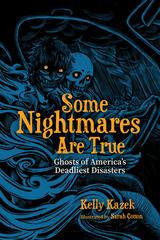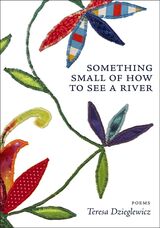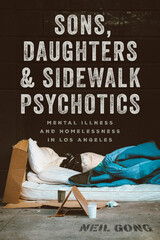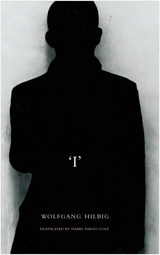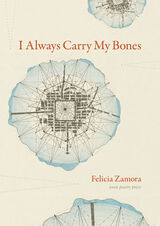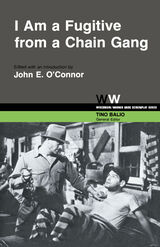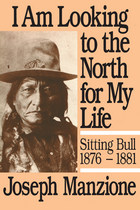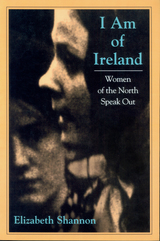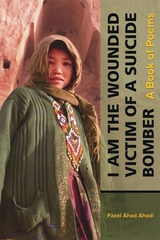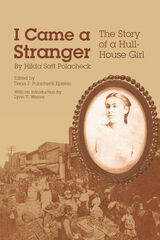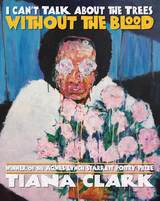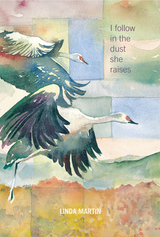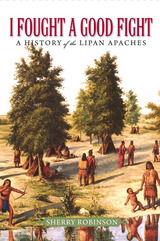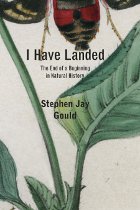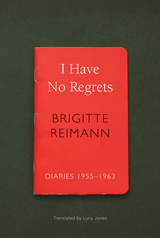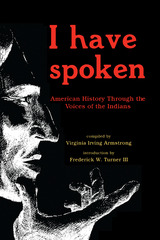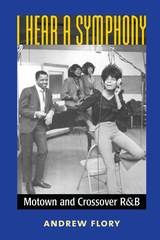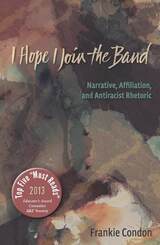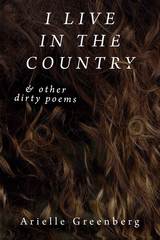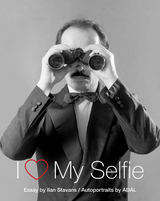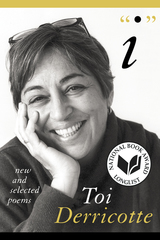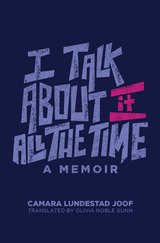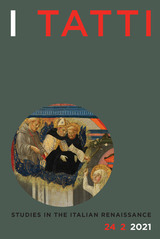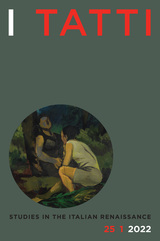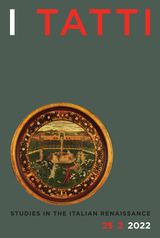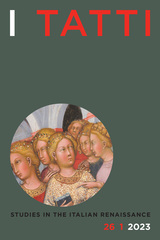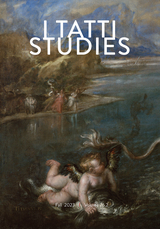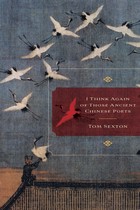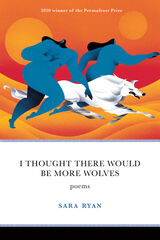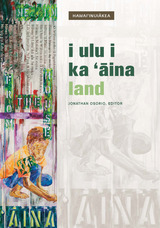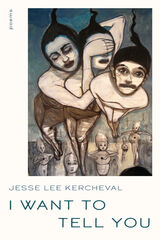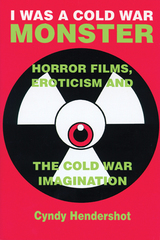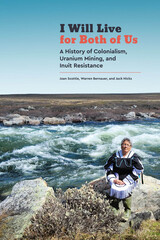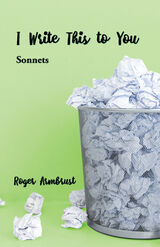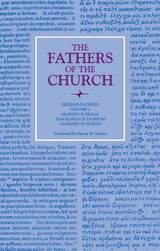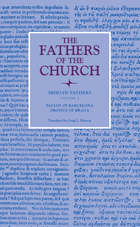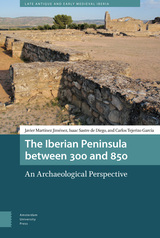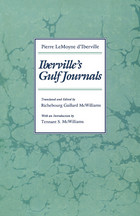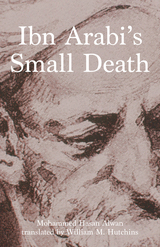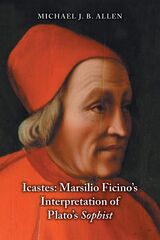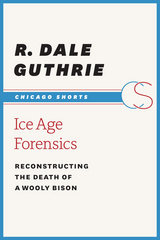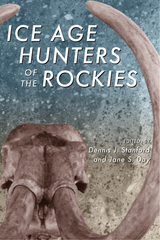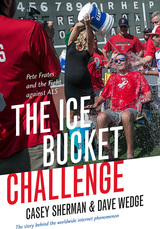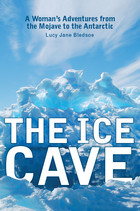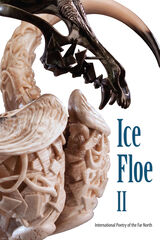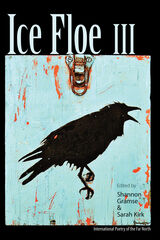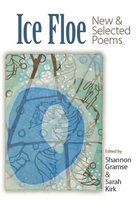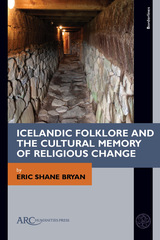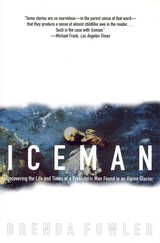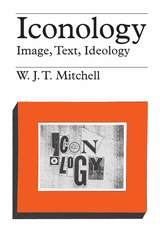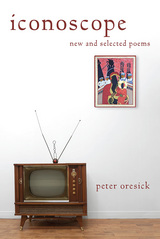'I'
Wolfgang Hilbig
Seagull Books, 2019 The perfect book for paranoid times, “I” introduces us to W, a mere hanger-on in East Berlin’s postmodern underground literary scene. All is not as it appears, though, as W is actually a Stasi informant who reports to the mercurial David Bowie look-alike Major Feuerbach. But are political secrets all that W is seeking in the underground labyrinth of Berlin? In fact, what W really desires are his own lost memories, the self undone by surveillance: his "I."
First published in Germany in 1993 and hailed as an instant classic, “I” is a black comedy about state power and the seductions of surveillance. Its penetrating vision seems especially relevant today in our world of cameras on every train, bus, and corner. This is an engrossing read, available now for the first time in English.
“[Hilbig writes as] Edgar Allan Poe could have written if he had been born in Communist East Germany.”—Los Angeles Review of Books
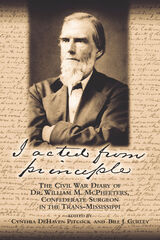 I Acted from Principle: The Civil War Diary of Dr. William M. McPheeters, Confederate Surgeon in the Trans-Mississippi
Cynthia DeHaven Pitcock
University of Arkansas Press, 2000 At the start of the Civil War, Dr. William McPheeters was a distinguished physician in St. Louis, conducting unprecedented public-health research, forging new medical standards, and organizing the state's first professional associations. But Missouri was a volatile border state. Under martial law, Union authorities kept close watch on known Confederate sympathizers. McPheeters was followed, arrested, threatened, and finally, in 1862, given an ultimatum: sign an oath of allegiance to the Union or go to federal prison. McPheeters "acted from principle" instead, fleeing by night to Confederate territory. He served as a surgeon under Gen. Sterling Price and his Missouri forces west of the Mississippi River, treating soldiers' diseases, malnutrition, and terrible battle wounds. From almost the moment of his departure, the doctor kept a diary. It was a pocket-size notebook which he made by folding sheets of pale blue writing paper in half and in which he wrote in miniature with his steel pen. It is the first known daily account by a Confederate medical officer in the Trans-Mississippi Department. It also tells his wife's story, which included harassment by Federal military officials, imprisonment in St. Louis, and banishment from Missouri with the couple's two small children. The journal appears here in its complete and original form, exactly as the doctor first wrote it, with the addition of the editors' full annotation and vivid introductions to each section.
 I Alone Have Escaped to Tell You: My Life and Pastimes
Ralph McInerny
University of Notre Dame Press, 2006
"Here is a memoir that is more than a chronicle of a full life lived within a Catholic intellectual milieu. With unique literary skills and the wisdom of seventy-five years, McInerny enlivens and interprets the major intellectual events of his time, delving into the past to understand the present. The result is the kind of book that future historians of culture will regard as a primary source. Modest and unassuming, McInerny fails to do justice to his own role in the intellectual life of the Church, a role as important as that of Chesterton and Belloc in a previous generation." --Jude P. Dougherty, Dean Emeritus, School of Philosophy, The Catholic University of America and Editor of the Review of Metaphysics
"I picked this book up during a spare hour—and hours later have scarcely been able to get back to anything else. This is a charming, bittersweet, witty, evocative, even romantic reminiscence of a wonderful life, teeming with children, penury, wild trips to Europe, sudden (and immense) success in writing (after many, many rejections), the love of a good woman—and her common sense, besides—and an incisive record of an amazing stretch of years from the Depression and World War II through Vatican Council II, and on into our own new century. Be prepared to weep a little, and laugh a little—it ought to be a movie. McInerny's masterpiece!" —Michael Novak, George Frederick Jewett Scholar, American Enterprise Institute
WithI Alone Have Escaped to Tell You, Ralph McInerny--distinguished scholar, mystery writer, editor, publisher, and family man--delivers a thoroughly engaging memoir. In the course of his recollections, McInerny describes his childhood in Minnesota; his grammar school and seminary education, with his decision to leave the path toward ordination; his marriage to his beloved Connie and their active family life and travels; and his life as a fiction writer. We learn of his career as a Catholic professor of philosophy at Notre Dame, his views on the Catholic Church, his experiences as an editor and publisher of Catholic magazines and reviews, his involvement with the International Catholic University, and his thoughts on other Catholic writers. Part homage to his academic home for the last half century and part appreciation of the many significant friendships he has fostered over his life, McInerny's reminiscences beautifully convey his lively interest in the world and his gift for friendship and collegiality.
Written in his characteristically elegant style, by turns charming, poignant, humorous, and revealing, I Along Have Escaped to Tell You will delight McInerny's many devoted readers.
I Always Carry My Bones
Felicia Zamora
University of Iowa Press, 2021 The poems in I Always Carry My Bones tackle the complex ideation of home—the place where horrid and beautiful intertwine and carve a being into existence—for marginalized and migrant peoples. Felicia Zamora explores how familial history echoes inside a person and the ghosts of lineage dwell in a body. Sometimes we haunt. Sometimes we are the haunted. Pierced by an estranged relationship to Mexican culture, the ethereal ache of an unknown father, the weight of racism and poverty in this country, the indentations of abuse, and a mind/physicality affected by doubt, these poems root in the search for belonging—a belonging inside and outside the flesh. This powerful collection is a message of longing for a sanctuary of self, the dwelling of initial energy needed for the collective fight for human rights.
I Am a Fugitive From a Chain Gang
Edited, with an introduction by John E. O'Connor; Tino T. Balio, Series Editor
University of Wisconsin Press, 1981 Since its release in 1932, I Am a Fugitive From a Chain Gang had earned a reputation as one of the few Hollywood products that can be associated directly with social change. Film historians attribute the reform of the southern chain gang system to the public outrage generated by this movie, which depicts a true story.
In addition to being an important social document, the film remains a gripping experience for filmgoers today because of its unusual dramatic conception, its hauntingly inconclusive ending, and Paul Muni's performance as the good boy forced to go wrong. This book includes the complete screenplay.
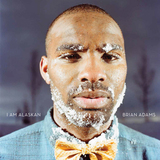 I Am Alaskan
Brian Adams
University of Alaska Press, 2013 What does an Alaskan look like? When asked to visualize someone from Alaska, the image most people conjure up is one of a face lost in a parka, surrounded by snow. Missing from this image is the vibrant diversity of those who call themselves Alaskans, as well as the true essence of the place. Brian Adams, a rising star in photography, aims to change all this with his captivating new collection, I Am Alaskan.
In this full-color tribute, Adams entices us to reconsider our ideas of this unique and compelling land and its equally individual residents. He captures subjects on urban streets and in rural villages, revealing what daily life in Alaska is really like. The portraits focus on moments both ordinary and extraordinary, serious and playful, while capturing Alaskans at their most natural. Subjects range from Alaska Native villagers to rarely seen portraits of famous Alaskans, including Sarah Palin, Vic Fischer, and Lance Mackey. Through photographs, Adams also explores his own half-Iñupiat, half–American Alaska identity in the process, revealing how he came to define himself and the state in which he lives. Frame by frame, Adams powerfully and honestly shows what it means to be an Alaskan.
 'I am an American': Filming the Fear of Difference
Cynthia Weber
Intellect Books, 2011 From Samuel Huntington’s highly controversial Who Are We? to the urgent appeal of Naomi Wolf’s The End of America, Americans are increasingly reflecting on questions of democracy, multiculturalism, and national identity. Yet such debates take place largely at the level of elites, leaving out ordinary American citizens, who have much to offer about the lived reality behind the phrase, “I am an American.” Cynthia Weber set out on a journey across post-9/11 America in search of a deeper understanding of what it means to be an American today. The result is this brave and captivating memoir that gives a voice to ordinary citizens for whom the terrorist attacks of 2001—and their lingering aftermath—live on in collective memory. Heartrending first-person testimonials reveal how the ongoing fear of terrorists and immigrants has betrayed America’s core values of fairness and equality, which have been further weakened by polarizing international and domestic responses. Considered together, these portraits also provide a sharp contrast to the idealized vision of Americanness frequently spun by media and politicians. Far more than a mere remembrance book about September 11, ‘I am an American’ offers precisely the kind of ground-level empathy needed to reignite a meaningful national debate about who we are and who we might become as a people and a nation.
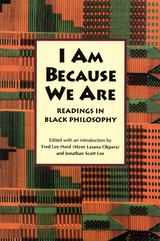 I Am Because We Are: Readings in Africana Philosophy
Fred Lee Hord
University of Massachusetts Press, 2016 First published in 1995, I Am Because We Are has been recognized as a major, canon-defining anthology and adopted as a text in a wide variety of college and university courses. Bringing together writings by prominent black thinkers from Africa, the Caribbean, and North America, Fred Lee Hord and Jonathan Scott Lee made the case for a tradition of "relational humanism" distinct from the philosophical preoccupations of the West.
Over the past twenty years, however, new scholarly research has uncovered other contributions to the discipline now generally known as "Africana philosophy" that were not included in the original volume. In this revised and expanded edition, Hord and Lee build on the strengths of the earlier anthology while enriching the selection of readings to bring the text into the twenty-first century. In a new introduction, the editors reflect on the key arguments of the book's central thesis, refining them in light of more recent philosophical discourse. This edition includes important new readings by Kwame Gyekye, Oyeronke Oy ewumi, Paget Henry, Sylvia Wynter, Toni Morrison, Charles Mills, and Tommy Curry, as well as extensive suggestions for further reading.
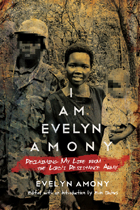 I Am Evelyn Amony: Reclaiming My Life from the Lord's Resistance Army
Evelyn Amony, Edited with an introduction by Erin Baines
University of Wisconsin Press, 2015 Abducted at the age of eleven, Evelyn Amony spent nearly eleven years inside the Lord’s Resistance Army, becoming a forced wife to Joseph Kony and mother to his children. She takes the reader into the inner circles of LRA commanders and reveals unprecedented personal and domestic details about Joseph Kony. Her account unflinchingly conveys the moral difficulties of choosing survival in a situation fraught with violence, threat, and death.
Amony was freed following her capture by the Ugandan military. Despite the trauma she endured with the LRA, Amony joined a Ugandan peace delegation to the LRA, trying to convince Kony to end the war that had lasted more than two decades. She recounts those experiences, as well as the stigma she and her children faced when she returned home as an adult.
This extraordinary testimony shatters stereotypes of war-affected women, revealing the complex ways that Amony navigated life inside the LRA and her current work as a human rights advocate to make a better life for her children and other women affected by war.
Best books for public & secondary school libraries from university presses, American Library Association
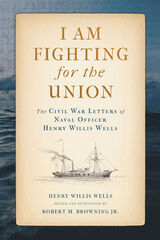 I Am Fighting for the Union: The Civil War Letters of Naval Officer Henry Willis Wells
Henry Willis Wells, edited and introduced by Robert M. Browning Jr.
University of Alabama Press, 2023 An insightful, detailed, and invaluable account of daily life in the Union Navy
On May 18, 1862, Henry Willis Wells wrote a letter to his mother telling her in clear terms, “I am fighting for the Union.” Since August 1861, when he joined the US Navy as a master’s mate he never wavered in his loyalty. He wrote to his family frequently that he considered military service a necessary and patriotic duty, and the career that ensued was a dramatic one, astutely and articulately documented by Wells in more than 200 letters home, leaving an invaluable account of daily life in the Union Navy.
Wells joined the navy shortly after the war began, initially on board the Cambridge, attached to the North Atlantic Blockading Squadron, which patrolled the waters of the Chesapeake Bay. He witnessed the Battle of Hampton Roads and the fight between the ironclads CSS Virginia and the USS Monitor. Next, the Cambridge assisted in the blockade of Wilmington, North Carolina. In one instance, the warship chased the schooner J. W. Pindar ashore during her attempt to run the blockade, and Confederate forces captured Henry’s boarding party. After a short prison stay in the infamous Libby Prison in Richmond, his Confederate captors paroled Henry. He travelled back to Brookline, and soon thereafter the Navy Department assigned him to the gunboat Ceres, which operated on the sounds and rivers of North Carolina, protecting army positions ashore. Henry was on board during the Confederate attempt to capture Washington, North Carolina. During this April 1863 attack, Henry was instrumental in the town’s defense, commanding a naval battery ashore during the latter part of the fight.
His exceptional service gained him a transfer to a larger warship, the USS Montgomery, again on the blockade of Wilmington. Later the service assigned him to the Gem of the Sea, part of the East Gulf Blockading Squadron. Through his hard work and professionalism, he finally earned his first command. In September 1864, he became the commanding officer of the Rosalie, a sloop used as a tender to the local warships. Later he commanded the schooner Annie, also a tender. At the end of December 1864, however, the Annie suffered a massive explosion, killing all hands, including Wells. He was twenty-three years old when his life and career ended tragically. Wells’s letters document both his considerable achievements and his frustrations. His challenges, triumphs, and disappointments are rendered with candor. I Am Fighting for the Union is a vital and deeply personal account of a momentous chapter in the history of the Civil War and its navies.
 I Am Here You Are Not I Love You: Andrew Topolski, Cindy Suffoletto, and Their Life in the Arts
Aidan Ryan
University of Iowa Press, 2025 Blending the emotional depth of memoir with the breadth of biography, I Am Here You Are Not I Love You attempts to piece together clues from the lives and art of Aidan Ryan’s late uncle and aunt, Andrew Topolski and Cindy Suffoletto.
The book presents a critical reexamination of Andrew Topolski, an overlooked luminary of intermedia and postminimalism. In repositioning Topolski’s legacy and vast body of work, Ryan makes compelling findings about the interplay of talent, luck, and community support in the making or breaking of artistic careers. At the same time, the story shares the significant and never-before-seen body of work by Cindy Suffoletto, a talented and inventive artist little shown and never cataloged during her short life. Ultimately, Ryan argues that the time is right for both to take up a privileged place among the great artists of their generation.
I Am Looking to the North for My Life: Sitting Bull 1876 - 1881
Joseph Manzione
University of Utah Press, 1991 What happened to the Sioux after Little Bighorn? In the winter of 1877, many escaped with Sitting Bull to Canada, precipitating an international incident and setting three governments at each other for five years. Resolution came only in 1881 with the demise of the buffalo herds in the Northwest Territories. Faced with starvation, the Sioux returned to the United States.
Relying upon primary source documents in both the United States and Canada, Manzione skillfully illustrates how two countries struggled to control a potentially explosive border situation while steadfastly looking the other way as a valiant culture came to its bitter fate.
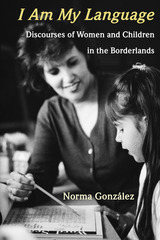 I Am My Language: Discourses of Women and Children in the Borderlands
Norma González
University of Arizona Press, 2001 “I am my language,” says the poet Gloria Anzaldúa, because language is at the heart of who we are. But what happens when a person has more than one language? Is there an overlay of language on identity, and do we shift identities as we shift languages? More important, what identities do children construct for themselves when they use different languages in particular ways? In this book, Norma González uses language as a window on the multiple levels of identity construction in children—as well as on the complexities of life in the borderlands—to explore language practices and discourse patterns of Mexican-origin mothers and the language socialization of their children. She shows how the unique discourses that result from the interplay of two cultures shape perceptions of self and community, and how they influence the ways in which children learn and families engage with their children’s schools. González demonstrates that the physical presence of the border profoundly affects the practices and ideologies of Mexican-origin women and children. She then argues that language and cultural background should be used as a basis for building academic competencies, and she demonstrates why the evocative/emotive dimension of language should play a major part in studies of discourse, language socialization, and language ideology. Drawing on women’s own narratives of their experiences as both mothers and borderland residents, I Am My Language is firmly rooted in the words of common people in their everyday lives. It combines personal odyssey with cutting-edge ethnographic research, allowing us to hear voices that have been muted in the academic and public policy discussions of “what it means to be Latina/o” and showing us new ways to connect language to complex issues of education, political economy, and social identity.
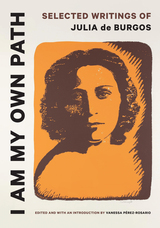 I Am My Own Path: Selected Writings of Julia de Burgos
Edited and with an introduction by Vanessa Pérez-Rosario
University of Texas Press, 2023 A definitive, bilingual selection of poetry, essays, and letters by one of Puerto Rico’s most beloved poets. Julia de Burgos (1914–1953) is best known for her poetry, but she is also an important cultural figure famous for her commitment to social justice, feminist ideas, and the independence of Puerto Rico. Admirers cultivated her legacy to bring to light the real Julia de Burgos, the woman behind the public figure, which this remarkable collection further illuminates by supplying a complex portrait using her own powerful and imaginative words. Beginning with a critical introduction to Burgos's life and work, Vanessa Pérez-Rosario then presents a selection of poems, essays, and letters, that offer a glimpse into this formidable talent and intellect. Burgos left Puerto Rico, spending the 1940s in both New York City and Havana, where she cultivated a new kind of identity refracted through her pathbreaking work as a poet and journalist. Both poetry and prose are alive with politically charged insights into the struggle of national liberation, literary creation, and being a woman in a patriarchal society. I Am My Own Path is essential reading for anyone interested in Puerto Rican literature and culture as well as a foundational text of Latinx literature and culture in the United States.
I Am of Ireland: Women of the North Speak Out
Elizabeth Shannon
University of Massachusetts Press, 1997 Available for the first time in paperback, this book provides an intimate look at the troubles in Northern Ireland. In a moving collection of interviews with Irish women, Elizabeth Shannon reveals them to be as diverse, charming, maddening, and contradictory as the country itself. This new edition, expanded and updated, contains follow-up interviews with many of the same Catholic and Protestant women who were featured in the original edition, as well as an analysis of the new women's political movement in Northern Ireland.
I Am the Wounded Victim of a Suicide Bomber
Fazel Ahad Ahadi, Pouneh Shabani-Jadidi, Patricia J. Higgins, and Nile Green
Harvard University Press I Am the Wounded Victim of a Suicide Bomber presents a selection of poems, translated into English and including the Perisan texts, by Fazel Ahad Ahadi, a scholar and poet driven from his home in Afghanistan by the political and social disruptions that have beset his country since the mid-twentieth century. Drawing heavily on these years of warfare and domination by outsiders and by extremists, this collection highlights the struggles of Afghans to keep alive their individual and collective identities along with the loneliness and cultural dislocation of exile—conditions experienced by too many the world over. While Ahadi’s poems can be joyful and hopeful, most evoke the pain of separation and isolation mixed with the determination to endure, persist, and resist.
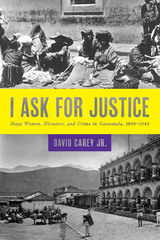 I Ask for Justice: Maya Women, Dictators, and Crime in Guatemala, 1898–1944
By David Carey Jr.
University of Texas Press, 2013 This study of the Guatemalan legal system during the regimes of two of Latin America’s most repressive dictators reveals the surprising extent to which Maya women used the courts to air their grievances and defend their human rights.
Winner, Bryce Wood Book Award, Latin American Studies Association, 2015 Given Guatemala’s record of human rights abuses, its legal system has often been portrayed as illegitimate and anemic. I Ask for Justice challenges that perception by demonstrating that even though the legal system was not always just, rural Guatemalans considered it a legitimate arbiter of their grievances and an important tool for advancing their agendas. As both a mirror and an instrument of the state, the judicial system simultaneously illuminates the limits of state rule and the state’s ability to co-opt Guatemalans by hearing their voices in court. Against the backdrop of two of Latin America’s most oppressive regimes—the dictatorships of Manuel Estrada Cabrera (1898–1920) and General Jorge Ubico (1931–1944)—David Carey Jr. explores the ways in which indigenous people, women, and the poor used Guatemala’s legal system to manipulate the boundaries between legality and criminality. Using court records that are surprisingly rich in Maya women’s voices, he analyzes how bootleggers, cross-dressers, and other litigants crafted their narratives to defend their human rights. Revealing how nuances of power, gender, ethnicity, class, and morality were constructed and contested, this history of crime and criminality demonstrates how Maya men and women attempted to improve their socioeconomic positions and to press for their rights with strategies that ranged from the pursuit of illicit activities to the deployment of the legal system.
 I Believe I'll Go Back Home: Roots and Revival in New England Folk Music
Thomas S. Curren
University of Massachusetts Press, 2021 Between 1959 and 1968, New England saw a folk revival emerge in more than fifty clubs and coffeehouses, a revolution led by college dropouts, young bohemians, and lovers of traditional music that renewed the work of the region's intellectuals and reformers. From Club 47 in Harvard Square to candlelit venues in Ipswich, Martha's Vineyard, and Amherst, budding musicians and hopeful audiences alike embraced folk music, progressive ideals, and community as alternatives to an increasingly toxic consumer culture. While the Boston-Cambridge Folk Revival was short-lived, the youthful attention that it spurred played a crucial role in the civil rights, world peace, and back-to-the-land movements emerging across the country.
Fueled by interviews with key players from the folk music scene, I Believe I'll Go Back Home traces a direct line from Yankee revolutionaries, up-country dancers, and nineteenth-century pacifists to the emergence of blues and rock 'n' roll, ultimately landing at the period of the folk revival. Thomas S. Curren presents the richness and diversity of the New England folk tradition, which continues to provide perspective, inspiration, and healing in the present day.
 I Belong to This Band, Hallelujah!: Community, Spirituality, and Tradition among Sacred Harp Singers
Laura Clawson
University of Chicago Press, 2011 The Sacred Harp choral singing tradition originated in the American South in the mid-nineteenth century, spread widely across the country, and continues to thrive today. Sacred Harp isn’t performed but participated in, ideally in large gatherings where, as the a cappella singers face each other around a hollow square, the massed voices take on a moving and almost physical power. I Belong to This Band, Hallelujah! is a vivid portrait of several Sacred Harp groups and an insightful exploration of how they manage to maintain a sense of community despite their members’ often profound differences.
Laura Clawson’s research took her to Alabama and Georgia, to Chicago and Minneapolis, and to Hollywood for a Sacred Harp performance at the Academy Awards, a potent symbol of the conflicting forces at play in the twenty-first-century incarnation of this old genre. Clawson finds that in order for Sacred Harp singers to maintain the bond forged by their love of music, they must grapple with a host of difficult issues, including how to maintain the authenticity of their tradition and how to carefully negotiate the tensions created by their disparate cultural, religious, and political beliefs.
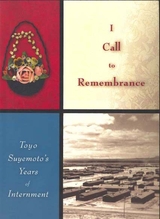 I Call to Remembrance: Toyo Suyemoto's Years of Internment
Toyo Suyemoto and Edited by Susan B. Richardson
Rutgers University Press, 2007 Toyo Suyemoto is known informally by literary scholars and the media as "Japanese America's poet laureate." But Suyemoto has always described herself in much more humble terms. A first-generation Japanese American, she has identified herself as a storyteller, a teacher, a mother whose only child died from illness, and an internment camp survivor. Before Suyemoto passed away in 2003, she wrote a moving and illuminating memoir of her internment camp experiences with her family and infant son at Tanforan Race Track and, later, at the Topaz Relocation Center in Utah, from 1942 to 1945. A uniquely poetic contribution to the small body of internment memoirs, Suyemoto's account includes information about policies and wartime decisions that are not widely known, and recounts in detail the way in which internees adjusted their notions of selfhood and citizenship, lending insight to the complicated and controversial questions of citizenship, accountability, and resistance of first- and second-generation Japanese Americans. Suyemoto's poems, many written during internment, are interwoven throughout the text and serve as counterpoints to the contextualizing narrative. Suyemoto's poems, many written during internment, are interwoven throughout the text and serve as counterpoints to the contextualizing narrative. A small collection of poems written in the years following her incarceration further reveal the psychological effects of her experience.
I Came a Stranger: The Story of a Hull-House Girl
Hilda Satt Polacheck
University of Illinois Press, 1989 Hilda Satt Polacheck's family emigrated from Poland to Chicago in 1892, bringing their old-world Jewish traditions with them into the Industrial Age. Throughout her career as a writer and activist, Polacheck never forgot the immigrant neighborhoods, markets, and scents and sounds of Chicago's West Side. In charming and colorful prose, Polacheck recounts her introduction to American life and the Hull-House community; her chance meeting with Jane Addams and their subsequent long friendship and working relationship; her marriage; her support of civil rights and women's suffrage; her work with the Women's International League for Peace and Freedom; and her experiences as a writer for the Works Progress Administration.
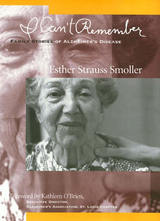 I Can't Remember: Family Stories of Alzheimer's Disease
Esther Strauss Smoller
Temple University Press, 1997 I Can't Remember is an intimate photo essay of four families and their process of coping with Alzheimer's disease -- a process of coming to terms with the practical and emotional consequences of a disease that changes the entire family dynamic. Family members tell their stories of first denying that their loved one cold be suffering from Alzheimer's, then dealing with the changing relationships among family members and the intensifying emotions, as old family troubles are stirred up and new feelings of despair and love appear.
Photographs and personal narratives are woven together to show both the unpleasant and the beautiful sides of the struggle for connection between spouses and across generations. Smoller has a gift for capturing people as they interact, whether it's arguing around the kitchen table or dancing cheek to cheek.
Each family's story is different, but all four families share common pain and frustration. A highway patrolman who has early onset Alzheimer's describes what it is like to have Alzheimer's. His wife tells a parallel story of life together after hearing the diagnosis. A daughter gives the following account of her mother: "I though that it would be helpful if mother spent time in my home in Colorado. Before this visit, I was in denial, convinced that she suffered from depression and not Alzheimer's disease. ... On the plane trip to Colorado, I was brought into the stark, cold reality that Mom had Alzheimer's. She did not know where she was or where she was going. Upon arrival, she did not recognize my home, although she had visited me numerous times in the past. She tried sleeping in the bathtub the first night."
Another daughter relates that she was unaware of the onset of Alzheimer's in her mother, because her mother was such a "wonderful actress." Eventually the memory problems were no longer confined to where things belonged in the kitchen, but extended into driving off at random, driving in circles in a parking lot in the middle of the night or as much as 75 miles away from home.
I Can't Remember gives an intimate glimpse into the hearts and minds of caregivers and patients. Supportive social networks are essential for healthy life. This book provides the impetus caregivers need to develop contacts that can provide support. Smoller offers a glimpse of the frustration and losses faced by those who deal with Alzheimer's, as well as the potential to transcend those losses -- even is only for a time -- through love and hope.
I Can't Talk About the Trees Without the Blood
Tiana Clark
University of Pittsburgh Press, 2018
Winner, 2020 Kate Tufts Discovery Award
For prize-winning poet Tiana Clark, trees will never be just trees. They will also and always be a row of gallows from which Black bodies once swung. This is an image that she cannot escape, but one that she has learned to lean into as she delves into personal and public histories, explicating memories and muses around race, elegy, family, and faith by making and breaking forms as well as probing mythology, literary history, her own ancestry, and, yes, even Rihanna. I Can’t Talk About the Trees without the Blood, because Tiana cannot engage with the physical and psychic landscape of the South without seeing the braided trauma of the broken past—she will always see blood on the leaves.
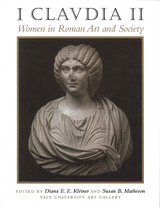 I Claudia II: Women in Roman Art and Society
Edited by Diana E. E. Kleiner and Susan B. Matheson
University of Texas Press, 2000 I, Claudia: Women in Ancient Rome—an exhibition and catalog produced by the Yale University Art Gallery—provided the first comprehensive study of the lives of Roman women as revealed in Roman art. Responding to the popular success of the exhibit and catalog, Diana E. E. Kleiner and Susan B. Matheson here gather ten additional essays by specialists in art history, history, and papyrology to offer further reflections on women in Roman society based on the material evidence provided by art, archaeology, and ancient literary sources. In addition to the editors, the contributors are Cornelius C. Vermeule, Rolf Winkes, Mary T. Boatwright, Susan Wood, Eve D'Ambra, Andrew Oliver, Diana Delia, and Ann Ellis Hanson. Their essays, illustrated with black-and-white photos of the art under discussion, treat such themes as mothers and sons, marriage and widowhood, aging, adornment, imperial portraiture, and patronage.
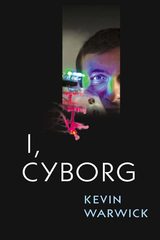 I, Cyborg
Kevin Warwick
University of Illinois Press, 2002 Now available for the first time in America, I, Cyborg is the story of Kevin Warwick, the cybernetic pioneer advancing science by upgrading his own body.
Warwick, the world's leading expert in cybernetics, explains how he has deliberately crossed over a perilous threshold to take the first practical steps toward becoming a cyborg--part human, part machine--using himself as a guinea pig and undergoing surgery to receive technological implants connected to his central nervous system.
Believing that machines with intelligence far beyond that of humans will eventually make the important decisions, Warwick investigates whether we can avoid obsolescence by using technology to improve on our comparatively limited capabilities. Warwick also discusses the implications for human relationships, and his wife's participation in the experiments.
Beyond the autobiography of a scientist who became, in part, a machine, I, Cyborg is also a story of courage, devotion, and endeavor that split apart personal lives. The results of these amazing experiments have far-reaching implications not only for e-medicine, extra-sensory input, increased memory and knowledge, and even telepathy, but for the future of humanity as well.
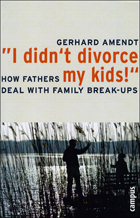 "I Didn't Divorce My Kids!": How Fathers Deal With Family Break-ups
Gerhard Amendt
Campus Verlag, 2008 Popular culture often portrays divorced fathers as deadbeats who have little interest in caring for the emotional, physical, and financial needs of their children. In the stereotype-shattering book, “I Didn’t Divorce My Kids!”, Gerhard Amendt presents the long-neglected plight of the divorced father who is plagued by grief and loneliness after being separated from his children. Based on surveys and in-depth interviews of thousands of such dads, Amendt reveals how fathers cope with trying to salvage their own lives while simultaneously maintaining relationships with their children after a painful divorce.
Amendt’s incisive look at divided families also explores the impact that a single-parent household has on children’s well-being, criticizing the American tendency to over-pathologize normal reactions to familial upheaval. Even the most civilized of divorces, Amendt argues, can cause rage, sadness, potential health problems, and behavioral disturbances in otherwise well-adjusted children. The broad spectrum of experiences recounted in “I Didn’t Divorce My Kids!” will be essential reading for anyone interested in, or personally shaped by, the changing face of the modern family.
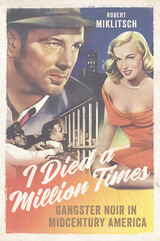 I Died a Million Times: Gangster Noir in Midcentury America
Robert Miklitsch
University of Illinois Press, 2020 In the 1950s, the gangster movie and film noir crisscrossed to create gangster noir. Robert Miklitsch takes readers into this fascinating subgenre of films focused on crime syndicates, crooked cops, and capers.
With the Senate's organized crime hearings and the brighter-than-bright myth of the American Dream as a backdrop, Miklitsch examines the style and history, and the production and cultural politics, of classic pictures from The Big Heat and The Asphalt Jungle to lesser-known gems like 711 Ocean Drive and post-Fifties movies like Ocean’s Eleven. Miklitsch pays particular attention to trademark leitmotifs including the individual versus the collective, the family as a locus of dissension and rapport, the real-world roots of the heist picture, and the syndicate as an octopus with its tentacles deep into law enforcement, corporate America, and government. If the memes of gangster noir remain prototypically dark, the look of the films becomes lighter and flatter, reflecting the influence of television and the realization that, under the cover of respectability, crime had moved from the underworld into the mainstream of contemporary everyday life.
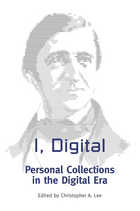 I, Digital: Personal Collections in the Digital Era
Christopher A. Lee
Society of American Archivists, 2011 When it comes to personal collections, we live in exciting times. Individuals are living their lives in ways that are increasingly mediated by digital technologies — digital photos and video footage, music, the social web, e-mail,and other day-to-day interactions. Although this mediation presents many technical challenges for long-term preservation, it also provides unprecedented opportunities for documenting the lives of individuals. Ten authors — Robert Capra, Adrian Cunningham, Tom Hyry, Leslie Johnston, Christopher (Cal) Lee, Sue McKemmish, Cathy Marshall, Rachel Onuf, Kristina Spurgin, and Susan Thomas — share their expertise on the various aspects of the management of digital information in I, Digital: Personal Collections in the Digital Era. The volume is divided in three parts: Part 1 is devoted to conceptual foundations and motivations.Part 2 focuses on particular types, genres, and forms of personal traces; areas of further study; and new opportunities for appraisal and collection.Part 3 addresses strategies and practices of professionals who work in memory institutions. Chapters explore issues,challenges, and opportunities in the management of personal digital collections, focusing primarily on born-digital materials generated and kept by individuals. Contributions to I, Digital represent the depth in thinking about how cultural institutions can grapple with new forms of documentation, and how individuals manage--and could better manage--digital information that is part of contemporary life.
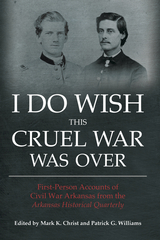 I Do Wish This Cruel War Was Over: First-Person Accounts of Civil War Arkansas from the Arkansas Historical Quarterly
Mark K. Christ
University of Arkansas Press, 2014 I Do Wish this Cruel War Was Over collects diaries, letters, and memoirs excerpted from their original publication in the Arkansas Historical Quarterly to offer a first-hand, ground-level view of the war's horrors, its mundane hardships, its pitched battles and languid stretches, even its moments of frivolity. Readers will find varying degrees of commitment and different motivations among soldiers on both sides, along with the perspective of civilians. In many cases, these documents address aspects of the war that would become objects of scholarly and popular fascination only years after their initial appearance: the guerrilla conflict that became the "real war" west of the Mississippi; the "hard war" waged against civilians long before William Tecumseh Sherman set foot in Georgia; the work of women in maintaining households in the absence of men; and the complexities of emancipation, which saw African Americans winning freedom and sometimes losing it all over again. Altogether, these first-person accounts provide an immediacy and a visceral understanding of what it meant to survive the Civil War in Arkansas.
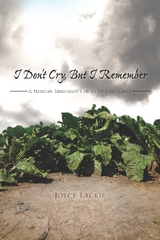 I Don't Cry, But I Remember: A Mexican Immigrant's Story of Endurance
Joyce Lackie
University of Arizona Press, 2012 When Viviana Salguero came to the United States in 1946, she spoke very little English, had never learned to read or write, and had no job skills besides housework or field labor. She worked eighteen-hour days and lived outdoors as often as not. And yet she raised twelve children, shielding them from her abusive husband when she dared, and shared in both the tragedies and accomplishments of her family. Through it all, Viviana never lost her love for Mexico or her gratitude to the United States for what would eventually become a better life. Though her story is unique, Viviana Salguero could be the mother, grandmother, or great-grandmother of immigrants anywhere, struggling with barriers of gender, education, language, and poverty.
In I Don't Cry, But I Remember, Joyce Lackie shares with us an intimate portrait of Viviana's life. Based on hours of recorded conversations, Lackie skillfully translates the interviews into an engaging, revealing narrative that details the migrant experience from a woman's point of view and fills a gap in our history by examining the role of women of color in the American Southwest. The book presents Vivana's life not only as a chronicle of endurance, but as a tale of everyday resistance. What she lacks in social confidence, political strength, and economic stability, she makes up for in dignity, faith, and wisdom.
Like all good oral history, Salguero's accounts and Lackie's analyses contribute to our understanding of the past by exposing the inconsistencies and contradictions in our remembrances. This book will appeal to ethnographers, oral historians, students and scholars of Chicana studies and women's studies, as well as general readers interested in the lives of immigrant women.
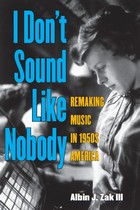 I Don't Sound Like Nobody: Remaking Music in 1950s America
Albin J. Zak III
University of Michigan Press, 2012 "In Albin J. Zak III's highly original study, phonograph records are not just the medium for disseminating songs but musical works unto themselves. Fashioned from a mix of copyright law, recording studios and techniques, the talent of musicians and disc jockeys, the ingenuity and avarice of producers, and the appetites of record buyers, the all-powerful marketplace Zak describes is an unruly zone where music of, by, and for the people is made and anointed."
---Richard Crawford, author of America's Musical Life: A History "Wrestling clarity from the exuberant chaos of early rock 'n' roll, Albin Zak's I Don't Sound Like Nobody redefines our understanding of the record in the shaping of the post–World War II soundscape. Zak tracks the story which extends from Bing Crosby and Frank Sinatra through Elvis and Buddy Holly to the Beatles and Bob Dylan with excursions into dozens of lesser known, but crucial, players in a game with few established rules. A crucial addition to the bookshelf."
---Craig Werner, author of A Change Is Gonna Come: Music, Race & the Soul of America "I Don't Sound Like Nobody is a superb account of the transformation of American popular music in the 1950s. Albin Zak insightfully explores what recording actually means in terms of the process of making and consuming music. His discussion of the legal, aesthetic, and industrial ramifications of changes in the recording process over the course of the 1950s will make popular music scholars and record collectors reconsider what they think they know about the period."
---Rob Bowman, author of Soulsville, U.S.A.: The Story of Stax Records "Informative, original, and entertaining. Through a narrative that is not only enlightening but also compelling, I Don't Sound Like Nobody probes the sources and mechanisms of change within post-war American popular music, shedding a cultural and historical light on the convergence of musical idioms that created '50s rock and roll."
---Stan Hawkins, author of Settling the Pop Score "From the birth of the record industry through the legacy of Presley, the development of rock and roll, and the Beatles 'stunning arrival on the world's stage,' Albin Zak takes us on a journey of exceptional scholarship. The breadth of coverage and deep examination of recordings and repertoire reveal the author's reverence and sensitivity to the many dimensions and origins of this complex musical soundscape."
---William Moylan, author of Understanding and Crafting the Mix: The Art of Recording The 1950s marked a radical transformation in American popular music as the nation drifted away from its love affair with big band swing to embrace the unschooled and unruly new sounds of rock 'n' roll. The sudden flood of records from the margins of the music industry left impressions on the pop soundscape that would eventually reshape long-established listening habits and expectations, as well as conventions of songwriting, performance, and recording. When Elvis Presley claimed, "I don't sound like nobody," a year before he made his first commercial record, he unwittingly articulated the era's musical Zeitgeist. The central story line of I Don't Sound Like Nobody is change itself. The book's characters include not just performers but engineers, producers, songwriters, label owners, radio personalities, and fans---all of them key players in the decade's musical transformation. Written in engaging, accessible prose, Albin Zak's I Don't Sound Like Nobody approaches musical and historical issues of the 1950s through the lens of recordings and fashions a compelling story of the birth of a new musical language. The book belongs on the shelf of every modern music aficionado and every scholar of rock 'n' roll. Albin J. Zak III is Professor of Music at the University at Albany, State University of New York. He is the editor of The Velvet Underground Companion and the author of The Poetics of Rock: Cutting Tracks, Making Records, a groundbreaking study of rock music production. Zak is also a record producer, songwriter, singer, and guitarist. Jacket design by Paula Newcomb Jacket photograph © Eve Arnold/Magnum Photos
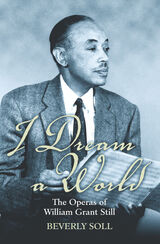 I Dream a World: The Operas of William Grant Still
Beverly Soll
University of Arkansas Press, 2005 William Grant Still (1895–1978) dreamed of a world in which his eight operas—for him the ultimate form of musical expression—would be heard in the major opera houses in the United States, devoting most of his career toward the pursuit of this goal. The first part of I Dream a World creates a context for Still’s operas and explores commonalities among them, including structural elements and musical characteristics. The second part traces the research, composition, and perform-ances of the operas as a way of documenting the history of the composer and his contributions to American opera. Although I Dream a World is not intentionally biographical, it is very pers-onal. It is more than the story of William Grant Still’s love of operatic music, of the libretti that reflect his own life and philosophy, and of the world he dreamed through his work. It opens a window on Still the man as well as on Still the composer that offers important insights into the social milieu of this pioneering figure.
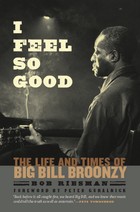 I Feel So Good: The Life and Times of Big Bill Broonzy
Bob Riesman
University of Chicago Press, 2011 A major figure in American blues and folk music, Big Bill Broonzy (1903–1958) left his Arkansas Delta home after World War I, headed north, and became the leading Chicago bluesman of the 1930s. His success came as he fused traditional rural blues with the electrified sound that was beginning to emerge in Chicago. This, however, was just one step in his remarkable journey: Big Bill was constantly reinventing himself, both in reality and in his retellings of it. Bob Riesman’s groundbreaking biography tells the compelling life story of a lost figure from the annals of music history.
I Feel So Good traces Big Bill’s career from his rise as a nationally prominent blues star, including his historic 1938 appearance at Carnegie Hall, to his influential role in the post-World War II folk revival, when he sang about racial injustice alongside Pete Seeger and Studs Terkel. Riesman’s account brings the reader into the jazz clubs and concert halls of Europe, as Big Bill's overseas tours in the 1950s ignited the British blues-rock explosion of the 1960s. Interviews with Eric Clapton, Pete Townshend, and Ray Davies reveal Broonzy’s profound impact on the British rockers who would follow him and change the course of popular music.
Along the way, Riesman details Big Bill’s complicated and poignant personal saga: he was married three times and became a father at the very end of his life to a child half a world away. He also brings to light Big Bill’s final years, when he first lost his voice, then his life, to cancer, just as his international reputation was reaching its peak. Featuring many rarely seen photos, I Feel So Good will be the definitive account of Big Bill Broonzy’s life and music.
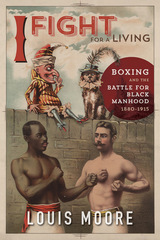 I Fight for a Living: Boxing and the Battle for Black Manhood, 1880-1915
Louis Moore
University of Illinois Press, 2017 The black prizefighter labored in one of the few trades where an African American man could win renown: boxing. His prowess in the ring asserted an independence and powerful masculinity rare for black men in a white-dominated society, allowing him to be a man--and thus truly free. Louis Moore draws on the life stories of African American fighters active from 1880 to 1915 to explore working-class black manhood. As he details, boxers bought into American ideas about masculinity and free enterprise to prove their equality while using their bodies to become self-made men. The African American middle class, meanwhile, grappled with an expression of public black maleness they saw related to disreputable leisure rather than respectable labor. Moore shows how each fighter conformed to middle-class ideas of masculinity based on his own judgment of what culture would accept. Finally, he argues that African American success in the ring shattered the myth of black inferiority despite media and government efforts to defend white privilege.
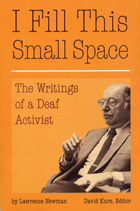 I Fill This Small Space: The Writings of a Deaf Activist
Lawrence Newman
Gallaudet University Press, 2009 Lawrence Newman became deaf at the age of five in 1930, and saw his father fight back tears knowing that his son would never hear again. The next time he saw his father cry was in 1978, when Newman received an honorary doctorate from Gallaudet University, his alma mater. Newman was recognized for his achievements as a life-long advocate for deaf education, including receiving California’s Teacher of the Year award in 1968. Perhaps his greatest influence, however, stemmed from his many articles and columns that appeared in various publications, the best of which are featured in I Fill This Small Space: The Writings of a Deaf Activist.
Editor David Kurs has organized Newman’s writings around his passions — deaf education, communication and language, miscellaneous columns and poems on Deaf life, and humorous insights on his activism. His articles excel both as seamless arguments supporting his positions and as windows on the historical conflicts that he fought: against the Least Restrictive Environment in favor of residential deaf schools; for sign language, Total Communication, and bilingual education; and as a deaf teacher addressing parents of deaf children. A gifted writer in all genres, Newman amuses with ease (“On Mini and Midi-Skirts”), and moves readers with his heartfelt verse (“Girl with a Whirligig”). Newman ranges wide in his ability, but he always maintains his focus on equal tights for deaf people, as he demonstrates in his title poem “I Fill This Small Space:”
I fill this small space, this time
Who is to say yours is better
Than mine or mine yours
I Follow in the Dust She Raises
Linda Martin
University of Alaska Press, 2015 I Follow in the Dust She Raises is a collection of deeply personal poems born from a life sharply observed. Martin takes readers from the mountains of the West to the shores of Alaska, as she delves into the rippling depth of childhood experiences, tracks the moments that change a life, and settles into the fine grooves of age. Exploring the ties of family and grief, Martin’s unflinching poetry ripples with moments of extraordinary beauty plucked from what seem like ordinary lives.
 The I. G. in Peking: Letters of Robert Hart, Chinese Maritime Customs, 1868–1907
Robert Hart
Harvard University Press, 1975 Robert Hart’s forty-five-year administration of China’s customs service was a unique achievement. In these letters Hart speaks to us directly from a time long past in China, but a time that may seem only yesterday to a Western reader. The result is a primary source for the history of modern China and the era of foreign privilege there.
Bearing sole responsibility for the Chinese Maritime Customs as its Inspector General, Hart built up an international staff of thousands, facilitated foreign trade, gave the late-Ch’ing court its principal new revenues, and fostered China’s modernity in administration, schools, naval development, postal service, and many other lines. Behind the scenes Hart was also a diplomat who settled the Sino–French war, changed Macao’s status, got boundaries delimited with Burma and India, and mitigated the disasters of imperialism. His career at Peking, coinciding with that of the Empress Dowager Tz’u-hsi, represented the constructive side of the unequal treaty system and Victorian Britain’s informal empire in East Asia.
The publication of the great I. G.’s weekly or fortnightly letters to his confidant and London commissioner, James Duncan Campbell, gives us an intimate, inside view of Hart’s problems and methods. He appraises his employers in China’s foreign office, the Tsungli Yamen, and comments pithily on the complex flow of events and personalities. He quotes the Confucian Classic but, even more, the Latin poets. His personal life is revealed—standing long hours at his writing desk, finding solace in the violin, keeping his own counsel, constantly isolated by his responsibilities. Having no confidant in Peking, he explains himself to his loyal agent in London.
The Hart–Campbell letters, after five years’ editing and annotation and with an informed introduction by Hart’s final successor as foreign I. G., L. K. Little, thus take their place as one of the great historical treasures that bring a vanished era back to life.
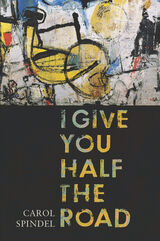 I Give You Half the Road
Carol Spindel
University of Wisconsin Press, 2021 In Ivory Coast, the farewell “I give you half the road” is an expression of hospitality, urging a departing guest to come back again. After their first stay in a welcoming rural community in 1981, Carol Spindel and her husband did just that. Over the course of decades, they built a house and returned frequently, deepening their relationships with neighbors.
Once considered the most stable country in West Africa, Ivory Coast was split by an armed rebellion in 2002 and endured a decade of instability and a violent conflict. Spindel provides an intimate glimpse into this turbulent period by weaving together the daily lives and paths of five neighbors. Their stories reveal Ivorians determined to reunite a divided country through reliance on mutual respect and obligation even while power-hungry politicians pursued xenophobic and anti-immigrant platforms for personal gain. Illuminating democracy as a fragile enterprise that must be continually invented and reinvented, I Give You Half the Road emphasizes the importance of connection, generosity, and forgiveness.
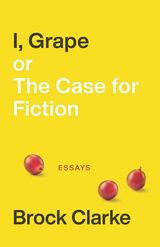 I, Grape; or The Case for Fiction: Essays
Brock Clarke
Acre Books, 2020 In fifteen sharply engaging essays, acclaimed novelist and short story writer Brock Clarke examines the art (and artifice) of fiction from unpredictable, entertaining, and often personal angles, positing through a slant scrutiny of place, voice, and syntax what fiction can—and can’t—do. (“Very: is there a weaker, sadder, more futile word in the English language?”)
Clarke supports his case with passages by and about writers who have both influenced and irritated him. Pieces such as “What the Cold Can Teach Us,” “The Case for Meanness,” “Why Good Literature Makes Us Bad People,” and “The Novel is Dead; Long Live the Novel” celebrate the achievements of master practitioners such as Muriel Spark, Joy Williams, Donald Barthelme, Flannery O’Connor, Paul Beatty, George Saunders, John Cheever, and Colson Whitehead. Of particular interest to Clarke is the contentious divide between fiction and memoir, which he investigates using recent and relevant critical arguments, also tackling ancillary forms such as “fictional memoir” and the autobiographical novel.
Anecdotal and unabashed, rigorous and piercingly perceptive—not to mention flat-out funny—I, Grape; or The Case for Fiction is a love letter to and a passionate defense of the discipline to which its author has devoted his life and mind. It is also an attempt to eff the ineffable: “That is one of the basic tenets of this book: when we write fiction, surprising things sometimes happen, especially when fiction writers take advantage of their chosen form’s contrarian ability to surprise.”
I Hate It Here, Please Vote for Me: Essays on Rural Political Decay
Matthew Ferrence
West Virginia University Press, 2024 2025 WCoNA Book of the Year Finalist
The Best Narrative & Biography Books of 2024, Selected by Porchlight
When a progressive college professor runs for the Pennsylvania House of Representatives in a deeply conservative rural district, he loses. That’s no surprise. But the story of how Ferrence loses and, more importantly, how American political narratives refuse to recognize the existence and value of nonconservative rural Americans offers insight into the political morass of our nation.
In essays focused on showing goats at the county fair, planting native grasses in the front lawn, the political power of poetry, and getting wiped out in an election, Ferrence offers a counter-narrative to stereotypes of monolithic rural American voters and emphasizes the way stories told about rural America are a source for the bitter divide between Red America and Blue America.
 “I have always loved the Holy Tongue”: Isaac Casaubon, the Jews, and a Forgotten Chapter in Renaissance Scholarship
Anthony Grafton and Joanna Weinberg
Harvard University Press, 2011 “[An] extraordinary book.” —New Republic
Fusing high scholarship with high drama, Anthony Grafton and Joanna Weinberg uncover a secret and extraordinary aspect of a legendary Renaissance scholar’s already celebrated achievement. The French Protestant Isaac Casaubon (1559–1614) is known to us through his pedantic namesake in George Eliot’s Middlemarch. But in this book, the real Casaubon emerges as a genuine literary hero, an intrepid explorer in the world of books. With a flair for storytelling reminiscent of Umberto Eco, Grafton and Weinberg follow Casaubon as he unearths the lost continent of Hebrew learning—and adds this ancient lore to the well-known Renaissance revival of Latin and Greek.
The mystery begins with Mark Pattison’s nineteenth-century biography of Casaubon. Here we encounter the Protestant Casaubon embroiled in intellectual quarrels with the Italian and Catholic orator Cesare Baronio. Setting out to understand the nature of this imbroglio, Grafton and Weinberg discover Casaubon’s knowledge of Hebrew. Close reading and sedulous inquiry were Casaubon’s tools in recapturing the lost learning of the ancients—and these are the tools that serve Grafton and Weinberg as they pore through pre-1600 books in Hebrew, and through Casaubon’s own manuscript notebooks. Their search takes them from Oxford to Cambridge, from Dublin to Cambridge, Massachusetts, as they reveal how the scholar discovered the learning of the Hebrews—and at what cost.
I Have Landed: The End of a Beginning in Natural History
Stephen Jay Gould
Harvard University Press, 2011 Gould’s final essay collection is based on his remarkable series for Natural History magazine—exactly 300 consecutive essays, with never a month missed, published from 1974 to 2001. Both an intellectually thrilling journey into the nature of scientific discovery and the most personal book he ever published.
I Have No Regrets: Diaries, 1955-1963
Brigitte Reimann
Seagull Books, 2019 Frank and refreshing, Brigitte Reimann’s collected diaries provide a candid account of life in socialist Germany.
With an upbeat tempo and amusing tone, I Have No Regrets contains detailed accounts of the author’s love affairs, daily life, writing, and reflections. Like the heroines in her stories, Reimann was impetuous and outspoken, addressing issues and sensibilities otherwise repressed in the era of the German Democratic Republic. She followed the state’s call for artists to leave their ivory towers and engage with the people, moving to the new town of Hoyerswerda to work part-time at a nearby industrial plant and run writing classes for the workers. Her diaries and letters provide a fascinating parallel to her fictional writing. By turns shocking, passionate, unflinching, and bitter—but above all life-affirming—they offer an unparalleled insight into what life was like during the first decades of the GDR.
 I Have Not Loved You With My Whole Heart
Cris Harris
Oregon State University Press, 2021 I Have Not Loved You With My Whole Heart is a memoir of trauma, healing, faith, and violence. At its center is the author’s father, the Rev. Renne Harris, a heavy-handed, alcoholic Episcopal priest who came out in the height of the AIDS crisis and died of HIV in 1995.
In a book rich with remembrances of the Pacific Northwest of the 1970s–1990s, Cris Harris pulls the reader through turning points in a household crowded with abuse, addiction, neglect, acceptance, and grief, as well as the healing that comes after reconciliation. In recognizing perpetrators of violence as complex people—as selves we can recognize—Harris wrestles with paradox: the keening dissonance of loving people with hard edges, the humor of horrible situations, and how humor can cover for anger. He shows how violence can mark us and courageously lays bare those marks, owning them as his own precious history, born of a fierce species of love.
I Have Not Loved You With My Whole Heart will speak to readers whose family members came out late in life, and to those who lost loved ones in the AIDS crisis of the late 1980s and 1990s. Those with complicated relationships to faith, survivors of abuse, and anyone who has lived with family crisis will also find healing in these pages.
 I Have Not Loved You With My Whole Heart
Cris Harris
Oregon State University Press, 2021 I Have Not Loved You With My Whole Heart is a memoir of trauma, healing, faith, and violence. At its center is the author’s father, the Rev. Renne Harris, a heavy-handed, alcoholic Episcopal priest who came out in the height of the AIDS crisis and died of HIV in 1995.
In a book rich with remembrances of the Pacific Northwest of the 1970s–1990s, Cris Harris pulls the reader through turning points in a household crowded with abuse, addiction, neglect, acceptance, and grief, as well as the healing that comes after reconciliation. In recognizing perpetrators of violence as complex people—as selves we can recognize—Harris wrestles with paradox: the keening dissonance of loving people with hard edges, the humor of horrible situations, and how humor can cover for anger. He shows how violence can mark us and courageously lays bare those marks, owning them as his own precious history, born of a fierce species of love.
I Have Not Loved You With My Whole Heart will speak to readers whose family members came out late in life, and to those who lost loved ones in the AIDS crisis of the late 1980s and 1990s. Those with complicated relationships to faith, survivors of abuse, and anyone who has lived with family crisis will also find healing in these pages.
I Have Spoken: American History Through The Voices Of The Indians
Virginia I. Armstrong
Ohio University Press, 1971 I Have Spoken is a collection of American Indian oratory from the 17th to the 20th century, concentrating on speeches focusing around Indian-white relationships, especially treaty-making negotiations. A few letters and other writings are also included. Here, in their own words, is the Indian’s story told with integrity, with drama, with caustic wit, with statesmanship, with poetic impact; a story of proffered friendship, of broken promises, of hope, of disillusionment, of pride, of a whole land and life gone sour.
I Hear a Symphony: Motown and Crossover R&B
Andrew Flory
University of Michigan Press, 2017 I Hear a Symphony opens new territory in the study of Motown’s legacy, arguing that the music of Motown was indelibly shaped by the ideals of Detroit’s postwar black middle class; that Motown’s creative personnel participated in an African-American tradition of dialogism in rhythm and blues while developing the famous “Motown Sound.” Throughout the book, Flory focuses on the central importance of “crossover” to the Motown story; first as a key concept in the company’s efforts to reach across American commercial markets, then as a means to extend influence internationally, and finally as a way to expand the brand beyond strictly musical products. Flory’s work reveals the richness of the Motown sound, and equally rich and complex cultural influence Motown still exerts.
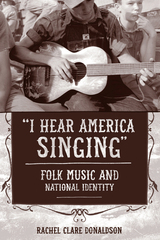 "I Hear America Singing": Folk Music and National Identity
Rachel Clare Donaldson
Temple University Press, 2014 Folk music is more than an idealized reminder of a simper past. It reveals a great deal about present-day understandings of community and belonging. It celebrates the shared traditions that define a group or nation. In America, folk music--from African American spirituals to English ballads and protest songs--renders the imagined community more tangible and comprises a critical component of our diverse national heritage.
In "I Hear America Singing," Rachel Donaldson traces the vibrant history of the twentieth-century folk music revival from its origins in the 1930s through its end in the late 1960s. She investigates the relationship between the revival and concepts of nationalism, showing how key figures in the revival--including Pete Seeger , Alan Lomax, Moses Asch, and Ralph Rinzler--used songs to influence the ways in which Americans understood the values, the culture, and the people of their own nation.
As Donaldson chronicles how cultural norms were shaped over the course of the mid-twentieth century, she underscores how various groups within the revival and their views shifted over time. "I Hear America Singing" provides a stirring account of how and why the revivalists sustained their culturally pluralist and politically democratic Americanism over this tumultuous period in American history.
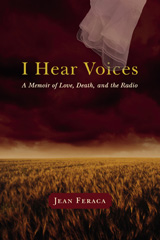 I Hear Voices: A Memoir of Love, Death, and the Radio
Jean Feraca
University of Wisconsin Press, 2007 Jean Feraca’s road to self-fulfillment has been as quirky and demanding as the characters in her incredible memoir. A veteran of several decades of public radio broadcasting, Feraca is also a writer and a poet. She is a talk show host beloved for her unique mixture of the humanities, poetry, and journalism, and is the creator of the pioneering international cultural affairs radio program Here on Earth: Radio without Borders.
In this searing memoir, Feraca traces her own emergence. She pulls back the curtain on her private life, revealing unforgettable portraits of the characters in her brawling Italian-American family: Jenny, the grandmother, the devil woman who threw Casey Stengel down an excavation pit; Dolly, the mother, a cross between Long John Silver and the Wife of Bath, who in battling mental illness becomes the scourge of a Lutheran nursing home; and Stephen, the brilliant but troubled older brother, an anthropologist adopted by a Sioux tribe. In a new chapter that reinforces and ties together the book’s exploration of the multiple forms of love, Jean introduces us to Roger, a Wildman and her husband’s best friend with whom she, too, develops an extraordinary intimacy. A selection of fifteen of Feraca’s poems add counterpoint to her engaging prose.
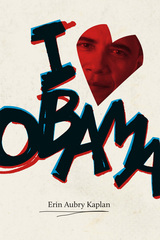 I Heart Obama
Erin Aubry Kaplan
University Press of New England, 2016 In his nearly two terms as president, Barack Obama has solidified his status as something black people haven’t had for fifty years: a folk hero. The 1960s delivered Malcolm X and Martin Luther King, forever twinned as larger-than-life outsiders and truth tellers who took on racism and died in the process. Obama is different: Not an outsider but president, head of the most powerful state in the world; a centrist Democrat, not the face of a movement. Yet he is every bit a folk hero, doing battle with the beast of a system created to keep people like him on the margins. He is unique among presidents and entirely unique among black people, who never expected to have a president so soon. In I Heart Obama, journalist Erin Aubry Kaplan offers an unapologetic appreciation of our highest-ranking “First” and what he means to black Americans. In the process, she explores the critiques of those in the black community who charge that he has not done enough, been present enough, been black enough to motivate real change in America. Racial antipathy cloaked as political antipathy has been the major conflict in Obama’s presidency. His impossible task as an individual and as a president is nothing less than this: to reform the entire racist culture of the country he leads. Black people know he can’t do it, but will support his effort anyway, as they have supported the efforts of many others. Obama’s is a noble and singular story we will tell for generations. I Heart Obama looks at the story so far.
 I Hid It under the Sheets: Growing Up with Radio
Gerald Eskenazi
University of Missouri Press, 2005
Imagine that there was a time in America when a child sat next to a radio and simply listened. But didn’t just listen, was enthralled and knew that this time was his alone, that he was part of the vortex of drama unfolding inside the radio’s innards. . . . I never saw a punch thrown, or a glass shatter, or a blood-smeared shirt as I listened to the radio. Nor did I know Barbara Stanwyck’s hairstyle as she overacted in Sorry, Wrong Number on the Lux Radio Theatre. And I had no idea how corpulent Happy Felton was as he dropped ten silver dollars that jangled into a Sheffield’s Milk bottle on Guess Who. (Yes, ten bucks was what you won on that show.) Instead, I imagined it all.
I Hid It under the Sheets captures a bygone era—the late 1930s, 1940s, and early 1950s—through the reminiscences of award-winning New York Times reporter Gerald Eskenazi. This first-person recollection shows radio’s broad impact on his generation and explains how and why it became such a major factor in shaping America and Americans.
For Eskenazi and his peers, radio had virtually no competition from other forms of media, aside from newspapers. Because of this, radio was able to create a common American culture, something that is not found in today’s multifaceted world. Eskenazi shows how the popular programs of the times—from The Lone Ranger to The Fat Man to The Answer Man—helped create a culture of values (telling the truth, being courteous, being courageous, and being a moral person).
Eskenazi’s personal anecdotes about each program are interspersed with interviews of personalities ranging from Tom Brokaw to Colin Powell about their own experiences with radio. Brokaw, who grew up in South Dakota, found radio brought him closer to the world beyond him. Would he have become the newsman he is today without the radio to pique his imagination?
Eskenazi also shows how important radio was to immigrants seeking to become a part of the American experience. Through radio, even he, a Jewish kid from Brooklyn, could grow up feeling connected to the dominant culture of the times. For those who yearn to remember a time gone by, to laugh at childhood memories, or merely to learn about life during a simpler time, this book is for you.
I Hope I Join the Band: Narrative, Affiliation, and Antiraciset Rhetoric
Frankie Condon
Utah State University Press, 2012 "Both from the Right and from the Left, we are stymied in talking well with one another about race and racism, by intransigent beliefs in our own goodness as well as by our conviction that such talk is useless. . . . White antiracist epistemology needs to begin not with our beliefs, but with our individual and collective awakening to that which we do not know." Drawing on scholarship across disciplines ranging from writing and rhetoric studies to critical race theory to philosophy, I Hope I Join the Band examines the limits and the possibilities for performative engagement in antiracist activism. Focusing particularly on the challenges posed by raced-white identity to performativity, and moving between narrative and theoretical engagement, thebook names and argues for critical shifts in the understandings and rhetorical practices that attend antiracist activism.
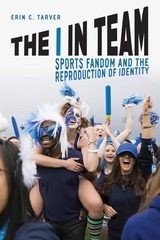 The I in Team: Sports Fandom and the Reproduction of Identity
Erin C. Tarver
University of Chicago Press, 2017 There is one sound that will always be loudest in sports. It isn’t the squeak of sneakers or the crunch of helmets; it isn’t the grunts or even the stadium music. It’s the deafening roar of sports fans. For those few among us on the outside, sports fandom—with its war paint and pennants, its pricey cable TV packages and esoteric stats reeled off like code—looks highly irrational, entertainment gone overboard. But as Erin C. Tarver demonstrates in this book, sports fandom has become extraordinarily important to our psyche, a matter of the very essence of who we are.
Why in the world, Tarver asks, would anyone care about how well a total stranger can throw a ball, or hit one with a bat, or toss one through a hoop? Because such activities and the massive public events that surround them form some of the most meaningful ritual identity practices we have today. They are a primary way we—as individuals and a collective—decide both who we are who we are not. And as such, they are also one of the key ways that various social structures—such as race and gender hierarchies—are sustained, lending a dark side to the joys of being a sports fan. Drawing on everything from philosophy to sociology to sports history, she offers a profound exploration of the significance of sports in contemporary life, showing us just how high the stakes of the game are.
 I Just Let Life Rain Down on Me: Selected Letters and Reflections
Rahel Levin Varnhagen
Seagull Books, 2024 A personal look into the mind of one of Europe’s first and foremost women of letters.
At times poetic but not a poem, prosaic but not an essay, a letter is often pure writing for writing’s sake. Such is the case for Rahel Varnhagen von Ense, née Levin, the illustrious German-Jewish Berlin literary salon hostess from the early nineteenth century. She penned over ten thousand letters to more than three hundred recipients, including princes, philosophers, poets, family members, and the family cook. Written with a wink at posterity, collected and first published after her passing by her husband, Karl August Varnhagen von Ense, these letters constitute a singular contribution to German literature.
Varied in subject—from family affairs to linguistic, literary, and pressing social concerns—the poignant lyricism of her letters is all the more remarkable when we take into account that High German was not her first language; she grew up speaking, reading, and writing primarily Yiddish. Her shaky social status as a woman and a member of a precarious minority, combined with an astounding lucidity and a rare capacity to put her thoughts into words, made her a force to be reckoned with in her lifetime and thereafter as one of Germany’s preeminent women of letters. As we see in I Just Let Life Rain Down on Me, her voice is as fresh and original as that of any of the recognized poets and thinkers of her day. As Rahel herself put it: “[O]ur language is our lived life; I invented mine for my own purposes, I was less able than many others to make use of preconceived turns of phrase, which is why mine are often clumsy, and in all respects faulty, but always true.”
Compiled and translated by Peter Wortsman, this rewarding volume affords English-speaking readers the first privileged peek at the mindset of one of Europe’s first and foremost women of letters.
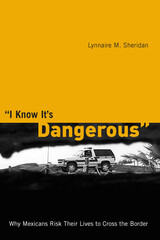 I Know It’s Dangerous: Why Mexicans Risk Their Lives to Cross the Border
Lynnaire M. Sheridan
University of Arizona Press, 2009 Migration from Mexico to the United States has become an increasingly volatile topic. The news is filled with stories of deaths, protests, and amnesty debates. With the constant buzz about migration in the political, economic, and legal spheres, the migrants themselves easily become a de-humanized multitude. “I Know It’s Dangerous”: Why Mexicans Risk Their Lives to Cross the Border strives to put a human face on the issue of migration and effectively turns the statistics we hear so often into individuals with real lives, needs, and desires.
As an Australian national, Lynnaire Sheridan brings a refreshingly neutral voice to this hot-button topic. With data gathered over two years of living in Baja California, Mexico, Sheridan draws out individual stories, motivations, and conceptions of risk that ultimately allow us a deeper understanding of migration. Sheridan enriches the migrants’ stories with examinations of popular songs, graffiti art on the border, analyses of newspaper articles, and in-depth interviews with migrants. Together these narratives show us that risk has become a strong motivating factor for migrants and that stricter border policies have not necessarily stemmed the rates of migration; they have merely changed how people migrate.
Sheridan’s findings have broad implications for both those interested in migration from Mexico to the United States and international migration scholars. This book will appeal to a range of disciplines in the humanities, from anthropology and criminology to art and ethnic studies. It will also resonate among legal professionals, policy makers, and social workers.
While numerous books have focused on the act of migration and its ripples across both the United States and Mexico, this book is unique in its attention to migrants in Mexico and its ability to draw out their individual stories.
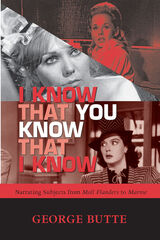 I KNOW THAT YOU KNOW THAT I KNOW: NARRATING SUBJECTS FROM MOLL FLANDERS TO MARNIE
George Butte
Ohio State University Press, 2004 In I Know That You Know That I Know, Butte explores how stories narrate human consciousness. Butte locates a historical shift in the representation of webs of consciousnesses in narrative—what he calls “deep intersubjectivity”—and examines the effect this shift has since had on Western literature and culture. The author studies narrative practices in two ways: one pairing eighteenth-and nineteenth-century British novels (Moll Flanders and Great Expectations, for example), and the other studying genre practices—comedy, anti-comedy and masquerade—in written and film narratives (Jane Austen and His Girl Friday, for example, and Hitchcock’s Cary Grant films). Butte’s second major claim argues for new ways to read representations of human consciousness, whether or not they take the form of deep intersubjectivity. Phenomenological criticism has lost its credibility in recent years, but this book identifies better reading strategies arising out of what the author calls poststructuralist phenomenology, grounded largely in the work of the French philosopher Merleau-Ponty. Butte criticizes the extreme of transcendental idealism (first-wave phenomenological criticism) and cultural materialism (when it rules out the study of consciousness). He also criticizes the dominant Lacanian framework of much academic film criticism.
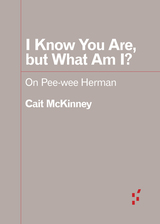 I Know You Are, but What Am I?: On Pee-wee Herman
Cait McKinney
University of Minnesota Press, 2024 How Pee-wee and his playhouse help us reimagine our relationships to technology
I Know You Are, but What Am I? explores the cultural legacy of Pee-wee Herman, the cult television star of Pee-wee’s Playhouse. This children’s show—that was also for adults—ran on network TV from 1986 to 1990 and starred comedian Paul Reubens as Herman, a queer man-boy whose playhouse, the set for the show, was tricked out with a profusion of animate computational toys and technologies. Cait McKinney shows how three defining scenes from the show inform, and even foretell and challenge, our present moment: the playhouse as an alternative precursor to networked smart homes that foregrounds caring and ethical relationships between humans and technologies; a reparative retelling of Reubens’s career-wrecking 1991 arrest for indecent exposure inside a Florida adult film theater as part of an AIDS-phobic, antigay sting operation; and worn-out, Talking Pee-wee dolls and their broken afterlives on eBay and YouTube. McKinney looks at how queer people who were children in the 1980s remember and relate to Pee-wee now, showing that the moral panic about sexuality, gender, and children from the past can help us refute anti-trans and anti-queer political movements organized today.
I Live in the Country & other dirty poems
Arielle Greenberg
Four Way Books, 2020 Arielle Greenberg’s I Live in the Country & other dirty poems exploits and undoes the stereotype of the “wholesome country life.” Here, the speaker moves to the country (“where the animals are”) in order to live a whole life, one in which she can live honestly and openly in a nonmonogamous marriage. Her book is a visceral, erotic celebration of the cornucopia of sexual pleasures to be had in that rural life—in the muck of a pasture in spring or behind the bins of whole-wheat pastry flour at the local co-op. Greenberg hauls out what has previously been stored under dark counters and labeled deviant—kink, fetish, and bondage—and moves it into the sunshine of sex-positivity and mutual consent. In doing so, she forges new literary territory—a feminist re-visioning of the Romantic pastoral poems of seduction. “I am trying to turn my eye toward joy,” she writes. “My heart toward bliss.”
 I Live Underwater: The Thrilling Adventures of a Record-Breaking Diver, Treasure Hunter, and Deep-Sea Explorer
Max Nohl
Wisconsin Historical Society Press, 2025 An outdoor adventure memoir by a legendary diver and innovator who never stopped pushing the limit
I Live Underwater is the highly anticipated posthumous memoir of Max Nohl, a larger-than-life thrill seeker and treasure hunter who revolutionized deep-sea diving. Recounting harrowing experiences with tangled air-hoses, hungry sharks, untested scientific theories, and painful cases of the bends, Nohl’s vivid narrative shows how his unquenchable thirst for adventure propelled him to transcend fear and become one of the field’s great innovators—shattering the diving record in 1937 as the first person to dive deeper than 400 feet.
Beginning with the disquieting childhood experiences that inspired his obsession with the underwater world, Nohl goes on to discuss his innovative work on the first self-contained diving suit as a student at MIT and his risky experiments in breathing helium to achieve deeper dives. In addition to making vital contributions to the commercial diving industry, Nohl was a pioneer in underwater filming, developing equipment and techniques that were employed in many Hollywood film and television productions.
After Nohl’s sudden death in 1960 in a car accident, his nearly complete memoir sat in the Milwaukee Public Library Archives—unpublished, until now. Accompanying this page-turning text is a dynamic assortment of images, including Nohl’s original pen-and-ink sketches and historic photos of Nohl and his collaborators. A foreword by Wisconsin Historical Society maritime archaeologist Tamara Thomsen provides insights into Nohl’s many important contributions to the diving world and to Wisconsin history and culture.
Includes stories of dives in Lake Michigan (near Milwaukee), the North Atlantic (near Marblehead and Martha’s Vineyard), Walden Pond, the Gulf Coast (near Morgan City, Louisiana, and Panama City, Apalachicola, Wakulla Springs, and Tarpon Springs in Florida), and the Caribbean (near Haiti and the Dominican Republic).
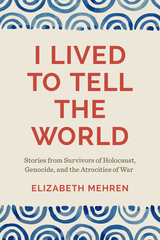 I Lived to Tell the World: Stories from Survivors of Holocaust, Genocide, and the Atrocities of War
Elizabeth Mehren
Oregon State University Press, 2024 As Americans increasingly question how each of us fits into our nation's cultural tapestry, I Lived to Tell the World presents thirteen inspiring profiles of refugees who have settled in Oregon. They come from Rwanda, Myanmar, Bosnia, Syria, and more-different stories, different conflicts, but similar paths through loss and violence to a new, not always easy, life in the United States. The in-depth profiles are drawn from hours of interviews and oral histories; journalist Elizabeth Mehren worked collaboratively with the survivors to honor the complexity of their experiences and to ensure that the stories are told with, and not just about, them. Mehren also weaves in historical, cultural, and political context alongside these personal stories of resilience. In the face of global cruelty and hatred, the courage and fortitude of these individuals illuminate the darkness. Their stories inspire readers to reflect on their own experiences and to view newcomers to America with renewed respect. As more states adopt Holocaust and genocide education curricula and as issues around refugees, immigration, and racial justice gain attention, I Lived to Tell the World highlights the purposeful lives led by these Oregonians despite their painful pasts. Their experiences not only humanize the atrocities often seen in headlines, but also convey a universal message of hope.
 I, Lobster: A Crustacean Odyssey
Nancy Frazier
University of New Hampshire Press, 2012 Consider the lobster. An improbable icon, Mesozoic revenant, surrealist fetish, nightmare ornament, and gastronomic adventure, it has fascinated people throughout history. It may be an exaggeration to say that lobsters are a cultural obsession—but only slightly. I, Lobster dissects the place of the lobster in human affairs, through history, science, myth, art, literature, music, movies, and, of course, cuisine. Though not generally beautiful to human eyes, lobsters star in some of the most gorgeous works of art in the world, the still-lifes painted in the Low Countries during the seventeenth century. And while many of us would question their sex appeal, lobsters carried an erotic charge for artists of the twentieth century who, inspired by Freud, found many opportunities to think of them in that way.
Nancy Frazier explores diverse facets of our fascination with the lobster, whether in art, myth, or science. She describes how the lobster lives in its natural surroundings: its food, sex life, social life, predators, and general behavior. But I, Lobster goes beyond what we think about and do to the lobster, to explore how lobsters speak to us as signs, symbols, metaphors, code words, myth, lore, and fantasy. With recipes drawn from such notable lobster connoisseurs as M. F. K. Fisher, Alice B. Toklas, and Craig Claiborne, I, Lobster is a quirky, charming, and weirdly fascinating compendium of lobster lore.
I Love My Selfie
Essay by Ilan Stavans / Auto-Portraits by ADÁL
Duke University Press, 2017 What explains our current obsession with selfies? In I Love My Selfie noted cultural critic Ilan Stavans explores the selfie's historical and cultural roots by discussing everything from Greek mythology and Shakespeare to Andy Warhol, James Franco, and Pope Francis. He sees selfies as tools people use to disguise or present themselves as spontaneous and casual. This collaboration includes a portfolio of fifty autoportraits by the artist ADÁL; he and Stavans use them as a way to question the notion of the self and to engage with artists, celebrities, technology, identity, and politics. Provocative and engaging, I Love My Selfie will change the way readers think about this unavoidable phenomenon of twenty-first-century life.
 I Love You But I Don't Speak Your Language: Poems
Jason Bredle
University of Massachusetts Press, 2026 Poems that question the world with tenderness and restless introspection
In I Love You But I Don’t Speak Your Language, brushes with the profound may lead to brushes with the mundane, or vice versa. Cause and effect become unreasoned and transcendent, at times lifting the arbitrary into the sublime or the sublime into happenstance. Intuitive leaps pull us through oscillations between humor, introspection, and the surreal. These poems don’t follow a straight path; instead, they capture the way thoughts shift, contradict, and collide.
Inspired by the poet’s dreams, as well as travels throughout central Europe, the West Indies, and Central and South America, the poems are alive in voice and detail, yet the speaker’s connections, and more so, disconnections, turn toward isolationism, solitude, and loneliness. At times, the collection leans into restless emotion: “I want to cry / when I think of how / I’ll look back at this moment someday / and cry.” Other moments pull the reader to “a far away place / of limitless palm trees and sunsets.” This is poetry that doesn’t try to fit into a traditional form. It questions, observes, and rethinks the world around it. Some moments might seem absurd, others deeply reflective, but all of them work together to create a book that is both thought-provoking and unpredictable.
 I Love You But I Don't Speak Your Language: Poems
Jason Bredle
University of Massachusetts Press, 2026 Poems that question the world with tenderness and restless introspection
In I Love You But I Don’t Speak Your Language, brushes with the profound may lead to brushes with the mundane, or vice versa. Cause and effect become unreasoned and transcendent, at times lifting the arbitrary into the sublime or the sublime into happenstance. Intuitive leaps pull us through oscillations between humor, introspection, and the surreal. These poems don’t follow a straight path; instead, they capture the way thoughts shift, contradict, and collide.
Inspired by the poet’s dreams, as well as travels throughout central Europe, the West Indies, and Central and South America, the poems are alive in voice and detail, yet the speaker’s connections, and more so, disconnections, turn toward isolationism, solitude, and loneliness. At times, the collection leans into restless emotion: “I want to cry / when I think of how / I’ll look back at this moment someday / and cry.” Other moments pull the reader to “a far away place / of limitless palm trees and sunsets.” This is poetry that doesn’t try to fit into a traditional form. It questions, observes, and rethinks the world around it. Some moments might seem absurd, others deeply reflective, but all of them work together to create a book that is both thought-provoking and unpredictable.
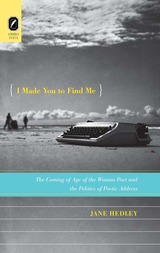 I Made You to Find Me: The Coming of Age of the Woman Poet and the Politics of Poetic Address
Jane Hedley
Ohio State University Press, 2009 When Anne Sexton, Adrienne Rich, Sylvia Plath, and Gwendolyn Brooks began to write poetry during the 1940s and ’50s, each had to wonder whether she could be taken seriously as a poet while speaking in a woman’s voice. I Made You to Find Me, the last line of one of Sexton’s early poems, calls attention to how resourcefully the “I-you” relation had to be staged in order for this question to have an affirmative answer. Whereas Rich tried at first to speak to her own historical moment in the register of universality, Plath openly aspired to be “the Poetess of America.” For Brooks, womanhood and “blackness” were inextricable markers of poetic identity. Jane Hedley’s approach engages biographical, formal, and rhetorical analysis as means to explore each poet’s stated intentions, political stakes, and rhetorical strategies within their own historical context. Sexton’s aggressively social persona called attention to the power dynamics of intimate relationships; Plath’s poems lifted these relationships onto a different plane of reality, where their tragic potential could be more readily engaged. Rich’s poems bear witness to the enormous difficulty, notwithstanding the crucial importance, of reciprocity—of making “you” to find “we.” For Brooks, the crucial question has been whether she could presuppose an “American” audience without compromising her allegiance to “blackness.”
I Make Jokes When I'm Devastated
Luisa Muradyan
Bridwell Press, 2024 I Make Jokes When I’m Devastated evokes love, grief, hope and longing across generations, continents, and devastation in Ukraine. The author uses humor and popular culture as a way to speak through her sadness. Midwest grocery stores, Tony Soprano, murderous internet moms, Soviet scientists, and the Cheesecake Factory all make an appearance in the constantly shifting landscape of this work. This collection also contends with motherhood and what it means to parent through immense loss. Perhaps more than anything the humor in this book acts as an amplifier, a way to hear laughter as clearly as you can hear weeping.
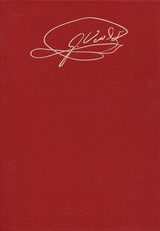 I masnadieri: Melodramma tragico in Four Parts by Andrea Maffei
Giuseppe Verdi Edited by Roberta Montemorra Marvin
University of Chicago Press, 2000 Composed between October 1846 and the spring of 1847, I masnadieri features a libretto based on Schiller's play Die Raüber (The Robbers). The opera premiered in July 1847 at Her Majesty's Theatre, London, with Jenny Lind as the prima donna. Verdi himself supervised the rehearsals for the premiere, and the original performing parts, which contain annotations made by the players under Verdi's direction and changes made by the composer during the rehearsals, have been preserved at the archives of the Royal Opera House.
The critical edition is the first publication of I masnadieri in full score. Based on the composer's autograph and on important secondary sources such as the performing parts mentioned above, this edition provides scholars and performers alike with unequaled means for interpretation and study of one of Verdi's less well known works. The detailed critical commentary discusses problems and ambiguities in the sources, while a wide-ranging introduction to the score traces the opera's genesis, sources, and performance history and practices.
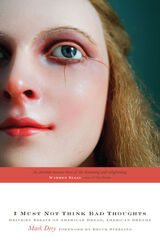 I Must Not Think Bad Thoughts: Drive-by Essays on American Dread, American Dreams
Mark Dery
University of Minnesota Press, 2014 From the cultural critic Wired called “provocative and cuttingly humorous” comes a viciously funny, joltingly insightful collection of drive-by critiques of contemporary America where chaos is the new normal. Exploring the darkest corners of the national psyche and the nethermost regions of the self—the gothic, the grotesque, and the carnivalesque—Mark Dery makes sense of the cultural dynamics of the American madhouse early in the twenty-first century. Here are essays on the pornographic fantasies of Star Trek fans, Facebook as Limbo of the Lost, George W. Bush’s fear of his inner queer, the theme-parking of the Holocaust, the homoerotic subtext of the Super Bowl, the hidden agendas of IQ tests, Santa’s secret kinship with Satan, the sadism of dentists, Hitler’s afterlife on YouTube, the sexual identity of 2001’s HAL, the suicide note considered as a literary genre, the surrealist poetry of robot spam, the zombie apocalypse, Lady Gaga, the Church of Euthanasia, toy guns in the dream lives of American boys, and the polymorphous perversity of Madonna’s big toe. Dery casts a critical eye on the accepted order of things, boldly crossing into the intellectual no-fly zones demarcated by cultural warriors on both sides of America’s ideological divide: controversy-phobic corporate media, blinkered academic elites, and middlebrow tastemakers. Intellectually omnivorous and promiscuously interdisciplinary, Dery’s writing is a generalist’s guilty pleasure in an age of nanospecialization and niche marketing. From Menckenesque polemics on American society and deft deconstructions of pop culture to unflinching personal essays in which Dery turns his scalpel-sharp wit on himself, I Must Not Think Bad Thoughts is a head-spinning intellectual ride through American dreams and American nightmares.
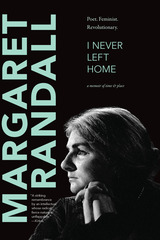 I Never Left Home: Poet, Feminist, Revolutionary
Margaret Randall
Duke University Press, 2020 In 1969, poet and revolutionary Margaret Randall was forced underground when the Mexican government cracked down on all those who took part in the 1968 student movement. Needing to leave the country, she sent her four young children alone to Cuba while she scrambled to find safe passage out of Mexico. In I Never Left Home, Randall recounts her harrowing escape and the other extraordinary stories from her life and career.
From living among New York's abstract expressionists in the mid-1950s as a young woman to working in the Nicaraguan Ministry of Culture to instill revolutionary values in the media during the Sandinista movement, the story of Randall's life reads like a Hollywood production. Along the way, she edited a bilingual literary journal in Mexico City, befriended Cuban revolutionaries, raised a family, came out as a lesbian, taught college, and wrote over 150 books. Throughout it all, Randall never wavered from her devotion to social justice.
When she returned to the United States in 1984 after living in Latin America for twenty-three years, the U.S. Immigration and Naturalization Service ordered her to be deported for her “subversive writing.” Over the next five years, and with the support of writers, entertainers, and ordinary people across the country, Randall fought to regain her citizenship, which she won in court in 1989.
As much as I Never Left Home is Randall's story, it is also the story of the communities of artists, writers, and radicals she belonged to. Randall brings to life scores of creative and courageous people on the front lines of creating a more just world. She also weaves political and social analyses and poetry into the narrative of her life. Moving, captivating, and astonishing, I Never Left Home is a remarkable story of a remarkable woman.
I: New and Selected Poems
Toi Derricotte
University of Pittsburgh Press, 2019 Winner, 2020 Frost Medal
Finalist, 2019 National Book Award
Honorable Mention, 2020 BCALA Literary Awards
Toi Derricotte’s story is a hero’s journey—a poet earning her way home, to her own commanding powers. “I”: New and Selected Poems shows the reader both the closeness of the enemy and the poet’s inherent courage, inventiveness, and joy. It is a record of one woman’s response to the repressive and fracturing forces around the subjects of race, class, color, gender, and sexuality. Each poem is an act of victory as the author finds her way through repressive forces to speak with beauty and truth.
This collection features more than thirty new poems as well as selections from five previous collections.
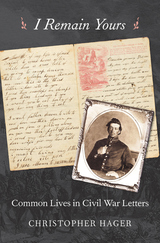 I Remain Yours: Common Lives in Civil War Letters
Christopher Hager
Harvard University Press, 2018 When North and South went to war, millions of American families endured their first long separation. For men in the armies—and their wives, children, parents, and siblings at home—letter writing was the sole means to communicate. Yet for many of these Union and Confederate families, taking pen to paper was a new and daunting task. I Remain Yours narrates the Civil War from the perspective of ordinary people who had to figure out how to salve the emotional strain of war and sustain their closest relationships using only the written word.
Christopher Hager presents an intimate history of the Civil War through the interlaced stories of common soldiers and their families. The previously overlooked words of a carpenter from Indiana, an illiterate teenager from Connecticut, a grieving mother in the mountains of North Carolina, and a blacksmith’s daughter on the Iowa prairie reveal through their awkward script and expression the personal toll of war. Is my son alive or dead? Returning soon or never? Can I find words for the horrors I’ve seen or the loneliness I feel? Fear, loss, and upheaval stalked the lives of Americans straining to connect the battlefront to those they left behind.
Hager shows how relatively uneducated men and women made this new means of communication their own, turning writing into an essential medium for sustaining relationships and a sense of belonging. Letter writing changed them and they in turn transformed the culture of letters into a popular, democratic mode of communication.
I Rest My Case
Mark Verstandig
Northwestern University Press, 2002 Mark Verstandig's compelling epic spans pre-Holocaust Jewish culture in Eastern Europe and its post-war reformation in Australia.
His personal story interweaves the vast forces of politics and history with intimate details of the shtetl--from the pre-war intricacies of Galician society and the textures of a traditional Jewish education, to the agonizing contradictions of Polish-Jewish relations and the complexities of post-war Jewish politics.
His account of the displaced persons camps where 'transit Jews' awaited their chance to emigrate is a signifigant contribution to a little-known aspect of post-war history.
With his gift for observation and his acute powers of analysis, Mark Verstandig has achieved the rare feat of telling the story of his people through his own history. Part autobiography, part Holocaust literature, part sociological analysis, I Rest my Case is a fine achievement.
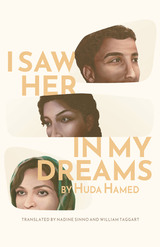 I Saw Her in My Dreams
Huda Hamed, translated by Nadine Sinno & William Taggart
University of Texas Press, 2022 I Saw Her in My Dreams is a powerful novel about interpersonal and systemic violence, examined through the lens of a relationship between Zahiyya, an anxious middle-class Omani artist, and Faneesh, the Ethiopian domestic worker she hires. When Zahiyya’s husband Amer, a novelist, leaves for Zanzibar in search of his biological mother, Zahiyya is left to confront her anxieties and prejudices. Both Zahiyya and Faneesh begin to suffer a recurring nightmare, prompting Zahiyya to read Fanheesh’s diaries in search of answers. Alone and afraid, Zahiyya reads excerpts from Amer’s novel, written from his father’s diaries about living in Zanzibar, where he fell in love with Amer’s mother, a Zanzibari woman whose absence still haunts him. Weaving between multiple perspectives and stories within stories, the novel explores honestly—but without sensationalizing or self-Orientalizing—the anti-Blackness that has endured in the Arab world and elsewhere.
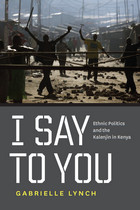 I Say to You: Ethnic Politics and the Kalenjin in Kenya
Gabrielle Lynch
University of Chicago Press, 2011 In 2007 a disputed election in Kenya erupted into a two-month political crisis that led to the deaths of more than a thousand people and the displacement of almost seven hundred thousand. Much of the violence fell along ethnic lines, the principal perpetrators of which were the Kalenjin, who lashed out at other communities in the Rift Valley. What makes this episode remarkable compared to many other instances of ethnic violence is that the Kalenjin community is a recent construct: the group has only existed since the mid-twentieth century. Drawing on rich archival research and vivid oral testimony, I Say to You is a timely analysis of the creation, development, political relevance, and popular appeal of the Kalenjin identity as well as its violent potential. Uncovering the Kalenjin’s roots, Gabrielle Lynch examines the ways in which ethnic groups are socially constructed and renegotiated over time. She demonstrates how historical narratives of collective achievement, migration, injustice, and persecution constantly evolve. As a consequence, ethnic identities help politicians mobilize support and help ordinary people lay claim to space, power, and wealth. This kind of ethnic politics, Lynch reveals, encourages a sense of ethnic difference and competition, which can spiral into violent confrontation and retribution.
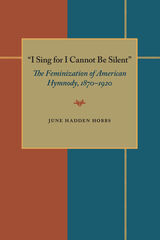 I Sing for I Cannot Be Silent
June Hadden Hobbs
University of Pittsburgh Press, 1997 Evangelical churches sing hymns written between 1870 and 1920 so often that many children learn them by rote before they are able to read religious texts. A cherished part of communal Christian life and an important and effective way to teach doctrine today, these hymns served an additional social purpose in the late nineteenth and early twentieth centuries: they gave evangelical women a voice in their churches.
When the sacred music business expanded after the Civil War, writing hymn texts gave publishing opportunities to women who were forbidden to preach, teach, or pray aloud in mixed groups. Authorized by oral expression, gospel hymns allowed women to articulate alternative spiritual models within churches that highly valued orality.
These feminized hymns are the focus of "I Sing for I Cannot Be Silent." Drawing upon her own experience as a Baptist, June Hadden Hobbs argues that the evangelical tradition is an oral tradition--it is not anti-intellectual but antiprint. Evangelicals rely on memory and spontaneous oral improvisation; hymns serve to aid memory and permit interaction between oral and written language.
By comparing male and female hymnists' use of rhetorical forms, Hobbs shows how women utilized the only oral communication allowed to them in public worship. Gospel hymns permitted women to use a complex system of images already associated with women and domesticity. This feminized hymnody challenged the androcentric value system of evangelical Christianity by making visible the contrasting masculine and feminine versions of Christianity. When these hymns were sung in church, women's voices and opinions moved out of the private sphere and into public religion. The hymns are so powerful that they are suppressed by some contemporary fundamentalists today.
In "I Sing for I Cannot Be Silent" June Hadden Hobbs employs an interdisciplinary mix of feminist literary analysis, social history, rhetoric and composition theory, hymnology, autobiography, and theology to examine hymns central to worship in most evangelical churches today.
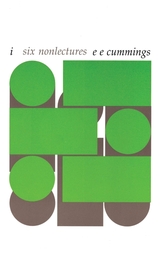 i: six nonlectures
e. e. cummings
Harvard University Press “Marvelously unconventional...a credo of intense individualism.”—Atlantic
A brilliantly eccentric autobiography from one of the most widely read poets of the twentieth century.
“Let me cordially warn you, at the opening of these socalled lectures, that I haven’t the remotest intention of posing as a lecturer.” So begins the first of six delightfully off-kilter “nonlectures” delivered at Harvard in 1952–1953. Gleefully flouting the conventions of the prestigious Charles Eliot Norton Professorship in Poetry, which had previously hosted T. S. Eliot, Igor Stravinsky, and other luminaries, E. E. Cummings declines to offer anything in the way of critical analysis, citing Rainer Maria Rilke’s contention that “Works of art are of an infinite loneliness and with nothing to be so little reached as with criticism.”
Instead, six nonlectures presents a kaleidoscopic tour of the great poet’s life, influences, and favorite poems, from Chaucer, Wordsworth, and Swinburne to selections of his own work. After an autobiographical sketch of his youth in Cambridge, Massachusetts—including reflections on his father’s tragic death, accounts of his formative relationships with the pragmatist philosophers William James and Josiah Royce, stories from his days as a Harvard undergraduate, and readings of his earliest attempts at poetry—Cummings captivates with stream-of-consciousness musings on a dizzying array of subjects: freedom and democracy, New York and Paris, Lenin’s tomb and high-speed elevators, death and Santa Claus.
Replete with digressions, irreverent wordplay, and, of course, parentheses, six nonlectures is a moving tribute to the spirit of artistic individuality, that dedication to unmitigated personal truth without which the poet “would cease to exist at all.”
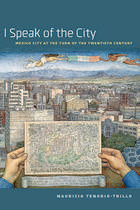 I Speak of the City: Mexico City at the Turn of the Twentieth Century
Mauricio Tenorio-Trillo
University of Chicago Press, 2013 In this dazzling multidisciplinary tour of Mexico City, Mauricio Tenorio-Trillo focuses on the period 1880 to 1940, the decisive decades that shaped the city into what it is today. Through a kaleidoscope of expository forms, I Speak of the City connects the realms of literature, architecture, music, popular language, art, and public health to investigate the city in a variety of contexts: as a living history textbook, as an expression of the state, as a modernist capital, as a laboratory, and as language. Tenorio’s formal imagination allows the reader to revel in the free-flowing richness of his narratives, opening startling new vistas onto the urban experience. From art to city planning, from epidemiology to poetry, this book challenges the conventional wisdom about both Mexico City and the turn-of-the-century world to which it belonged. And by engaging directly with the rise of modernism and the cultural experiences of such personalities as Hart Crane, Mina Loy, and Diego Rivera, I Speak of the City will find an enthusiastic audience across the disciplines.
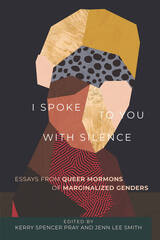 I Spoke to You with Silence: Essays from Queer Mormons of Marginalized Genders
Edited by Kerry Spencer Pray and Jenn Lee Smith
University of Utah Press, 2022 Nobody knows what to do about queer Mormons. The institutional Church of Jesus Christ of Latter-day Saints prefers to pretend they don’t exist, that they can choose their way out of who they are, leave, or at least stay quiet in a community that has no place for them. Even queer Mormons don’t know what to do about queer Mormons. Their lived experience is shrouded by a doctrine in which heteronormative marriage is non-negotiable and gender is unchangeable. For women, trans Mormons, and Mormons of other marginalized genders, this invisibility is compounded by social norms which elevate (implicitly white) cisgender male voices above those of everyone else.
This collection of essays gives voice to queer Mormons. The authors who share their stories—many speaking for the first time from the closet—do so here in simple narrative prose. They talk about their identities, their experiences, their relationships, their heartbreaks, their beliefs, and the challenges they face. Some stay in the church, some do not, some are in constant battles with themselves and the people around them as they make agonizing decisions about love and faith and community. Their stories bravely convey what it means to be queer, Mormon, and marginalized—what it means to have no voice and yet to speak anyway.
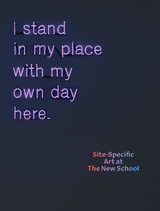 I Stand in My Place With My Own Day Here: Site-Specific Art at The New School
Edited by Frances Richard, with a foreword by Lydia Matthews and an introduction by Silvia Rocciolo and Eric Stark
Duke University Press, 2020 I Stand in My Place with My Own Day Here features essays by more than fifty renowned international writers who consider thirteen monumental works of art created for The New School between 1930 and the present. The nucleus of The New School's Art Collection, these commissions—ranking among the finest site-specific works in New York City—range from murals by José Clemente Orozco and Thomas Hart Benton to installations by Agnes Denes, Kara Walker, Alfredo Jaar, Glenn Ligon, Sol LeWitt, and Martin Puryear + Michael Van Valkenburgh, among others.
Providing a kaleidoscopic view into these works, this richly illustrated volume explores each installation through three to four essays written by critics, poets, and scholars from diverse fields including anthropology, mathematics, art history, media studies, and design. Their texts are complemented by three additional essays reflecting on each piece's art historical significance; the architectural contexts in which the works reside on the university's campus; and The New School's relationship to adventurous art practice. Also included is a roundtable discussion among leading arts educators and artists who reflect on the pedagogical potential of a campus-based contemporary art collection. The book's final section presents a history of each commissioned work, highlighted by archival images never before published.
Published by The New School. Distributed by Duke University Press.
Contributors. Saul Anton, Daniel A. Barber, Stefano Basilico, Carol Becker, Naomi Beckwith, Omar Berrada, Gregg Bordowitz, Tisa Bryant, Holland Cotter, Mónica de la Torre, Aruna D'Souza, Elizabeth Ellsworth, Julia L. Foulkes, Andrea Geyer, Kathleen Goncharov, Jennifer A. González, Michele Greet, Randall Griffey, Victoria Hattam, Pablo Helguera, Jamer Hunt, Anna Indych-López, Luis Jaramillo, Jeffrey Kastner, Robert Kirkbride, Lynda Klich, Carin Kuoni, Sarah E. Lawrence, Tan Lin, Lucy R. Lippard, Laura Y. Liu, Reinhold Martin, Shannon Mattern, Lydia Matthews, Maggie Nelson, Olu Oguibe, G. E. Patterson, Hugh Raffles, Claudia Rankine, Jasmine Rault, Heather Reyes, Frances Richard, Silvia Rocciolo, Carl Hancock Rux, Luc Sante, Mira Schor, Eric Stark, Radhika Subramaniam, Edward J. Sullivan, Roberto Tejada, Otto von Busch, Wendy S. Walters, Jennifer Wilson, Mabel O. Wilson
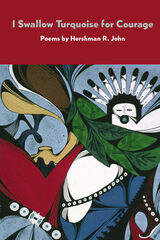 I Swallow Turquoise for Courage
Hershman R. John
University of Arizona Press, 2007 Álk’idídaa’ jini. The stories begin. In poems that exude the warmth of an afternoon in the southwestern sun, Hershman John draws readers into a world both familiar and utterly new. Raised on a reservation and in boarding schools, then educated at a state university, John writes as a contemporary Navajo poet. His is a new voice—one that understands life on both sides of the canyon that divides, but does not completely separate, the Diné people from their neighbors who live outside the reservation. His poetry draws freely from tribal myths and legends, and like its creator, it lives outside the reservation too. Perhaps that is why they seem so unspoiled, so sparkling. They are like gemstones that we have never seen. And we are dazzled.
With their recurring images of sheep, coyotes, and crows—and an ever-present Navajo grandmother—these poems carry echoes of an ancient time that seems to exist in parallel with our own. The people who live in them bear, as if woven strand by strand into their souls, the culture and traditions of the Glittering World. Although these poems are lush with imagery of sunbaked lands, they are never sentimental. Throughout this collection, the poet’s voice is confident, assured, and engaged with life in a messy world. It is a world in which animated spirits dwell comfortably with modern machinery, where the spiritual resides with the all-too-human. This is a welcoming universe. It invites us to enter, to linger, to savor, and to learn.
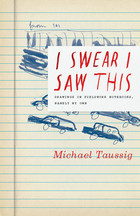 I Swear I Saw This: Drawings in Fieldwork Notebooks, Namely My Own
Michael Taussig
University of Chicago Press, 2011 I Swear I Saw This records visionary anthropologist Michael Taussig’s reflections on the fieldwork notebooks he kept through forty years of travels in Colombia. Taking as a starting point a drawing he made in Medellin in 2006—as well as its caption, “I swear I saw this”—Taussig considers the fieldwork notebook as a type of modernist literature and the place where writers and other creators first work out the imaginative logic of discovery. Notebooks mix the raw material of observation with reverie, juxtaposed, in Taussig’s case, with drawings, watercolors, and newspaper cuttings, which blend the inner and outer worlds in a fashion reminiscent of Brion Gysin and William Burroughs’s surreal cut-up technique. Focusing on the small details and observations that are lost when writers convert their notes into finished pieces, Taussig calls for new ways of seeing and using the notebook as form. Memory emerges as a central motif in I Swear I Saw This as he explores his penchant to inscribe new recollections in the margins or directly over the original entries days or weeks after an event. This palimpsest of afterthoughts leads to ruminations on Freud’s analysis of dreams, Proust’s thoughts on the involuntary workings of memory, and Benjamin’s theories of history—fieldwork, Taussig writes, provokes childhood memories with startling ease. I Swear I Saw This exhibits Taussig’s characteristic verve and intellectual audacity, here combined with a revelatory sense of intimacy. He writes, “drawing is thus a depicting, a hauling, an unraveling, and being impelled toward something or somebody.” Readers will exult in joining Taussig once again as he follows the threads of a tangled skein of inspired associations.
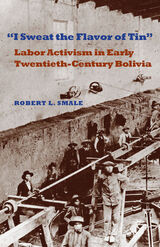 I Sweat the Flavor of Tin: Labor Activism in Early Twentieth-Century Bolivia
Robert L. Smale
University of Pittsburgh Press, 2010
On June 4, 1923, the Bolivian military turned a machine gun on striking miners in the northern Potosí town of Uncía. The incident is remembered as Bolivia’s first massacre of industrial workers. The violence in Uncía highlights a formative period in the development of a working class who would eventually challenge the oligarchic control of the nation.
Robert L. Smale begins his study as Bolivia’s mining industry transitioned from silver to tin; specifically focusing on the region of Oruro and northern Potosí. The miners were part of a heterogeneous urban class alongside artisans, small merchants, and other laborers. Artisan mutual aid societies provided miners their first organizational models and the guidance to emancipate themselves from the mine owners’ political tutelage. During the 1910s both the Workers’ Labor Federation and the Socialist Party appeared in Oruro to spur more aggressive political action. In 1920 miners won a comprehensive contract that exceeded labor legislation debated in Congress in the years that followed. Relations between the working class and the government deteriorated soon after, leading to the 1923 massacre in Uncía. Smale ends his study with the onset of the Great Depression and premonitions of war with Paraguay—twin cataclysms that would discredit the old oligarchic order and open new horizons to the labor movement.
This period’s developments marked the entry of workers and other marginalized groups into Bolivian politics and the acquisition of new freedoms and basic rights. These events prefigure the rise of Evo Morales—a union activist born in Oruro—in the early twenty-first century.
I Talk about It All the Time
Camara Lundestad Joof
University of Wisconsin Press, 2024 In this biting, lyrical memoir, Camara Lundestad Joof, born in Bodø to Norwegian and Gambian parents, shares her experiences as a queer Black Norwegian woman. Joof’s daily encounters belie the myth of a colorblind contemporary Scandinavia. She wrestles with the fickle palimpsest of memory, demanding communion with her readers even as she recognizes her own exhaustion in the face of constantly being asked to educate others.
“I regularly decide to quit talking to white people about racism,” writes Joof. Such discussions often feel unproductive, the occasional spark of hope coming at enormous personal cost. But not talking about it is impossible, a betrayal of self. The book is a self-examination as well as societal indictment. It is an open challenge to readers, to hear her as she talks about it, all the time.
I Tatti Studies in the Italian Renaissance, volume 24 number 2 (Fall 2021)
The University of Chicago Press
University of Chicago Press Journals, 2021 This is volume 24 issue 2 of I Tatti Studies in the Italian Renaissance. Published twice a year, I Tatti Studies in the Italian Renaissance features groundbreaking work written in Italian and in English on every aspect of the literary, religious, artistic, historical, and scientific dimensions of Renaissance Italy. Articles offer pioneering work in a number of areas, ranging from Botticelli’s illustrations for Dante’s Commedia to Florentine sermons on the Dives and Lazarus story to images of Ottoman culture in Mantua. The journal regularly publishes clusters of essays and other special sections.
I Tatti Studies in the Italian Renaissance, volume 25 number 1 (Spring 2022)
The University of Chicago Press
University of Chicago Press Journals, 2022 This is volume 25 issue 1 of I Tatti Studies in the Italian Renaissance. Published twice a year, I Tatti Studies in the Italian Renaissance features groundbreaking work written in Italian and in English on every aspect of the literary, religious, artistic, historical, and scientific dimensions of Renaissance Italy. Articles offer pioneering work in a number of areas, ranging from Botticelli’s illustrations for Dante’s Commedia to Florentine sermons on the Dives and Lazarus story to images of Ottoman culture in Mantua. The journal regularly publishes clusters of essays and other special sections.
I Tatti Studies in the Italian Renaissance, volume 25 number 2 (Fall 2022)
The University of Chicago Press
University of Chicago Press Journals, 2022 This is volume 25 issue 2 of I Tatti Studies in the Italian Renaissance. Published twice a year, I Tatti Studies in the Italian Renaissance features groundbreaking work written in Italian and in English on every aspect of the literary, religious, artistic, historical, and scientific dimensions of Renaissance Italy. Articles offer pioneering work in a number of areas, ranging from Botticelli’s illustrations for Dante’s Commedia to Florentine sermons on the Dives and Lazarus story to images of Ottoman culture in Mantua. The journal regularly publishes clusters of essays and other special sections.
I Tatti Studies in the Italian Renaissance, volume 26 number 1 (Spring 2023)
The University of Chicago Press
University of Chicago Press Journals, 2023 This is volume 26 issue 1 of I Tatti Studies in the Italian Renaissance. Published twice a year, I Tatti Studies in the Italian Renaissance features groundbreaking work written in Italian and in English on every aspect of the literary, religious, artistic, historical, and scientific dimensions of Renaissance Italy. Articles offer pioneering work in a number of areas, ranging from Botticelli’s illustrations for Dante’s Commedia to Florentine sermons on the Dives and Lazarus story to images of Ottoman culture in Mantua. The journal regularly publishes clusters of essays and other special sections.
I Tatti Studies, volume 26 number 2 (Fall 2023)
The University of Chicago Press
University of Chicago Press Journals, 2023 This is volume 26 issue 2 of I Tatti Studies. Published twice a year, I Tatti Studies features groundbreaking work written in Italian and in English on every aspect of the literary, religious, artistic, historical, and scientific dimensions of Renaissance Italy. Articles offer pioneering work in a number of areas, ranging from Botticelli’s illustrations for Dante’s Commedia to Florentine sermons on the Dives and Lazarus story to images of Ottoman culture in Mantua. The journal regularly publishes clusters of essays and other special sections.
I Tatti Studies, volume 27 number 2 (Fall 2024)
The University of Chicago Press
University of Chicago Press Journals, 2024 This is volume 27 issue 2 of I Tatti Studies. Published twice a year, I Tatti Studies features important new work on every aspect of the literary, religious, musical, artistic, philosophical, historical, and scientific dimensions of early modern Italy in a global context. The journal regularly publishes clusters of essays and other special sections.
I Tatti Studies, volume 28 number 1 (Spring 2025)
The University of Chicago Press
University of Chicago Press Journals, 2025 This is volume 28 issue 1 of I Tatti Studies. Published twice a year, I Tatti Studies features important new work on every aspect of the literary, religious, musical, artistic, philosophical, historical, and scientific dimensions of early modern Italy in a global context. The journal regularly publishes clusters of essays and other special sections.
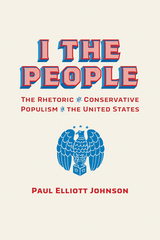 I the People: The Rhetoric of Conservative Populism in the United States
Paul Elliott Johnson
University of Alabama Press, 2022 Winner of the National Communication Association’s 2023 Hochmuth-Nichols Award " . . . An important contribution to studies of the American conservative movement and, more generally, Populist discourse. Recommended." —CHOICE I The People: The Rhetoric of Conservative Populism in the United States examines a variety of texts—ranging from speeches and campaign advertisements to news reports and political pamphlets—to outline the populist character of conservatism in the United States. Paul Elliott Johnson focuses on key inflection points in the development of populist conservatism, including its manifestation in the racially charged presidential election of 1964, its consolidation at the height of Ronald Reagan’s reelection campaign in 1984, and its character in successive moments that saw its fortunes wax and wane, including 1994, the Obama era, and the rise of Donald J. Trump. theorizing conservative populism as a rhetorical form, Johnson advances scholarship about populism away from a binary ideological framework while offering a useful lens for contextualizing scholarship on American conservatism. I The People emphasizes that the populist roots of conservative hegemony exercise a powerful constraining force on conservative intellectuals, whose power to shape and control the movement to which they belong is circumscribed by the form of its public-facing appeals. The study also reframes scholarly understandings of the conservative tradition’s seeming multiplicity, especially the tendency to suggest an abiding conservative unease regarding capitalism, showing how racist hostility underwrote a compromise with an increasingly economized understanding of humanity. Johnson also contests the narrative that conservatives learned to practice identity politics from social progressives. From the beginning, conservatism’s public vernacular was a white and masculine identity politics reliant on a rhetoric of victimhood, whether critiquing the liberal Cold War consensus or President Barack Obama.
 I The Song
Jill M Soens
University of Utah Press, 1999 I, the Song is an introduction to the rich and complex classical North American poetry that grew out of and reflects Indian life before the European invasion. No generalization can hold true for all the classical poems of North American Indians. They spring from thirty thousand years of experience, five hundred languages and dialects, and ten linguistic groups and general cultures. But the poems from these different cultures and languages belong to poetry unified by similar experiences and shared continent.
Built on early transcriptions of Native American “songs” and arranged by subject, these poems are informed by additional context that enables readers to appreciate more fully their imagery, their cultural basis, and the moment that produced them. They let us look at our continent through the eyes of a wide range of people: poets, hunters, farmers, holy men and women, and children. This poetry achieved its vividness, clarity, and intense emotional powers partly because the singers made their poems for active use as well as beauty, and also because they made them for singing or chanting rather than isolated reading.
Most striking, classical North American Indian poetry brings us flashes of timeless vision and absolute perception: a gull’s wing red over the dawn; snow-capped peaks in the moonlight; a death song. Flowing beneath them is a powerful current: the urge to achieve a selfless attention to the universe and a determination to see and delight in the universe on its own terms.
I Think Again of Those Ancient Chinese Poets
Tom Sexton
University of Alaska Press, 2010 This all-new collection by former Alaska poet laureate smoothly blends his life in Maine, his years in Alaska, and his love of Chinese poetry—which has been a key influence on his work—into a lyrical fantasy that will enchant lovers of verse. These tightly rhythmic, compact eight-line poems demonstrate a rare deftness with—and an even more uncommon ear for—language, revealing poetic form to be neither a puzzle nor an accomplishment in itself, but a compositional tool and a spur to creativity.
 I Think I Am: Philip K. Dick
Laurence A. Rickels
University of Minnesota Press, 2010 For years, noted writer Laurence A. Rickels often found himself compared to novelist Philip K. Dick—though in fact Rickels had never read any of the science fiction writer’s work. When he finally read his first Philip K. Dick novel, while researching for his recent book The Devil Notebooks, it prompted a prolonged immersion in Dick’s writing as well as a recognition of Rickels’s own long-documented intellectual pursuits. The result of this engagement is I Think I Am: Philip K. Dick, a profound thought experiment that charts the wide relevance of the pulp sci-fi author and paranoid visionary. I Think I Am: Philip K. Dick explores the science fiction author’s meditations on psychic reality and psychosis, Christian mysticism, Eastern religion, and modern spiritualism. Covering all of Dick’s science fiction, Rickels corrects the lack of scholarly interest in the legendary Californian author and, ultimately, makes a compelling case for the philosophical and psychoanalytic significance of Philip K. Dick’s popular and influential science fiction.
I Thought of Daisy
Edmund Wilson
University of Iowa Press, 2001 Originally published in 1929, I Thought of Daisy is the first of three novels by Edmund Wilson. Written while he was still balancing his ambitions as a novelist against a successful career in literary criticism, I Thought of Daisy marries Wilson's two vocations to create an unusual and revealing work of fiction.
I Thought There Would Be More Wolves: Poems
Sara Ryan
University of Alaska Press, 2021 After moving to the Upper Peninsula of Michigan, poet Sara Ryan found herself immersed in the isolated spaces of the North: the cold places that never thawed, the bleak expanses of snow. These poems have teeth, bones, and blood—they clack and bruise and make loud sounds. They interrogate self-preservation, familial history, extinction, taxidermy, and animal and female bodies. In between these lines, in warm places where blood collects, animals stay hidden and hunted, a girl looks loneliness dead in the eye, and wolves come out of the woods to run across the frozen water of Lake Superior.
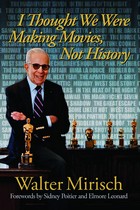 I Thought We Were Making Movies, Not History
Walter Mirisch
University of Wisconsin Press, 2008 This is a moving, star-filled account of one of Hollywood’s true golden ages as told by a man in the middle of it all. Walter Mirisch’s company has produced some of the most entertaining and enduring classics in film history, including West Side Story, Some Like It Hot, In the Heat of the Night, and The Magnificent Seven. His work has led to 87 Academy Award nominations and 28 Oscars. Richly illustrated with rare photographs from his personal collection, I Thought We Were Making Movies, Not History reveals Mirisch’s own experience of Hollywood and tells the stories of the stars—emerging and established—who appeared in his films, including Natalie Wood, John Wayne, Peter Sellers, Sidney Poitier, Steve McQueen, Marilyn Monroe, and many others.
With hard-won insight and gentle humor, Mirisch recounts how he witnessed the end of the studio system, the development of independent production, and the rise and fall of some of Hollywood’s most gifted (and notorious) cultural icons. A producer with a passion for creative excellence, he offers insights into his innovative filmmaking process, revealing a rare ingenuity for placating the demands of auteur directors, weak-kneed studio executives, and troubled screen sirens.
From his early start as a movie theater usher to the presentation of such masterpieces as The Apartment, Fiddler on the Roof, and The Great Escape, Mirisch tells the inspiring life story of his climb to the highest echelon of the American film industry. This book assures Mirisch’s legacy—as Elmore Leonard puts it—as “one of the good guys.”
Best Books for Special Interests, selected by the American Association of School Librarians, and Best Books for General Audiences, selected by the Public Library Association
I Ulu I Ka 'Aina: Land
edited by Jonathan Osorio
University of Hawaii Press, 2014 The Hawaiʻinuiākea Monograph Series presents volume II,”I Ulu i ka Āina,” ten essays that describe the fundamental relationships between Kanaka Maoli and the land. From the memories of long-time activists, cultural practitioners and seasoned administrators to the inspirational insights of young scholar/advocates for our cultural, economic and political progress, each piece evidences the inseparability of the Kanaka from the ʻĀina. It is that inseparability and not our numbers, our relative poverty, nor even our political status that will determine the destiny of the Hawaiian nation. We grow the land, we grow ourselves.
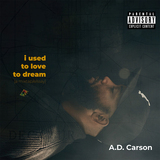 i used to love to dream
A.D. Carson
University of Michigan Press, 2020 “i used to love to dream” is a mixtap/e/ssay that performs hip-hop scholarship using sampled and live instrumentation; repurposed music, film, and news clips; and original rap lyrics. As a genre, the mixtap/e/ssay brings together the mixtape—a self-produced or independently released album issued free of charge to gain publicity—and the personal and scholarly essays. “i used to love to dream” names Decatur, Illinois—the author's hometown—as a reference point for place- and time-specific rapped ruminations about the ideas of growing up, moving away, and pondering one's life choices. At the same time, the tracks attempt to account for moral, philosophical, and ethical dimensions undergirding unease about authenticity, or staying true to oneself and to one’s city or neighborhood, as well as the external factors that contribute to such feelings. Using the local to ask questions about the global, “i used to love to dream” highlights outlooks on Black life generally, and Black manhood in particular, in the United States. The tracks are presented along with liner notes and a short documentary about the making of the mixtap/e/ssay, and accompanying articles to provide context for the tracks for listeners both in classrooms and outside of them.
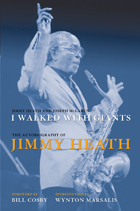 I Walked With Giants: The Autobiography of Jimmy Heath
Jimmy Heath and Joseph McLaren, foreword by Bill Cosby, introduction by Wynton Marsalis
Temple University Press, 2010 Composer of more than 100 jazz pieces, three-time Grammy nominee, and performer on more than 125 albums, Jimmy Heath has earned a place of honor in the history of jazz. Over his long career, Heath knew many jazz giants such as Charlie Parker and played with other innovators including John Coltrane, Miles Davis, and especially Dizzy Gillespie. Heath also won their respect and friendship.
In this extraordinary autobiography, the legendary Heath creates a “dialogue” with musicians and family members. As in jazz, where improvisation by one performer prompts another to riff on the same theme, I Walked with Giants juxtaposes Heath’s account of his life and career with recollections from jazz giants about life on the road and making music on the world’s stages. His memories of playing with his equally legendary brothers Percy and Albert (aka “Tootie”) dovetail with their recollections.
Heath reminisces about a South Philadelphia home filled with music and a close-knit family that hosted musicians performing in the city’s then thriving jazz scene. Milt Jackson recalls, “I went to their house for dinner…Jimmy’s father put Charlie Parker records on and told everybody that we had to be quiet till dinner because he had Bird on…. When I [went] to Philly, I’d always go to their house.” Today Heath performs, composes, and works as a music educator and arranger. By turns funny, poignant, and extremely candid, Heath’s story captures the rhythms of a life in jazz.
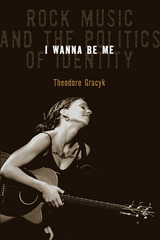 I Wanna Be Me: Rock Music And The Politics Of Identity
Theodore Gracyk
Temple University Press, 2001 As someone who feels the emotional power of rock and who writes about it as an art form, Theodore Gracyk has been praised for launching "plainspoken arguments destined to change the future of rock and roll," (Publishers Weekly). In I Wanna Be Me, his second book about the music he cares so much about, Gracyk grapples with the ways that rock shapes—limits and expands—our notions of who we can be in the world.
Gracyk sees rock as a mass art, open-ended and open to diverse (but not unlimited) interpretations. Recordings reach millions, drawing people together in communities of listeners who respond viscerally to its sound and intellectually to its messages. As an art form that proclaims its emotional authenticity and resistance to convention, rock music constitutes part of the cultural apparatus from which individuals mold personal and political identities. Going to the heart of this relationship between the music's role in its performers' and fans' self-construction, Gracyk probes questions of gender and appropriation. How can a feminist be a Stones fan or a straight man enjoy the Indigo Girls? Does borrowing music that carries a "racial identity" always add up to exploitation, a charge leveled at Paul Simon's Graceland?
Ranging through forty years of rock history and offering a trove of anecdotes and examples, I Wanna Be Me, like Gracyk's earlier book, "should be cherished, and read, by rockers everywhere" (Salon).
 I Want Golden Eyes
Maria Dadouch; translated by M. Lynx Qualey and Sawad Hussain
University of Texas Press, 2025 A girl must save herself and her family after discovering her society's secrets in this sci-fi novel in translation. I Want Golden Eyes is set on the Comoros Islands at the end of this century in a futuristic city called Quartzia, the home of a genetically privileged minority called the Golden Eyes. The rest of the population, the Limiteds, live in a cavity called the Hive beneath the city. Dalia is a sixteen-year-old girl who lives in the Hive but works with her family in Quartzia at Professor Adam’s house, where she cleans, her sister grows organic food in the garden, and her deaf father works as the cook. Because books are forbidden in the Hive, Dalia secretly borrows math texts from the professor’s library and smuggles them to read in the Hive. When Professor Adam, who is famous for engineering embryos with enhanced genes, discovers Dalia’s crime, he enslaves her for two years in his library. Dalia seeks to flee the city with her family after overhearing the professor being ordered to design genetic traits for the president’s expected baby and realizes that Golden Eyes are not privileged by nature’s selection, as she was led to believe, but by authority and money.
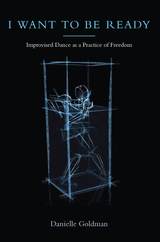 I Want to Be Ready: Improvised Dance as a Practice of Freedom
Danielle Goldman
University of Michigan Press, 2010 "Danielle Goldman's contribution to the theory and history of improvisation in dance is rich, beautiful and extraordinary. In her careful, rigorously imaginative analysis of the discipline of choreography in real time, Goldman both compels and allows us to become initiates in the mysteries of flight and preparation. She studies the massive volitional resources that one unleashes in giving oneself over to being unleashed. It is customary to say of such a text that it is 'long-awaited' or 'much anticipated'; because of Goldman's work we now know something about the potenza, the kinetic explosion, those terms carry. Reader, get ready to move and be moved."
---Fred Moten, Duke University "In this careful, intelligent, and theoretically rigorous book, Danielle Goldman attends to the 'tight spaces' within which improvised dance explores both its limitations and its capacity to press back against them. While doing this, Goldman also allows herself---and us---to be moved by dance itself. The poignant conclusion, evoking specific moments of embodied elegance, vulnerability, and courage, asks the reader: 'Does it make you feel like dancing?' Whether taken literally or figuratively, I can't imagine any other response to this beautiful book."
---Barbara Browning, New York University "This book will become the single most important reflection on the question of improvisation, a question which has become foundational to dance itself. The achievement of I Want to Be Ready lies not simply in its mastery of the relevant literature within dance, but in its capacity to engage dance in a deep and abiding dialogue with other expressive forms, to think improvisation through myriad sites and a rich vein of cultural diversity, and to join improvisation in dance with its manifestations in life so as to consider what constitutes dance's own politics."
---Randy Martin, Tisch School of Arts at New York University I Want To Be Ready draws on original archival research, careful readings of individual performances, and a thorough knowledge of dance scholarship to offer an understanding of the "freedom" of improvisational dance. While scholars often celebrate the freedom of improvised performances, they are generally focusing on freedom from formal constraints. Drawing on the work of Michel Foucault and Houston Baker, among others, Danielle Goldman argues that this negative idea of freedom elides improvisation's greatest power. Far from representing an escape from the necessities of genre, gender, class, and race, the most skillful improvisations negotiate an ever shifting landscape of constraints. This work will appeal to those interested in dance history and criticism and also interdisciplinary audiences in the fields of American and cultural studies. Danielle Goldman is Assistant Professor of Dance at The New School and a professional dancer in New York City, where she recently has danced for DD Dorvillier and Beth Gill. Cover art: Still from Ghostcatching, 1999, by Bill T. Jones, Paul Kaiser, and Shelley Eshkar. Image courtesy of Kaiser/Eshkar.
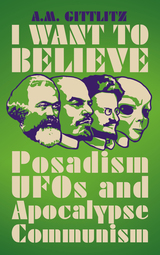 I Want to Believe: Posadism, UFOs and Apocalypse Communism
A.M. Gittlitz
Pluto Press, 2020 "Looks back at the history of Posadism to explore why this largely discredited movement has elicited so much recent interest."—Art in America
Advocating nuclear war, attempting communication with dolphins, and taking an interest in the paranormal and UFOs, there is perhaps no greater (or stranger) cautionary tale for the Left than that of Posadism. Named after the Argentine Trotskyist J. Posadas, the movement’s journey through the fractious and sectarian world of mid-20th century revolutionary socialism was unique. This book is a “dumpster dive” into the weird and wonderful world of the Posadists.
Although at times significant, Posadas' movement was ultimately a failure. As it disintegrated, it increasingly grew to resemble a bizarre cult, detached from the working class it sought to liberate. The renewed interest in Posadism today, especially for its more outlandish fixations, speaks to both a cynicism towards the past and nostalgia for the earnest belief that a better world is possible. Chapters include:
*Revolutionary Youth or Patriotic Youth
*The Death Throes of Capitalism
*The Origins of Posadism
*Flying Saucers, the Process of Matter and Energy, Science, the Revolutionary and Working-Class Stuggle, and the Socialist Future of Mankind
*What Exists Cannot be True
*Why Don’t Extraterrestrials Make Public Contact
*UFOs to the People
In the Introduction, A.M. Gittlitz writes, “Insurrection or first contact could come any day, Marxists and ufologists both tell us, but both are far more likely if we desire them, embracing a sentiment enigmatically expressed in a meme come before its time, a poster on the wall of rouge FBI agent Fox Mulder in the ‘90s sci-fi noir The X-Files: hovering alongside a granny image of a comically unconvincingly flying saucer and the words I WANT TO BELIEVE".
Drawing on considerable archival research, and numerous interviews with ex- and current Posadists, I Want to Believe tells the fascinating story of this most unusual socialist movement and considers why it continues to capture the imaginations of leftists today.
 I Want to Get Married!: One Wannabe Bride’s Misadventures with Handsome Houdinis, Technicolor Grooms, Morality Police, and Other Mr. Not Quite Rights
By Ghada Abdel Aal
University of Texas Press, 2010 The rules may differ from country to country, but the dating game is a universal constant. After years of searching for Mr. Right in living-room meetings arranged by family or friends, Ghada Abdel Aal, a young Egyptian professional, decided to take to the blogosphere to share her experiences and vent her frustrations at being young, single, and female in Egypt. Her blog, I Want to Get Married!, quickly became a hit with both men and women in the Arab world. With a keen sense of humor and biting social commentary, Abdel Aal recounts in painful detail her adventures with failed proposals and unacceptable suitors. There's Mr. Precious, who storms out during their first meeting when he feels his favorite athlete has been slighted, and another suitor who robs her in broad daylight, to name just a few of the characters she runs across in her pursuit of wedded bliss. I Want to Get Married! has since become a best-selling book in Egypt and the inspiration for a television series. This witty look at dating challenges skewed representations of the Middle East and presents a realistic picture of what it means to be a single young woman in the Arab world, where, like elsewhere, a good man can be hard to find.
I Want to Tell You: Poems
Jesse Lee Kercheval
University of Pittsburgh Press, 2023 In Jesse Lee Kercheval’s sixth collection, I Want To Tell You, her searching, incantatory poems speak directly and forcefully to the reader in a voice that is by turns angry, elegiac, wry, or witty but always sharply alive. Crossing through the bewildering territory of grief, Kercheval argues with god and the universe about the deaths of people she loves. She also writes movingly about the complications of family life and love, the messy puzzle of life itself.
 I Want You to Be: On the God of Love
Tomáš Halík
University of Notre Dame Press, 2016 In his two previous books translated into English, Patience with God and Night of the Confessor, best-selling Czech author and theologian Tomáš Halík focused on the relationship between faith and hope. Now, in I Want You to Be, Halík examines the connection between faith and love, meditating on a statement attributed to St. Augustine—amo, volo ut sis, “I love you: I want you to be”—and its importance for contemporary Christian practice. Halík suggests that because God is not an object, love for him must be expressed through love of human beings. He calls for Christians to avoid isolating themselves from secular modernity and recommends instead that they embrace an active and loving engagement with nonbelievers through acts of servitude. At the same time, Halík critiques the drive for mere material success and suggests that love must become more than a private virtue in contemporary society. I Want You to Be considers the future of Western society, with its strong division between Christian and secular traditions, and recommends that Christians think of themselves as partners with nonbelievers. Halik’s distinctive style is to present profound insights on religious themes in an accessible way to a lay audience. As in previous books, this volume links spiritual and theological/philosophical topics with a tentative diagnosis of our times. This is theology written on one’s knees; Halik is as much a spiritual writer as a theologian. I Want You to Be will interest both general and scholarly readers interested in questions of secularism and Christianity in modern life.
"Tomáš Halík recovers the old insight of the church fathers that faith should be seen as a journey rather than a fixed dwelling. His meditation on this is full of fresh insights that renew old truths, and help us make surprising, biblical sense of our bafflement before the existential issues of faith. This is a book for our age." —Charles Taylor, emeritus, McGill University
"Seldom have I read a book that prompted me to think about the mystery of God's love in such surprising and delightful new ways. By turns profound, challenging, and unsettling, Tomáš Halík's new book is also a rarity in theological and spiritual discourse in that it is beautifully written, clearly articulated, and wonderfully inviting." —James Martin, S.J., author of Jesus: A Pilgrimage
"In this luminous book, Tomáš Halík embodies St. Paul’s description of love—as patient, as kind, as bearing and enduring all things—in providing wise and gentle accompaniment to all those, believers and nonbelievers alike, who are seekers of transcendence in our perplexing times. In his exploration of the meaning of love of God and love of one’s enemy, he mines insights not only from familiar figures such as Eckhart, Kierkegaard, and Levinas, but from surprising sources including Feuerbach, Marx, and Nietzsche. I Want You to Be adds to a body of work in which Halík has responded to Charles Taylor’s historical-sociological-philosophical analysis of our 'secular age' with his own penetrating theological, spiritual, and psychological diagnosis of the conditions of post-secularity." —William A. Barbieri, Catholic University of America
“Tomáš Halík is building a broad community of readers in Europe, between various religions, disciplines, cultures, and nations. He writes at a level higher than our best spiritual writers but does not write as an academic theologian despite the fact that he knows that kind of literature well. Halík's message of religious tolerance and understanding, against the background of European secularization, reflects a new voice for an American audience.” —Richard Rohr, O.F.M., Center for Action and Contemplation
I Was a Cold War Monster: Horror Films, Eroticism, and the Cold War Imagination
Cyndy Hendershot
University of Wisconsin Press, 2001 Horror films provide a guide to many of the sociological fears of the Cold War era. In an age when warning audiences of impending death was the order of the day for popular nonfiction, horror films provided an area where this fear could be lived out to its ghastly conclusion. Because enemies and potential situations of fear lurked everywhere, within the home, the government, the family, and the very self, horror films could speak to the invasive fears of the cold war era. I Was a Cold War Monster examines cold war anxieties as they were reflected in British and American films from the fifties through the early sixties. This study examines how cold war horror films combined anxiety over social change with the erotic in such films as Psycho, The Tingler, The Horror of Dracula, and House of Wax.
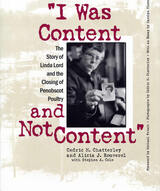 I Was Content and Not Content: The Story of Linda Lord and the Closing of Penobscot Poultry
Cedric N. Chatterley and Alicia J. Rouverol with Stephen A. Cole. Foreword by Michael Frisch. Photographs by Cedric N. Chatterly. With an Essay by Carolyn Chute
Southern Illinois University Press, 1999
Most studies of deindustrialization in the United States emphasize the economic impact of industrial decline; few consider the social, human costs. "I Was Content and Not Content": The Story of Linda Lord and the Closing of Penobscot Poultry is a firsthand account of a plant closure, heavily illustrated through photographs and told through edited oral history interviews. It tells the story of Linda Lord, a veteran of Penobscot Poultry Company in Belfast, Maine, and her experience when the plant—Maine’s last poultry-processing plant— closed its doors in 1988, costing over four hundred people their jobs and bringing an end to a once productive and nationally competitive agribusiness.
Linda Lord’s story could be that of any number of Americans—blue- and white-collar—effected by the rampant and widespread downsizing over the past several decades. She began working at Penobscot straight out of high school and remained with the company for over twenty years. Lord worked in all aspects of poultry processing, primarily in the "blood tunnel," where she finished off the birds that had been missed by the automatic neck-cutting device—a job held by few women. Single and self-supporting, Lord was thirty-nine years old when the plant closed. In part because she was the primary caretaker for her elderly parents, Lord did not want to leave Maine for a better job but did want to stay in the area that had been her home since birth.
The book is comprised of distinct sections representing different perspectives on Lord’s story and the plant’s demise. Cedric N. Chatterley’s gritty black-and-white photographs, reproduced here as duotones, document the final days at the poultry plant and chronicle Lord’s job search, as well as her daily life and community events. Lord’s oral history interviews, interspersed with the photographs, reveal her experiences working in poultry processing and her perspectives on the plant’s closing. Carolyn Chute’s essay reflects on her own struggles as a worker in Maine, and, more generally, on the way workers are perceived in America. Alicia J. Rouverol’s historical essay explores the rise and fall of Maine’s poultry industry and the reasons for its demise. Stephen A. Cole’s epilogue brings the story full circle when he tells of his most recent visit with Linda Lord. Michael Frisch (Portraits in Steel, A Shared Authority) contributes a foreword.
Lord’s story and the story of Penobscot’s closing brings into question the relationship of business to community, reminding us that businesses and communities are in fact integrally linked—or, perhaps more accurately, should be. Her narrative makes plain that plant closings have particular ramifications for women workers, but her experience also points to the way in which all individuals cope with change, hardship, and uncertain times to create possibilities where few exist. Perhaps most important, her story reveals some of the challenges and complexities that most human beings share.
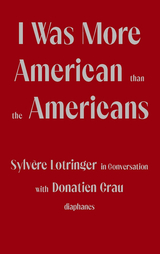 I Was More American than the Americans: Sylvère Lotringer in Conversation with Donatien Grau
Sylvère Lotringer and Donatien Grau
Diaphanes, 2021 A personal take on French Theory by one of the people who invented it.
In the mid-1970s, Sylvère Lotringer created Semiotext(e), a philosophical group that became a magazine and then a publishing house. Since its creation, Semio-text(e) has been a place of stimulating dialogue between artists and philosophers, and for the past fifty years, much of American artistic and intellectual life has depended on it. The model of the journal and the publishing house revolves around the notion of the collective, and Lotringer has rarely shared his personal journey: his existence as a hidden child during World War II; the liberating and then traumatic experience of the collective in the kibbutz; his Parisian activism in the 1960s; his time of wandering, that took him, by way of Istanbul, to the United States; and then, of course, his American years, the way he mingled his nightlife with the formal experimentation he invented with Semiotext(e) and with his classes. Since the early 2010s, Donatien Grau has developed the habit of visiting Lotringer during his trips to Los Angeles; some of their dialogs were published or held in public. This book is an entry into Lotringer's life, his friendships, his choices, and his admiration for some of the leading thinkers of our times. The conversations between Lotringer and Grau show bursts of life, traces of a journey, through texts and existence itself, with an unusual intensity.
I Was Thinking of Beauty
Sydney Lea
Four Way Books, 2013 It's been said about Lea that “this extraordinary poet finds an elegance and beauty that can be glimpsed throughout his often harsh landscape.” This new collection evidences that skill. Here the natural world coexists with the poet’s boundless intellect. Lea’s keen narrative eye keeps us fully in the present as he reminisces on the past—which Lea unravels, chisels away at in search of a deeper understanding—so vivid it could be our own.
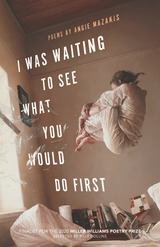 I Was Waiting to See What You Would Do First: Poems
Angie Mazakis
University of Arkansas Press, 2020 Finalist, 2020 Miller Williams Poetry Prize Like nesting dolls, the poems in I Was Waiting to See What You Would Do First contain scenes within scenes, inviting the reader over and over again to sharpen focus on minute details that, though small, reveal much about human perception and imagination. Angie Mazakis handles these layers of revelation with great tenderness. Her poems wander in the way that a curious mind wanders, so that even though they often end very far from where they started, they are anchored in the familiar, referring to experiences we all share: a moment of distraction in a coffee shop imagining a conversation with someone across the room, or a narrative built around the expressions of the cartoon people on the airplane seatback safety guide. I Was Waiting to See What You Would Do First is a testament to the notion that whether through a cosmic or microscopic lens, “You just see one moment; you just see now.”
 I Will Mix Your Blood with Coal: Snapshots from the East of Ukraine
Oleksandr Mykhed, Tanya Savchynska, and David Mossop
Northwestern University Press, 2025 Exploring the post-Soviet landscape of the Ukrainian east in a complex journey of loss, hope, and history
In 2014, the Russian army, with support from local militants, occupied parts of Ukraine’s two easternmost regions—once the beating industrial heart of the Soviet Union—where coal extraction has since exhausted both the human population and the natural resources. In late 2016, Oleksandr Mykhed set out on a research trip to explore the deep history and contested present of the area from the perspective of a fellow countryman who’d never been there.
Mykhed brings us on a painful yet hopeful journey across the Ukrainian east, sharing conversations with locals, snippets from archival documents, and the complicated perspectives of prominent cultural figures, such as writer Serhiy Zhadan, historian Olena Stiazhkina, and philosopher Ihor Kozlovsky, who was imprisoned and tortured for nearly two years.
I Will Mix Your Blood with Coal invites us to meet generations of coal miners. To learn about the Belgian and British investors who founded the east’s industrial cities. To remember the harrowing events of the First and Second World Wars and the incalculable brutality of Soviet history. To see the activists who are even now working to improve the country. To hear sweet memories of a lost utopia that never existed. Mykhed provides a unique portrait of life in the east during the war, before the full-scale invasion that would change everything.
 I Will Not Name It Except To Say
Lee Sharkey
Tupelo Press, 2021 I Will Not Name It Except to Say deals with loves, rituals, deaths, and creations; it does this with terms and names, at first, and then continues past them. The title of Lee Sharkey’s new poetry collection suggests that names are important, but only in service of something else. Some poems in this book kick-off from names of artists and their work-like “Fate of the Animals” or “Kollwitz: The Work”-to spiral and expand into other considerations, about what a country is or what it means to create a character in a painting. Other times, poems cut into what is unnamed altogether: Sharkey writes about “banned…words” or “What the news won’t tell” to see something previously missed. In one poem, “X”, Sharkey completely strips specific terms and names from her description-she uses variables, and sees how the unnamed can affect a reader who’s kept completely uninformed. In this book, names and terms become important because they have to do with memory and history. A city amounts to its personal, cultural history, which needs to be preserved; saving a city consists in collecting and recording its writings, “to keep the people’s memory alive”. In personal family life, keeping a memory-which means keeping names and stories intact-is also a wonderfully, terrifyingly important responsibility. As the speaker realizes for themselves, late in this book: “Soon, I’ll be the only keeper of the memories that made a family. / I don’t trust myself with that much treasure / but here I am, holding out my arms and smiling.”
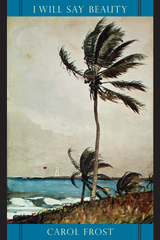 I Will Say Beauty
Carol Frost
Northwestern University Press, 2003 The thrilling new collection from the Pushcart Prize-winning poet
"I will say beauty," Carol Frost boldly says in one of her new lyrical poems, beauty being for her and all of us elusive-in and out of nature. The phrase is meant as a cri de coeur, and the poems are arranged to offer a fresh way to look at--and exist within--nature. For Frost, beauty is a far cry from the decorous and social.
Frost sets many of these poems in Florida's Cedar Keys, amidst the nesting areas of birds, cottonmouth snakes, wetlands, and tidal rhythms. The reader undertakes a journey through a tropical summer, where strange scents and sounds are signs of the transient beauties the imagination may possess for a moment. Drawing brilliantly from nature and from art, from the rhythms of life and the furies of emotion, Frost rejects standard responses and dares to ask: how do we perceive the world? When is beauty not enough? Can we imagine Paradise? And, when nature ordains that death must come, and we weaken, how do we die?
 I Wish I Had a Heart Like Yours, Walt Whitman
Jude Nutter
University of Notre Dame Press, 2009
In "Return of the Heroes," Walt Whitman refers to the casualties of the American Civil War: "the dead to me mar not. . . . / they fit very well in the landscape under the trees and grass. . . ." In her new poetry collection, Jude Nutter challenges Whitman's statement by exploring her own responses to war and conflict and, in a voice by turns rueful, dolorous, and imagistic, reveals why she cannot agree.
Nutter, who was born in England and grew up in Germany, has a visceral sense of history as a constant, violent companion. Drawing on a range of locales and historical moments—among them Rwanda, Sarajevo, Nagasaki, and both world wars—she replays the confrontation of personal history colliding with history as a social, political, and cultural force. In many of the poems, this confrontation is understood through the shift from childhood innocence and magical thinking to adult awareness and guilt.
Nutter responds to Whitman from another perspective as well. It was Whitman who wrote that he could live with animals because, among other things, they are placid, self-contained, and guiltless. As counterpoint, Nutter weaves a series of animal poems—a kind of personal bestiary—throughout the collection that reveals the tragedy and violence also inherent in the lives of animals. Here, as in much of Nutter's previous work, the boundaries between the animal and human worlds are permeable; the urgent voice of the poet insists we recognize that "Even from a distance, suffering / is suffering." Here is both acknowledgment and challenge: distance may be measured in terms of time, culture, or place, or it may be caused by the gap between animals and humans, but it is our responsibility to speak against atrocity and bloodshed, however voiceless we may feel.
“In poem after poem, Jude Nutter bridges the gap between past and present, loss and reclamation, and does so in expansive, passionate lyrics full of clarity, imagination, and sureness of vision. She is, quite simply, one of the finest poets writing in America today. This is a powerful, poignant volume, each poem ‘a gesture of welcome’ that brings us home to the great healing powers of our language.” —Robert Hedin, author of The Old Liberators: New and Selected Poems and Translations and editor of the Great River Review
“Driven, almost tormented, by her sense of historical events, by what war accomplishes and destroys, Jude Nutter does the poet’s work of resurrection—she mourns and makes real with language some of the enormous losses suffered, and with her exceptional gifts brings some of the lost back to life to be thought of, considered, and remembered by her readers. It matters when such an accomplished poet insists we pay attention and then shows us what to attend to in this extraordinary new collection of poems.” —Deborah Keenan, author of Willow Room, Green Door: New and Selected Poems
“The poems in Jude Nutter's I Wish I Had a Heart Like Yours, Walt Whitmanconsistently and beautifully re-imagine the poem of meditation on the atrocities of war. Nutter invokes, invites and revises Whitman's civil war poems through thoroughly contemporary and female perspectives. These poems haunt and inspire with a lush expansiveness that slams that old mind/body gap quite closed.” —Leslie Adrienne Miller, author of The Resurrection Trade
 I Woke a Lake
Susan McCabe
University Press of Colorado, 2025 I Woke a Lake faces the anxieties of climate change, extinctions, and political chaos. Susan McCabe weaves together the fragile fabric of worlds imagined and lost, both palpable and present. Poised between reveries and ruins, the book traverses several layers: the Ice Age; the excavation of the oldest female body; ancient Los Angeles before humans; and, in Sweden (McCabe’s mother’s home country), the 377-million-year-old meteor-made Siljan lake, in conversation with the oldest tree alive. These channeled non-human voices, both whimsical and uncanny, animate more recent landscapes—such as Dalarna’s nearby seventeenth-century copper mine, now closed, along with a fantastical modern ice hotel in a state of meltdown. The landmarks of loss are sometimes dizzy-making as McCabe celebrates her childhood pantheism and queer development in West Hollywood, mourns dead relatives and lost habitats, and confronts her masculine lineage, blotted out through grief, addiction, and war. I Woke a Lake holds up an invisible telephone connecting recurrent locales, among them, blasted orchards, the Veterans’ Cemetery, Elizabeth Bishop’s childhood home in Great Village, grieving parties, and a cryopreservation site. These different layers reverberate with each other, taking on a haunted and haunting music, reaching toward an otherworldly, tender overhearing.
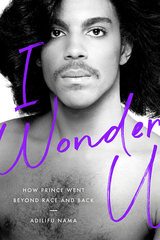 I Wonder U: How Prince Went beyond Race and Back
Adilifu Nama
Rutgers University Press, 2020 Featured in the 2020 Association of University Presses Book, Jacket, and Journal Show
In 1993, Prince infamously changed his name to a unique, unpronounceable symbol. Yet this was only one of a long string of self-reinventions orchestrated by Prince as he refused to be typecast by the music industry’s limiting definitions of masculinity and femininity, of straightness and queerness, of authenticity and artifice, or of black music and white music.
Revealing how he continually subverted cultural expectations, I Wonder U examines the entirety of Prince’s diverse career as a singer, multi-instrumentalist, songwriter, producer, record label mogul, movie star, and director. It shows how, by blending elements of R&B, rock, and new wave into an extremely videogenic package, Prince was able to overcome the color barrier that kept black artists off of MTV. Yet even at his greatest crossover success, he still worked hard to retain his credibility among black music fans. In this way, Adilifu Nama suggests, Prince was able to assert a distinctly black political sensibility while still being perceived as a unique musical genius whose appeal transcended racial boundaries.
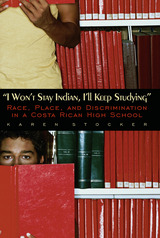 I Won't Stay Indian, I'll Keep Studying: Race, Place, and Discrimination in a Costa Rican High School
Karen Stocker
University Press of Colorado, 2005 While teaching and researching on an indigenous reservation in Costa Rica, Karen Stocker discovered that for Native students who attended the high school outside the reservation, two extreme reactions existed to the predominantly racist high school environment. While some maintained their indigenous identity and did poorly in school, others succeeded academically, but rejected their Indianness and the reservation. Between these two poles lay a whole host of responses. In "I Won't Stay Indian, I'll Keep Studying," Stocker addresses the institutionalized barriers these students faced and explores the interaction between education and identity.
Stocker reveals how overt and hidden curricula taught ethnic, racial, and gendered identities and how the dominant ideology of the town, present in school, conveyed racist messages to students.
"I Won't Stay Indian, I'll Keep Studying" documents how students from the reservation reacted to, coped with, and resisted discrimination. Considering the students' experiences in the context of the Costa Rican educational system as a whole, Stocker discusses policy shifts that might reduce institutionalized discrimination. Her interpretation of the experiences of these students makes a significant contribution to anthropology, Latin American studies, critical race theory, and educational theory.
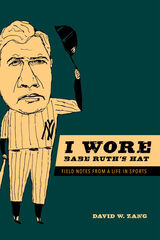 I Wore Babe Ruth's Hat: Field Notes from a Life in Sports
David Zang
University of Illinois Press, 2015 David W. Zang played junior high school basketball in a drained swimming pool. He wore a rubber suit to bed to make weight for a wrestling meet. He kept a log as an obsessive runner (not a jogger). In short, he soldiered through the life of an ordinary athlete.
Whether pondering his long-unbuilt replica of Connie Mack Stadium or his eye-opening turn as the Baltimore Ravens' mascot, Zang offers tales at turns poignant and hilarious as he engages with the passions that shaped his life. Yet his meditations also probe the tragedy of a modern athletic culture that substitutes hyped spectatorship for participation. As he laments, American society's increasing scorn for taking part in play robs adults of the life-affirming virtues of games that challenge us to accomplish the impossible for the most transcendent of reasons: to see if it can be done.
From teammates named Lop to tracing Joe Paterno's long shadow over Happy Valley, I Wore Babe Ruth's Hat reports from the everyman's Elysium where games and life intersect.
I Would Define the Sun: Poems
Stephanie Niu; Foreword by Major Jackson
Vanderbilt University Press, 2025 Stephanie Niu’s I Would Define the Sun, awarded the 2024 Vanderbilt University Literary Prize, is a collection of poems that declare the impossibility of defining something as immense as the sun while striving toward that impossible act. In an era of planetary collapse, filled with bushfires, bleached coral, and burnout, Niu explores what love can do even through estrangement, even through being together at the end of the world. Recycling and folding language through duplexes, sestinas, and echoing couplets, this collection moves across great distances to include Christmas Island, Chinese-American immigration, and the precarity and abundance of the sea through formal and lyric poetry. Expansive in scope, Niu refits the world into a size “made for [her] hands, [her] human tongue,” propelling readers into continuous motion as she searches for home.
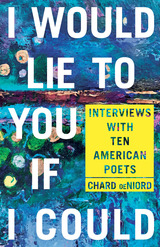 I Would Lie to You if I Could: Interviews with Ten American Poets
Chard deNiord
University of Pittsburgh Press, 2018 I Would Lie To You If I Could contains interviews with nine eminent contemporary American poets (Natasha Trethewey, Jane Hirshfield, Martín Espada, Stephen Kuusisto, Stephen Sandy, Ed Ochester, Carolyn Forche, Peter Everwine, and Galway Kinnell) and James Wright’s widow Anne. It presents conversations with a vital cross section of poets representing a variety of ages, ethnicities, and social backgrounds.
The poets testify to the demotic nature of poetry as a charged language that speaks uniquely in original voices, yet appeals universally. As individuals with their own transpersonal stories, the poets have emerged onto the national stage from very local places with news that witnesses memorably in social, personal, and political ways. They talk about their poems and development as poets self-effacingly, honestly, and insightfully, describing just how and when they were "hurt into poetry," as well as why they have pursued writing poetry as a career in which, as Robert Frost noted in his poem "Two Tramps in Mud Time," their object has become "to unite [their] avocation and [their] vocation / As [their] two eyes make one in sight."
 I Would Meet You Anywhere: A Memoir
Susan Kiyo Ito
Ohio State University Press, 2023 A Library Journal best memoir of 2023 • Finalist, National Book Critics Circle Award in Autobiography Growing up with adoptive nisei parents, Susan Kiyo Ito knew only that her birth mother was Japanese American and her father white. But finding and meeting her birth mother in her early twenties was only the beginning of her search for answers, history, and identity. Though the two share a physical likeness, an affinity for ice cream, and a relationship that sometimes even feels familial, there is an ever-present tension between them, as a decades-long tug-of-war pits her birth mother’s desire for anonymity against Ito’s need to know her origins, to see and be seen. Along the way, Ito grapples with her own reproductive choices, the legacy of the Japanese American incarceration experience during World War II, and the true meaning of family. An account of love, what it’s like to feel neither here nor there, and one writer’s quest for the missing pieces that might make her feel whole, I Would Meet You Anywhere is the stirring culmination of Ito’s decision to embrace her right to know and tell her own story.
I Write This to You: Sonnets
Roger Armbrust
Parkhurst Brothers, Inc., 2022 Armbrust writes sonnets on a variety of themes, primarily addressed to his muse and his lovers. Since 1979 when his first book of poetry went to press he continues to write, as if he opens a vein to pour his own blood onto the page to do it.
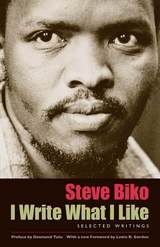 I Write What I Like: Selected Writings
Steve Biko
University of Chicago Press, 2002 "The most potent weapon in the hands of the oppressor is the mind of the oppressed." Like all of Steve Biko's writings, those words testify to the passion, courage, and keen insight that made him one of the most powerful figures in South Africa's struggle against apartheid. They also reflect his conviction that black people in South Africa could not be liberated until they united to break their chains of servitude, a key tenet of the Black Consciousness movement that he helped found.
I Write What I Like contains a selection of Biko's writings from 1969, when he became the president of the South African Students' Organization, to 1972, when he was prohibited from publishing. The collection also includes a preface by Archbishop Desmond Tutu; an introduction by Malusi and Thoko Mpumlwana, who were both involved with Biko in the Black Consciousness movement; a memoir of Biko by Father Aelred Stubbs, his longtime pastor and friend; and a new foreword by Professor Lewis Gordon.
Biko's writings will inspire and educate anyone concerned with issues of racism, postcolonialism, and black nationalism.
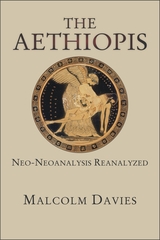 The Aethiopis: Neo-Neoanalysis Reanalyzed
Malcolm Davies
Harvard University Press, 2015 It may seem odd to devote an entire book, however short, to a lost epic of which hardly any fragments (as normally defined) survive. The existence of a late prose summary of the epic’s contents hardly dispels that oddness. One (rather long) word may supply justification: Neoanalysis.
This once influential theory held that motifs and episodes in the Iliad derive from the Aethiopis, called thus after an Ethiopian prince who allied with Troy against the Greeks, only to be killed by the Greeks’ greatest hero, Achilles. The death of that hero himself, at the hands of Paris, was then described, followed by the suicide of Ajax and preparations for the sack of Troy. The prose summary thus suggests a sequel to Homer’s poem, rather than its source, and for various reasons, especially the theory’s apparent failure to allow for the concept of oral composition, Neoanalysis fell into disfavor. Its recent revival in subtler form, given its vast potential implications for the Iliad’s origins, has inspired this volume’s critical reappraisal of that theory’s more sophisticated reincarnation. In addition, even more than with other lost early epics, the possibility that Greek vase paintings may reflect episodes of the poem must be examined.
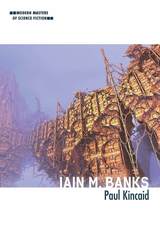 Iain M. Banks
Paul Kincaid
University of Illinois Press, 2017 The 1987 publication of Iain M. Banks's Consider Phlebas helped trigger the British renaissance of radical hard science fiction and influenced a generation of New Space Opera masters. The thirteen SF novels that followed inspired an avid fandom and intense intellectual engagement while Banks's mainstream books vaulted him to the top of the Scottish literary scene. Paul Kincaid has written the first study of Iain M. Banks to explore the confluence of his SF and literary techniques and sensibilities. As Kincaid shows, the two powerful aspects of Banks's work flowed into each other, blurring a line that critics too often treat as clear-cut. Banks's gift for black humor and a honed skepticism regarding politics and religion found expression even as he orchestrated the vast, galaxy-spanning vistas in his novels of the Culture. In examining Banks's entire SF oeuvre, Kincaid unlocks the set of ideas Banks drew upon, ideas that spoke to an unusually varied readership that praised him as a visionary and reveled in the distinctive character of his works. Entertaining and broad in scope, Iain M. Banks offers new insights on one of the most admired figures in contemporary science fiction.
 iatrogenesis: Essays on Becoming a Physician
University of Michigan Medical Students
Michigan Publishing, 2018 In iatrogenesis: Essays on Becoming a Physician, medical students share coming-of-age stories that illustrate the rigorous, rewarding, and sometimes unforgiving journey into medicine.
In Greek, iatro- means doctor, and -genesis means origin: Iatrogenesis thus describes any effect, good or bad, brought forth by a physician’s actions. This essay compendium looks beyond a physician’s impact on patients, instead turning inward to examine the impact of medical training on student doctors. These essays written by University of Michigan medical students span from the donning of the White Coat to graduation. Along the way, each writer weaves a story, the threads of which unite in a tapestry highlighting the universality of this coming-of-age journey. These essays breathe life into each stage of medical apprenticeship, displaying the full spectrum of human emotion as medical students find ways to reinvent themselves as the physicians of tomorrow.
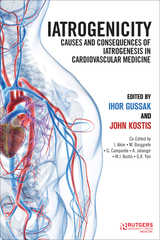 Iatrogenicity: Causes and Consequences of Iatrogenesis in Cardiovascular Medicine
Gussak, Ihor B
Rutgers University Press, 2017 Iatrogenesis is the occurrence of untoward effects resulting from actions of health care providers, including medical errors, medical malpractice, practicing beyond one’s expertise, adverse effects of medication, unnecessary treatment, inappropriate screenings, and surgical errors. This is a huge public health issue: tens to hundreds of thousands of deaths are attributed to iatrogenic causes each year in the U.S., and vulnerable populations such as the elderly and minorities are particularly susceptible.
Edited by two renowned cardiology experts, Iatrogenicity: Causes and Consequences of Iatrogenesis in Cardiovascular Medicine addresses both the iatrogenicity that arises with cardiovascular interventions, as well as non-cardiovascular interventions that result in adverse consequences on the cardiovascular system. The book aims to achieve three things: to summarize the available information on this topic in a single high-yield volume; to highlight the human and financial cost of iatrogenesis; and to describe and propose potential interventions to ameliorate the effects of iatrogenesis. This accessible book is a practical reference for any practicing physician who sees patients with cardiovascular issues. .
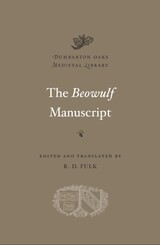 The Beowulf Manuscript: Complete Texts and The Fight at Finnsburg
R. D. Fulk
Harvard University Press, 2010 Beowulf is one of the finest works of vernacular literature from the European Middle Ages and as such is a fitting title to head the Old English family of texts published in the Dumbarton Oaks Medieval Library.
But this volume offers something unique. For the first time in the history of Beowulf scholarship, the poem appears alongside the other four texts from its sole surviving manuscript: the prose Passion of Saint Christopher, The Wonders of the East, The Letter of Alexander the Great to Aristotle, and (following Beowulf) the poem Judith. First-time readers as well as established scholars can now gain new insights into Beowulf—and the four other texts—by approaching each in its original context.
Could a fascination with the monstrous have motivated the compiler of this manuscript, working over a thousand years ago, to pull together this diverse grouping into a single volume? The prose translation by R. D. Fulk, based on the most recent editorial understanding, allows readers to rediscover Beowulf’s brilliant mastery along with otherworldly delights in the four companion texts in The Beowulf Manuscript.
 The Iberian Apollonius of Tyre
Emily C. Francomano
Harvard University Press, 2024 A new translation of two medieval Spanish versions of the tale of Apollonius, a story central to the premodern literary imagination and a source for Shakespeare’s Pericles.
Incest, riddling, piracy, prostitution, shipwreck, Lazarus-like resuscitation, and seductive musical performances—the story of King Apollonius and his wanderings, with its riveting plot twists, has been told and retold in many languages since its late antique composition. No conventional romance hero, Apollonius proves his mettle not on the battlefield but through study, sport, music, and courtliness. The equally studious and courtly heroines of the romance—Luciana and Tarsiana, Apollonius’s wife and daughter—embark on their own adventures before the family reunites. Throughout, the king’s trials are cast as a Christian allegory of fortune.
Two Castillian versions are included in The Iberian Apollonius of Tyre. The thirteenth-century poem known as The Book of Apollonius, a creative adaptation by an unknown cleric, focuses on Apollonius as a pilgrim figure and Christianizes the narrative. The fifteenth-century prose Life and History of King Apollonius, a highly literal translation of the Latin Gesta Romanorum text by an anonymous Aragonese translator, is representative of vernacular humanism and linked with the genre of the short chivalric tale.
This volume presents new editions and English translations of these two complete, standalone medieval Spanish versions of the ancient legend.
 Iberian Empires and the Roots of Globalization
Ivonne del Valle
Vanderbilt University Press Through interdisciplinary essays covering the wide geography of the Spanish and Portuguese empires, Iberian Empires and the Roots of Globalization investigates the diverse networks and multiple centers of early modern globalization that emerged in conjunction with Iberian imperialism.
Iberian Empires and the Roots of Globalization argues that Iberian empires cannot be viewed apart from early modern globalization. From research sites throughout the early modern Spanish and Portuguese territories and from distinct disciplinary approaches, the essays collected in this volume investigate the economic mechanisms, administrative hierarchies, and art forms that linked the early modern Americas, Africa, Asia, and Europe. Iberian Empires and the Roots of Globalization demonstrates that early globalization was structured through diverse networks and their mutual and conflictive interactions within overarching imperial projects. To this end, the essays explore how specific products, texts, and people bridged ideas and institutions to produce multiple centers within Iberian imperial geographies. Taken as a whole, the authors also argue that despite attempts to reproduce European models, early Iberian globalization depended on indigenous agency and the agency of people of African descent, which often undermined or changed these models.
The volume thus relays a nuanced theory of early modern globalization: the essays outline the Iberian imperial models that provided templates for future global designs and simultaneously detail the negotiated and conflictive forms of local interactions that characterized that early globalization. The essays here offer essential insights into historical continuities in regions colonized by Spanish and Portuguese monarchies.
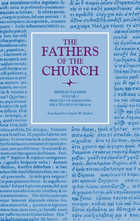 Iberian Fathers, Volume 2
Braulio of Saragossa
Catholic University of America Press, 1969 In this second volume of translations from the Iberian Fathers appear the works of two seventh-century writers. From the first of these, bishop Braulio of Saragossa, a figure in Visigothic literature second only to St. Isidore of Seville, comes an extensive collection of letters. These are variously addressed to Isidore himself, to other ecclesiastics, to Pope Honorius, and to King Receswinth; friends and relatives were the recipients of seven letters of consolation. Braulio's letters are joined by the Life of a near contemporary, St. Emilian, and by a valuable list of the writings of Isidore, under whom Braulio studied. Fructuousus of Braga is represented by two monastic rules. The first of these was composed for Compludo, a foundation made by Fructousus himself; the other rule is a general or common one. Two other writings dealing with monastic practice accompany these rules, together with a letter to King Receswinth.
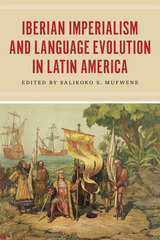 Iberian Imperialism and Language Evolution in Latin America
Edited by Salikoko S. Mufwene
University of Chicago Press, 2014 As rich as the development of the Spanish and Portuguese languages has been in Latin America, no single book has attempted to chart their complex history. Gathering essays by sociohistorical linguists working across the region, Salikoko S. Mufwene does just that in this book. Exploring the many different contact points between Iberian colonialism and indigenous cultures, the contributors identify the crucial parameters of language evolution that have led to today’s state of linguistic diversity in Latin America.
The essays approach language development through an ecological lens, exploring the effects of politics, economics, cultural contact, and natural resources on the indigenization of Spanish and Portuguese in a variety of local settings. They show how languages adapt to new environments, peoples, and practices, and the ramifications of this for the spread of colonial languages, the loss or survival of indigenous ones, and the way hybrid vernaculars get situated in larger political and cultural forces. The result is a sophisticated look at language as a natural phenomenon, one that meets a host of influences with remarkable plasticity.
The Iberian Peninsula between 300 and 850: An Archaeological Perspective
Javier Martínez Jiménez, Isaac Sastre de Diego, and Carlos Tejerizo García
Amsterdam University Press, 2018 The vast transformation of the Roman world at the end of antiquity has been a subject of broad scholarly interest for decades, but until now no book has focused specifically on the Iberian Peninsula in the period as seen through an archaeological lens. Given the sparse documentary evidence available, archaeology holds the key to a richer understanding of the developments of the period, and this book addresses a number of issues that arise from analysis of the available material culture, including questions of the process of Christianisation and Islamisation, continuity and abandonment of Roman urban patterns and forms, the end of villas and the growth of villages, and the adaptation of the population and the elites to the changing political circumstances.
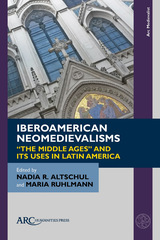 Iberoamerican Neomedievalisms: “The Middle Ages” and Its Uses in Latin America
Nadia R. Altschul
Arc Humanities Press, 2023
This is the first volume fully dedicated to Iberoamerican neomedievalisms. It examines “the Middle Ages” and its uses in Iberoamerica: the Spanish and Portuguese American postcolonies. It is an especially timely topic as scholars in neomedievalism studies become increasingly conscious that the field has different trajectories outside Europe and beyond the English-speaking world.
The collection provides needed alternatives to the by-now standardized understanding of neomedievalism as allied to nationalism, nostalgia, xenophobia, origin stories, elitism, and white Christian identity. It dislocates the field from its established trends and finds generative, yet unexplored examples of neomedievalism: political, religious, literary, and gendered. The volume will be of interest to established scholars of neomedievalism studies, to scholars of Latin America, and to the new and growing generation of students and colleagues interested in truly global neomedievalist studies.
Iberville's Gulf Journals
Pierre Le Moyne d'Iberville, translated by Richebourg Gaillard McWilliams
University of Alabama Press, 1991 Europe's expansion into the New World during the 16th, 17th, and 18th centuries was a story of power alignment and cultural transmission as well as dramatic individual effort. Spain had her conquistadores, France her coureurs de bois, and England her sea dogs. Isolated from the authority of home governments, tempted by the abundance of gold, fur, and fish in the New World, these adventurers so vital to national policies of expansion developed their own personal creeds of conquest and colonization. Their individual exploits not only represent a humanistic theme essential in Europe's movement westward but heighten the analyses of cultural institutions of the era. It is within such a multidisciplinary light that one can experience the Gulf Coast adventures of Pierre LeMoyne d'Iberville.
Ibn Arabi's Small Death
Mohammed Hasan AlwanTranslated by William M. Hutchins
University of Texas Press, 2022 Ibn Arabi’s Small Death is a sweeping and inventive work of historical fiction that chronicles the life of the great Sufi master and philosopher Ibn Arabi. Known in the West as “Rumi’s teacher,” he was a poet and mystic who proclaimed that love was his religion. Born in twelfth-century Spain during the Golden Age of Islam, Ibn Arabi traveled thousands of miles from Andalusia to distant Azerbaijan, passing through Morocco, Egypt, the Hijaz, Syria, Iraq, and Turkey on a journey of discovery both physical and spiritual. Witness to the wonders and cruelties of his age, exposed to the political rule of four empires, Ibn Arabi wrote masterworks on mysticism that profoundly influenced the world. Alwan’s fictionalized first-person narrative, written from the perspective of Ibn Arabi himself, breathes vivid life into a celebrated and polarizing figure.
 Ibn Khaldun: An Essay in Reinterpretation
Aziz Al-Azmeh
Central European University Press, 2003 Since its publication in 1981, this book has established itself as the major new interpretation of the historical concept of Ibn Khaldûn, the great figure of Arab-Islamic letters and of historical thought overall--a figure generally thought to be on a par with Thucydides, Vico, Herder and others of similar stature. The author has eschewed the ahistorical interpretations to which Ibn Khaldûn has normally been subjected, both by authors who have sought unduly to modernise his thought, and by those who sought to freeze it in stereotypical models of Islamic philosophy. Ibn Khaldûn is not only a true historical source of his time; he is also taken as the unchallenged sociological and cultural interpreter of medieval North Africa and much of medieval and modern Arab-Islamic culture as well. The validity of his discourse is considered to be so universal as to confer upon his ideas the status of progenitor--or, at least, anticipator--of a great variety of modern ideas.
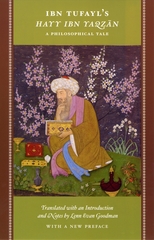 Ibn Tufayl's Hayy Ibn Yaqzan: A Philosophical Tale
Ibn Tufayl
University of Chicago Press, 2009 The Arabic philosophical fable Hayy Ibn Yaqzan is a classic of medieval Islamic philosophy. Ibn Tufayl (d. 1185), the Andalusian philosopher, tells of a child raised by a doe on an equatorial island who grows up to discover the truth about the world and his own place in it, unaided—but also unimpeded—by society, language, or tradition. Hayy’s discoveries about God, nature, and man challenge the values of the culture in which the tale was written as well as those of every contemporary society. Goodman’s commentary places Hayy Ibn Yaqzan in its historical and philosophical context. The volume features a new preface and index, and an updated bibliography. “One of the most remarkable books of the Middle Ages.”—Times Literary Supplement “An enchanting and puzzling story. . . . The book transcends all historical and cultural environments to settle upon the questions of human life that perpetually intrigue men.”—Middle East Journal “Goodman has done a service to the modern English reader by providing a readable translation of a philosophically significant allegory.”—Philosophy East and West “Add[s] bright new pieces to an Islamic mosaic whose general shape is already known.”—American Historical Review
 Ibsen’s Drama: Author to Audience
Einar Haugen
University of Minnesota Press, 1979
Ibsen's Drama was first published in 1979. Minnesota Archive Editions uses digital technology to make long-unavailable books once again accessible, and are published unaltered from the original University of Minnesota Press editions.
"A dramatist for all seasons" Einar Haugen calls Henrik Ibsen in this series of lectures given in honor of the 150th anniversary of the Norwegian playwright's birth. Using a modified version of the communications model developed by linguist Roman Jakobson, Haugen provides a readable, succinct analysis of Ibsen's thinking and dramaturgy. He examines the ways in which Ibsen the author communicated with his nineteenth-century audience and is able, still, to move and inform playgoers today.
Haugen brings to this work a lifetime of familiarity with Ibsen in Norwegian and in translation, and he draws upon his own experience as a theatergoer and as an observer of student and audience reaction to the plays. Ibsen's Drama will bring pleasure and a deeper understanding of the playwright to students and playgoers alike.
Einar Haugen is Victor S. Thomas Professor of Scandinavian and Linguistics, emeritus, at Harvard University. He is author, editor, or translator of many books and articles in linguistics, literature, and immigrant history, notably The Norwegian Language in America (1953), The Scandinavian Languages (1976), and Land of the Free (1978).
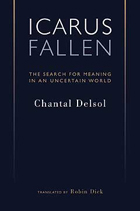 Icarus Fallen: The Search for Meaning in an Uncertain World
Chantal Delsol
Intercollegiate Studies Institute, 2003
It would be difficult to find a more perceptive description of Western man and the world he now inhabits than that provided by Chantal Delsol in Icarus Fallen: The Search for Meaning in an Uncertain World. With style and lucidity, Delsol likens contemporary Western man to the mythical figure Icarus, fallen back to earth after trying to reach the sun, alive but badly shaken and confused. During the twentieth century, Delsol argues, man flew too closely to the sun of utopian ideology. Having been burned, he is now groping for a way to orient himself. But the ideas he once held so dear—inevitable progress, the possibility of limitless social and self-transformation—are no longer believable, and he has, for the most part, long since rejected the religious tradition that might now have provided an anchor.
Delsol's portrait is engrossing. She explains how we have come simultaneously to embrace the "good" but reject the "true"; how we have sacralized rights and democracy; and how we have lost our sense of the tragic and embraced the idea of "zero risk." Already a well-known political thinker in her native France, this is Delsol's first book to appear in English. Icarus Fallen should establish her as one of the most insightful social and cultural writers working on either side of the Atlantic.
"This is simply the best book about the problems of modern man since Christopher Lasch's Culture of Narcissism. It is so crammed with truth and insight that, as someone once said of Chesterton, every line deserves a review."
—The American Conservative
"An extensive evaluation of the pitfalls of modern times and the strict limits on human virtues, Icarus Fallen, is strongly recommended reading for students of 20th Century Philosophy, Politics, and History."
—Wisconsin Bookwatch
Icastes: Marsilio Ficino's Interpretation of Plato's Sophist
Michael J. B. Allen
Arizona Center for Medieval and Renaissance Studies, 2016 New 2016 paperback edition of the original 1989 printing (out-of-print). Michael Allen's latest work on the profoundly influential Florentine thinker of the fifteenth century, Marsilio Ficino, will be welcomed by philosophers, literary scholars, and historians of the Renaissance, as well as by classicists. Ficino was responsible for inaugurating, shaping, and disseminating the wide-ranging philosophico-cultural movement known as Renaissance Platonism, and his views on the Sophist, which he saw as Plato's preeminent ontological dialogue, are of signal interest. This dialogue also served Ficino as a vehicle for exploring a number of other humanist, philosophical, and magical preoccupations, including the theme of man the artist and creator.
 ICD Connection: Living with an Implantable Cardioverter Defibrillator: A Collection of Patient & Family Stories
Edited by Helen McFarland, RN
Michigan Publishing, 2012 Ten ICD recipients and family members share, in their own words, their unique journey of living with an implantable cardioverter defibrillator (ICD), cardiac arrhythmia, and for some, sudden cardiac arrest. These personal stories represent a diverse collection of experiences from many perspectives such as age, gender, culture, and diagnoses. These ten authors offer advice, encouragement, and hope to others living with similar experiences. The book also includes educational information and resources regarding ICD’s and advice from a clinical psychologist who specializes in helping ICD recipients and family members with emotional and psychological issues related to ICD implantation and cardiac arrhythmia. The book is an educational and support resource for anyone who has been touched by cardiac illness or ICD implantation. It also serves well for healthcare providers as it offers insight and understanding into the patients and families perspective after ICD implantation.
ICD Connection: Living with an Implantable Cardioverter Defibrillator: A Collection of Stories from Women & Men
Edited by Helen McFarland, RN
Michigan Publishing, 2014 The book includes 13 first-hand accounts from women and men who are living life with an implantable cardioverter defibrillator (ICD). The book examines similarities and unique differences women and men face during diverse life stages with an ICD and cardiac disease diagnosis. General information about ICD’s is included along with expert advice from well-published doctors in the field of anxiety, fear, and depression after ICD implantation and ICD shock.
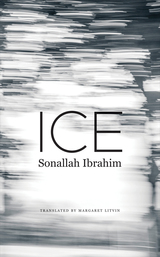 Ice
Sonallah Ibrahim
Seagull Books, 2019 The year is 1973. An Egyptian historian, Dr. Shukri, pursues a year of non-degree graduate studies in Moscow, the presumed heart of the socialist utopia. Through his eyes, the reader receives a guided tour of the sordid stagnation of Brezhnev-era Soviet life: intra-Soviet ethnic tensions; Russian retirees unable to afford a tin of meat; a trio of drunks splitting a bottle of vodka on the sidewalk; a Kirgiz roommate who brings his Russian girlfriend to live in his four-person dormitory room; black-marketeering Arab embassy officials; liberated but insecure Russian women; and Arab students’ debates about the geographically distant October 1973 War. Shukri records all this in the same numbly factual style familiar to fans of Sonallah Ibrahim’s That Smell, punctuating it with the only redeeming sources of beauty available: classical music LPs, newly acquired Russian vocabulary, achingly beautiful women, and strong Georgian tea.
Based on Ibrahim’s own experience studying at the All-Russian Institute of Cinematography in Moscow from 1971 to 1973, Ice offers a powerful exploration of Arab confusion, Soviet dysfunction, and the fragility of leftist revolutionary ideals.
Ice Age Forensics: Reconstructing the Death of a Wooly Bison
Dale Guthrie
University of Chicago Press, 2013 Frozen mammals of the Ice Age, preserved for millennia in the tundra, have been a source of fascination and mystery since their first discovery over two centuries ago. The 1979 find of a frozen, extinct steppe bison in an Alaskan gold mine allowed paleontologist Dale Guthrie to undertake the first scientific excavation of an Ice Age mummy in North America and to test theories about these enigmatic frozen fauna. In this brilliant remaking of the death of a wooly bison over 36,000 years ago, we’re given a glimpse of what life was like during the Pleistocene Epoch. From torn fragments and patches of deep-frozen skin and insights gleaned from studies of Montana bison, African lions, and Iberian cave art, Ice Age Forensics presents the story of the huge carcass Guthrie calls “Blue Babe”—and the excitement surrounding its reconstruction.
Ice Age Hunters of the Rockies
Dennis J. Stanford
University Press of Colorado, 1992 Ice Age Hunters of the Rockies explores the many questions that still surround the Pleistocene cultures of 12,000 years ago and the adaptations of these early civilizations to the last great ice age, covering issues such as the time of arrival of the first Americans, adaptation to various environments, and the use by early people of high-altitude sites.
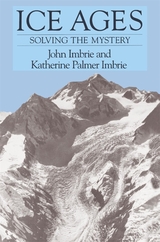 Ice Ages: Solving the Mystery
John Imbrie and Katherine Palmer Imbrie
Harvard University Press, 1986 This book tells the exciting story of the ice ages—what they were like, why they occurred, and when the next one is due. The solution to the ice age mystery originated when the National Science Foundation organized the CLIMAP project to study changes in the earth’s climate over the past 700,000 years. One of the goals was to produce a map of the earth during the last ice age. Scientists examined cores of sediment from the Indian Ocean bed and deciphered a continuous history for the past 500,000 years. Their work ultimately confirmed the theory that the earth’s irregular orbital motions account for the bizarre climatic changes which bring on ice ages.
This is a tale of scientific discovery and the colorful people who participated: Louis Agassiz, the young Swiss naturalist whose geological studies first convinced scientists that the earth has recently passed through an ice age; the Reverend William Buckland, an eccentric but respected Oxford professor who fought so hard against the ice-age theory before accepting it; James Croll, a Scots mechanic who educated himself as a scientist and first formulated the astronomic theory of ice ages; Milutin Milankovitch, the Serbian mathematician who gave the astronomic theory its firm quantitative foundation; and the many other astronomers, geochemists, geologists, paleontologists, and geophysicists who have been engaged for nearly a century and a half in the pressing search for a solution to the ice-age mystery.
The Ice Bucket Challenge: Pete Frates and the Fight against ALS
Casey Sherman and Dave Wedge
University Press of New England, 2017 While everyone knows of the Ice Bucket Challenge, the viral craze that swept the nation in summer 2014, too few know the truly inspirational story behind it. Pete Frates was a man at war with his own body. A man whose love for others was unshakable. A man who refused to fight alone, and in so doing mobilized a global army to combat one of the most devastating diseases on earth: ALS, or Lou Gehrig’s disease. When disease crippled Frates, the former Boston College baseball star turned tragedy into inspiration. Pete’s story is a testament to the power of love, the steadfastness of family, the generosity of strangers, and the compassion of crowds. Half of the authors’ proceeds will go to the Frates family.
The Ice Cave: A Woman’s Adventures from the Mojave to the Antarctic
Lucy Jane Bledsoe
University of Wisconsin Press, 2006 For Lucy Jane Bledsoe, wilderness had always been a source of peace. But during one disastrous solo trip in the wintry High Sierra she came face to face with a crisis: the wilderness no longer felt like home. The Ice Cave recounts Bledsoe’s wilderness journeys as she recovers her connection with the wild and discovers the meanings of fear and grace.
These are Bledsoe’s gripping tales of fending off wolves in Alaska, encountering UFOs in the Colorado Desert, and searching for mountain lions in Berkeley. Her memorable story “The Breath of Seals” takes readers to Antarctica, the wildest continent on earth, where she camped out with geologists, biologists, and astrophysicists. These fresh and deeply personal narratives remind us what it means to be simply one member of one species, trying to find food and shelter—and moments of grace—on our planet.
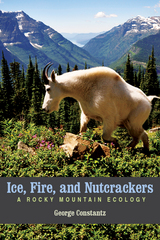 Ice, Fire, and Nutcrackers: A Rocky Mountain Ecology
George Constantz
University of Utah Press, 2014 Why do quaking aspens grow in prominent clumps rather than randomly scattered across the landscape? Why and how does a rufous hummingbird drop its metabolism to one-hundredth of its normal rate? Why do bull elk grow those enormous antlers? Using his experience as a biologist and ecologist, George Constantz illuminates these remarkable slices of mountain life in plain but engaging language. Whether it sketches conflict or cooperation, surprise or familiarity, each story resolves when interpreted through the theory of evolution by natural selection.
These provocative accounts of birds, insects, rodents, predators, trees, and flowers are sure to stir the reader’s curiosity. Who wouldn’t be intrigued by a rattlesnake’s ability to hunt in total darkness by detecting the infrared radiation emitted by a mouse? Or how white-tailed ptarmigan thrive in their high, treeless alpine environments -- even through the winter? The narratives, often brought home with a counterintuitive twist, invite readers to make new connections and broaden perspectives of a favorite outdoor place.
Ice Floe II: International Poetry of the Far North
Edited by Shannon Gramse and Sarah Kirk
University of Alaska Press, 2011 The long-awaited second volume of the newly revived Ice Floe series, Ice Floe II features new and exciting works of poetry from a vibrant and diverse group of writers from Alaska, Canada, Russia, Sweden, Iceland, and beyond. All work is presented here in both its original language and in English translation. With contributors that include former Alaska poet laureate Tom Sexton, Riina Katajavuori, Yuri Vaella, Gunnar Randversson, and dozens of other established and emerging poets, this wonderful collection of voices from the northern latitudes will be a great read for all lovers of poetry and international literature.
Ice Floe III
Edited by Shannon Gramse and Sarah Kirk
University of Alaska Press, 2012
The third volume of the revived Ice Floe series, Ice Floe III features new and exciting works of poetry by authors from Alaska, Canada, Iceland, the Faroe Islands, Norway, Sweden, Finland, and Russia. All work is presented in both its original language and in English translation. The contributors—Nancy Lord, Tom Sexton, Eira Stenberg, and Riina Katajavuori, among others—include established and emerging poets. This dynamic and vibrant collection of voices from the northern latitudes will be a great read for all poetry enthusiasts and devoted readers of international literature.
Ice Floe: New & Selected Poems
Edited by Shannon Gramse and Sarah Kirk
University of Alaska Press, 2010 Ice Floe, the celebrated and award-winning journal of circumpolar poetry, is here reborn as an annual book series. This first volume features the best of the journal's first seven years, along with evocative new poetry from Alaska, Canada, Iceland, Norway, Sweden, Finland, and Russia. All work is presented in both its original language and in English translation. With contributors including former Alaska poet laureate John Haines, Gunnar Harding, Robert Bly, Lennart Sjögren, and dozens of other established and emerging poets, this wonderful collection of voices from the northern latitudes is a great read for all lovers of poetry and international literature.
 Ice Geographies: The Colonial Politics of Race and Indigeneity in the Arctic
Jen Rose Smith
Duke University Press, 2025 Ice animates the look and feel of climate change. It is melting faster than ever before, causing social upheaval among northern coastal communities and disrupting a more southern, temperate world as sea levels rise. Economic, academic, and activist stakeholders are increasingly focused on the unsettling potential of ice as they plan for a future shaped by rapid transformation. Yet, in Ice Geographies, Jen Rose Smith demonstrates that ice has always been at the center of making sense of the world. Ice as homeland is often at the heart of Arctic and sub-Arctic ontologies, cosmologies, and Native politics. Reflections on ice have also long been a constitutive element of Western political thought, but it often privileges a pristine or empty “nature” stripped of power relations. Smith centers ice to study race and indigeneity by investigating ice relations as sites and sources of analysis that are bound up with colonial and racial formations as well as ice geographies beyond those formations. Smith asks, How is ice a racialized geography and imaginary, and how does it also exceed those frameworks?
 Ice Hours
Marion Starling Boyer
Michigan State University Press, 2023 Ice Hours is a suite of poems set in majestic and severe Antarctica, chronicling the nearly forgotten story of the Ross Sea party. Weaving historical and scientific research into lilting verse, Marion Starling Boyer follows the adventurers who sailed on the Aurora at the beginning of World War I to support Sir Ernest Shackleton’s 1914–1917 Imperial Trans-Antarctic Expedition. These poems reveal the characters of the explorers and the conflicts they faced during the two years they labored to lay a chain of supply depots across the ice, unaware that Shackleton would never come because his ship, the Endurance, sank on the opposite side of the continent. The Ross Sea men battled frozen wastelands, scurvy, snow-blindness, starvation, hypothermia, and frostbite while their ship, the Aurora, was ice-trapped, marooning them without vital equipment, clothing, fuel, and food. Through lyric and formal poetic forms, Ice Hours brings to life the close of a heroic period interwoven with the brooding voice of the Antarctic continent, evoking themes of what occurs when humanity engages with the sublime.
 Ice ’n’ Go: Score in Sports and Life
Jenny Moshak with Debby Schriver
University of Tennessee Press, 2013
The 1972 passage of Title IX, the federal law that prohibits sex discrimination in education, was a gamechanger for women and girls in athletics. in the forty years since the law was enacted, participation in sports—especially of girls and women—has grown dramatically. With that growth have come challenges. in Ice-n-Go: A Perspective on Sports and Life, Jenny Moshak, celebrated trainer of the legendary lady Vols basketball team and associate athletic director for sports medicine at the university of tennessee, Knoxville, reflects on the role of sports in society and addresses the high stakes and costs of winning in sports today.
Ice-n-Go is a culmination of the breadth of knowledge and unique insight from Moshak’s more than twenty-five years of work in major college sports. in this highly readable new book, she covers social issues, medical concerns, motiva- tional techniques, gender roles and expectations, the impact of sports on our children, and how the body works, heals, and recovers. though she writes on serious subjects in a serious way, Moshak’s tone is always upbeat and positive with surprisingly simple strategies for improving the athletic experience for all, especially kids.
An outstanding athlete herself, she shares lessons learned on her own demanding coast-to-coast bicycle ride across the united states. in sharing her stories, sound advice and fresh ideas, Moshak seeks to do for us what she has always done for the players in her care: to help protect, nurture, and grow the athlete who is in each one of us.
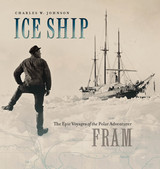 Ice Ship: The Epic Voyages of the Polar Adventurer Fram
Charles W. Johnson
University Press of New England, 2014 In the golden age of polar exploration (from the mid-1800s to the early 1900s), many an expedition set out to answer the big question—was the Arctic a continent, an open ocean beyond a barrier of ice, or an ocean covered with ice? No one knew, for the ice had kept its secret well; ships trying to penetrate it all failed, often catastrophically. Norway’s charismatic scientist-explorer Fridtjof Nansen, convinced that it was a frozen ocean, intended to prove it in a novel if risky way: by building a ship capable of withstanding the ice, joining others on an expedition, then drifting wherever it took them, on a relentless one-way journey into discovery and fame . . . or oblivion. Ice Ship is the story of that extraordinary ship, the Fram, from conception to construction, through twenty years of three epic expeditions, to its final resting place as a museum. It is also the story of the extraordinary men who steered the Fram over the course of 84,000 miles: on a three-year, ice-bound drift, finding out what the Arctic really was; in a remarkable four-year exploration of unmapped lands in the vast Canadian Arctic; and on a two–year voyage to Antarctica, where another famous Norwegian explorer, Roald Amundsen, claimed the South Pole. Ice Ship will appeal to all those fascinated with polar exploration, maritime adventure, and wooden ships, and will captivate readers of such books as The Endurance, In the Heart of the Sea, and The Last Place on Earth. With more than 100 original photographs, the book brings the Fram to life and light.
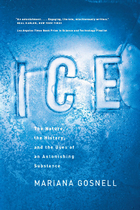 Ice: The Nature, the History, and the Uses of an Astonishing Substance
Mariana Gosnell
University of Chicago Press, 2007 More brittle than glass, at times stronger than steel, at other times flowing like molasses, ice covers 10 percent of the earth’s land and 7 percent of its oceans. Mariana Gosnell here explores the history and uses of ice in all its complexity, grandeur, and significance. From the freezing of Pleasant Lake in New Hampshire to the breakup of a Vermont river at the onset of spring, from the frozen Antarctic landscape that emperor penguins inhabit to the cold, watery route bowhead whales take between Arctic ice floes, Gosnell examines icebergs, icicles, and frostbite; sea ice and permafrost; ice on Mars and in the rings of Saturn; and several new forms of ice developed in labs. Arecord of the scientific surprises, cultural magnitude, and everyday uses of frozen water, Ice is a sparkling illumination of a substance whose ebbs and flows over time have helped form the world we live in. “Gosnell travels to the ends of the earth, into the clouds and under the frozen sea to conduct her investigations . . . By the time you finish this remarkable book, you’ll never think about freezing and melting in quite the same way.”—New York Times Book Review “To read Ice is to discover just how astonishing it is and how necessary.”—San Francisco Chronicle “A bright, curious, omnidirectional tour that will entrance nature readers.”—Booklist “An encyclopedic work with surprises on every page . . . . Illustrated with images of ice castles, skaters, and bubble-filled frozen sculpture, Gosnell’s book breathes life into the crystals dubbed ‘glorious spangles’ by Henry David Thoreau.”—Discover
 Iceland: The First New Society
Richard F. Tomasson
University of Minnesota Press, 1980 Iceland was first published in 1980. Minnesota Archive Editions uses digital technology to make long-unavailable books once again accessible, and are published unaltered from the original University of Minnesota Press editions. "Iceland, as described by Tomasson, has a fascinating, often contradictory culture," writes Seymour Martin Lipset in his forward to this book, the first sociological account in English of modern Icelandic society and the forces that have shaped it. Richard F. Tomasson argues that Iceland can best be understood as an example of "a new society"—the first such pioneer community to be founded in historical times. To the author the most significant influences upon Icelandic culture and social structure are the continuities that have persisted in this island society for eleven centuries, since its origins as an isolated Viking colony. Tomasson traces the ways in which Icelandic culture developed out of the medieval pre- Christian society—in its language, relations between the sexes, egalitarianism, and the high frequency of illegitimate births. He also points out areas of contradiction and discontinuity, noting that Iceland has been transformed in the twentieth century by modernization of the society and international influences upon the culture. Among the topics Tomasson examines are the Icelanders' involvement in their history and national literary tradition; their social, political, and economic life; the high level of literacy; the pervasive tolerance of Icelanders in moral and religious matters; their values; and the use of alcohol. Readers interested in the Scandinavian countries and in the comparative study of societies will find Iceland a useful analysis of a significant and little known national culture.
Icelandic Folklore and the Cultural Memory of Religious Change
Eric Shane Bryan
Arc Humanities Press, 2021 Iceland’s uncommon proclivity towards storytelling, its robust tradition of medieval manuscripts, and the “re-oralization” of those narratives after the medieval period, create a body of folktales and legends that have encoded a hidden account of how orthodox and heterodox beliefs (sometimes pagan in origin) intermingled as Christianity, and later Reformation, spread through the North. This volume unlocks that secret story by placing Icelandic folktales in a context of religious doctrine, social history, and Old Norse sagas and poetry. The analysis herein reveals a cultural memory of belief.
Iceman: Uncovering the Life and Times of a Prehistoric Man Found in an Alpine Glacier
Brenda Fowler
University of Chicago Press, 2001 On September 19, 1991 a couple hiking along an Alpine ridge stumbled upon a frozen, intact corpse melting out of a glacier. He was dubbed "the Iceman," and his discovery—along with the realization that he was actually 5,000 years old—set off a whirlwind of political, scientific, and media activity that made him an overnight sensation. In this remarkable and dramatic book, Brenda Fowler takes readers through the bizarre odyssey that began in the Stone Age and continued for years after the Iceman was unearthed.
 Ice-Out
Mary Casanova
University of Minnesota Press, 2016 Walking on thin ice: on Rainy Lake, in the northern reaches of Minnesota, it’s more than a saying. And for Owen Jensen, nineteen and suddenly responsible for keeping his mother and five brothers alive, the ice is thin indeed. Ice-Out returns to the frigid and often brutal Prohibition-era borderland of Mary Casanova’s beloved novel Frozen, and to the characters who made it a favorite among readers of all ages. Owen, smitten with Frozen’s Sadie Rose, is struggling to make something of himself at a time when no one seems to hold the moral high ground. Bootlegging is rife, corruption is rampant, and lumber barons run roughshod over the people and the land. As hard as things seem when his father dies, stranding his impoverished family, they get considerably tougher—and more complicated—when Owen gets caught up in the suspicious deaths of a sheriff and deputy on the border. Inspired by real events in early 1920s Minnesota, and by Mary Casanova’s own family history, Ice-Out is at once a story of young romance against terrible odds and true grit on the border between license and responsibility, rich and poor, and right and wrong in early twentieth-century America.
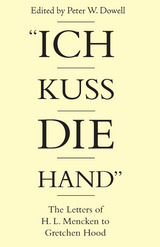 "Ich Kuss Die Hand": The Letters of H. L. Mencken To Gretchen Hood
H. L. Mencken
University of Alabama Press, 1986 What started as a correspondence between an illustrious personage and an ardent fan developed into a friendship between two individuals with congenial temperaments, interests, and tastes
“Ich Kuss Die Hand”: The Letters of H. L. Mencken to Gretchen Hood relates an episode in Mencken's life that has received only passing mention from his biographers. Gretchen Hood's acquaintance with the journalistic life of Washington formed a bond with Mencken, who thought of himself, first and foremost, as an inveterate newspaperman (they playfully entertained the idea of starting their own Washington newspaper), and she had a ready appreciation for his performances as a connoisseur of the Washington political spectacle. Mencken, the amateur musician and music buff, respected her talent and professional background.
His letters indicate that he found in her an intelligent, witty, and charming respondent to his characteristic traits of personality and style. She both flattered his ego and challenged him to exhibit his celebrated manner at its best. On her part, Hood was not simply awestruck by Mencken's attentions but met them with her independent verve. “Nothing scared me,” she later said of her attitude; “ready to take on all comers.” Mencken liked to refer to her as “a licensed outlaw,” a designation that captures his impression of her and describes as well the fashionable unconventionality, which fueled the Mencken vogue.
Mencken wrote Hood over two hundred letters, and she must have written him about the same number. For much of the time they corresponded, they exchanged several letters every month, sometimes as many as four or five a week. As their communications blossomed into a four-year friendship, personal meetings soon supplemented the flow of letters.
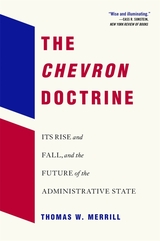 The Chevron Doctrine: Its Rise and Fall, and the Future of the Administrative State
Thomas W. Merrill
Harvard University Press, 2022 “Wise and illuminating…Merrill’s treatment of the rise of Chevron, and its various twists and turns over the decades, is keenly insightful.” —Cass R. Sunstein, New York Review of Books
“Merrill is one of the brightest and best scholars of administrative law in his generation. This book...is must-reading for any citizen who has an interest in the constitutionality of the administrative state.” —Steven G. Calabresi, Northwestern University Pritzker School of Law
“A model of how to conduct rigorous, level-headed, and fair-minded analysis of a subject that has generated enormous legal controversy. There is no more judicious mind among American legal scholars than Thomas Merrill’s.”—Nicholas Parrillo, Yale Law School
“A must-read for practicing or prospective administrative lawyers. They, as well as a broader audience, will find much good sense in the author’s judicious treatment of perennial questions of lawful government.”—Michael S. Greve, Claremont Review of Books
The Constitution makes Congress the principal federal lawmaker. But for a variety of reasons, including partisan gridlock, Congress increasingly fails to keep up with the challenges facing our society. Power has shifted to the executive branch agencies that interpret laws and to the courts that review their interpretations.
Since the Supreme Court’s 1984 decision in Chevron v. Natural Resources Defense Council, this judicial review has been highly deferential: courts must uphold agency interpretations of unclear laws so long as these are “reasonable.” But the Chevron doctrine faces backlash from constitutional scholars and, now, from Supreme Court justices who insist that courts, not administrative agencies, have the authority to say what the law is. Critics of the administrative state charge that Chevron deference enables unaccountable bureaucratic power. In this groundbreaking book, Thomas Merrill reviews the history and consequences of the Chevron doctrine and suggests a way forward.
 iChina: The Rise of the Individual in Modern Chinese Society
Edited by Mette Halskov Hansen and Rune Svarverud
National University of Singapore Press, 2010 In spite of the intense preoccupation with individual and self in modern Western thought, the social sciences have tended to focus on groups and collectives and downplay the individual. This implicit view has also coloured the study of social life in China where both Confucian ethics and Communist policies have shaped collective structures with little room for individual agency and choice. What is actually happening, however, is a growing individualization of China – not only changing perceptions of the individual but also rising expectations for individual freedom, choice and individuality. The individual has also become a basic social category in China, and a development has begun that permeates all areas of social, economic and political life. How this process evolves in a state and society lacking two of the defining characteristics of European individualization – a culturally embedded democracy and a welfare system – is one of the questions that the volume explores. A strength of this volume is that its authors succeed in depicting the individualization process in conceptually acute and empirically sensitive terms, and as something with its own distinctively Chinese profile. That makes this book a ‘must read’ for all those wanting to understand present-day Chinese society, with all of its ambivalences, contingencies and contradictions.
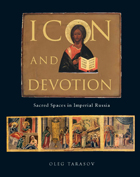 Icon and Devotion: Sacred Spaces in Imperial Russia
Oleg Tarasov
Reaktion Books, 2002 Icon and Devotion offers the first extensive presentation in English of the making and meaning of Russian icons. The craft of icon-making is set into the context of forms of worship that emerged in the Russian Orthodox Church in the mid-seventeenth century. Oleg Tarasov shows how icons have held a special place in Russian consciousness because they represented idealized images of Holy Russia. He also looks closely at how and why icons were made. Wonder-working saints and the leaders of such religious schisms as the Old Believers appear in these pages, which are illustrated in halftones with miniature paintings, lithographs and engravings never before published in the English-speaking world.
By tracing the artistic vocabulary, techniques and working methods of icon painters, Tarasov shows how icons have been integral to the history of Russian art, influenced by folk and mainstream currents alike. As well as articulating the specifically Russian piety they invoke, he analyzes the significance of icons in the cultural life of modern Russia in the context of popular prints and poster design.
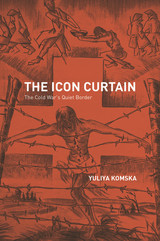 The Icon Curtain: The Cold War's Quiet Border
Yuliya Komska
University of Chicago Press, 2015 The Iron Curtain did not exist—at least not as we usually imagine it. Rather than a stark, unbroken line dividing East and West in Cold War Europe, the Iron Curtain was instead made up of distinct landscapes, many in the grip of divergent historical and cultural forces for decades, if not centuries. This book traces a genealogy of one such landscape—the woods between Czechoslovakia and West Germany—to debunk our misconceptions about the iconic partition.
Yuliya Komska transports readers to the western edge of the Bohemian Forest, one of Europe’s oldest borderlands, where in the 1950s civilians set out to shape the so-called prayer wall. A chain of new and repurposed pilgrimage sites, lookout towers, and monuments, the prayer wall placed two long-standing German obsessions, forest and border, at the heart of the century’s most protracted conflict. Komska illustrates how civilians used the prayer wall to engage with and contribute to the new political and religious landscape. In the process, she relates West Germany’s quiet sylvan periphery to the tragic pitch prevalent along the Iron Curtain’s better-known segments.
Steeped in archival research and rooted in nuanced interpretations of wide-ranging cultural artifacts, from vandalized religious images and tourist snapshots to poems and travelogues, The Icon Curtain pushes disciplinary boundaries and opens new perspectives on the study of borders and the Cold War alike.
 Icon Dresden: Baroque City, Air War Symbol, Political Token
Susanne Vees-Gulani
University of Michigan Press, 2026 Icon Dresden explores how memory and politics in Dresden after its 1945 bombing are deeply intertwined with the city’s urban history. It highlights the complex origins of Dresden’s reputation as an exclusively cultural center, focusing on urban planning, marketing, tourism, and the city’s visual archive since the 17th century. Based on this iconic status, a narrative of victimhood arose after its destruction that ignored responsibilities while highlighting the city’s innocence. Despite its origin in Nazi propaganda, this narrative influenced postwar political discourse in socialist and post-reunification Germany. Icon Dresden also provides insight into Dresden’s role under National Socialism and the GDR’s evasive response to this history. It reveals how the strong presence of far-right movements in the city today stems from multiple discourses formed over centuries and communicated from generation to generation.
Drawing on urban, heritage, and tourism studies, visual and memory studies, and environmental psychology, Icon Dresden examines Dresden’s history, identity, visual representations, and rebuilding decisions. It exposes the narratives that define its place in German and international memory and how, paradoxically, they support both Dresden’s current image as a symbol of peace and reconciliation and its backing of nativist and far-right movements.
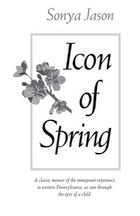 Icon Of Spring
Sonya Jason
University of Pittsburgh Press, 1993
A realistic but fond memoir of a girlhood lived in a coal camp, or “patch” in southwestern Pennsylvania during the Great Depression of the 1930s, Icon of Spring is also a coming-of-age story. It begins in 1932 when the narrator, the child of Carpatho-Rusyn immigrant parents, is seven years old. Her father is a miner, and work is scarce as the grip of the depression tightens. The jars of canned food on the storeroom shelf are dwindling, and the family fears eviction from their small company-owned house.
Icon of Spring recounts her childhood during the next seven years, as she grows to adolescence in a world that is protective within her family but shares the violence of the coal region. She is witness to accidental death in the mines, the murder of a coal and iron policeman, the muted struggle to unionize, and the itinerant beggars who appear at the back door.
Yet this is far from a grim book, for we see life in the patch through the eyes of the child. Warmed by the closeness she feels toward her parents, especially her mother, and her nine brothers and sisters, she knows the joy of one sister’s wedding and raucous reception, the mysterious Easter ritual of the Eastern Orthodox Liturgy, the fun of attending a medicine show, and the almost incandescent hope placed in the new president, Franklin D. Roosevelt. Her life is peopled by traveling peddlers, the priest of her church, a union organizer, and the town bachelors: Big John, Peg Leg Pete, and Shorty Steve.
Icon of Spring evokes life in a depression coal patch from a female perspective. A splendid memoir of childhood told with accuracy and warmth which is also rich in social history, it will appeal to general readers as well as students.
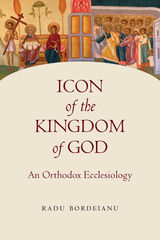 Icon of the Kingdom of God: An Orthodox Ecclesiology
Radu Bordeianu
Catholic University of America Press, 2023 What is the Church? Some would answer this question by studying the Scriptures, the history of the Church, and contemporary theologians, thus addressing the theological nature of the Church. Others would answer based on statistics, interviews, and personal observation, thus focusing on the experience of the Church. These theological and experiential perspectives are in tension, or at times even opposed. Whereas the first might speak about the local church as the diocese gathered in the Liturgy presided over by its bishop, the latter would describe the local church as the parish community celebrating the Liturgy together with the parish priest, never experiencing a sole liturgy that gathers an entire diocese around its bishop. Whereas a theologian might abstractly describe the Church as a reflection of the Trinity, a regular church-member might concretely experience the Church as a community that manifests the Kingdom of God in its outreach ministries. Radu Bordeianu attempts to bring these two perspectives together, starting from the concrete experience of the Church, engaging this experience with the theological tradition of the Church, extracting ecclesiological principles from this combined approach, and then highlighting concrete situations that reflect those standards or proposing correctives, when necessary.
Without pretending to be a complete Orthodox ecclesiology, Icon of the Kingdom of God addresses the most important topics related to the Church. It progresses according to one’s experience of the Church from baptism, to the family, parish, Liturgy, and priesthood, followed by analyses of synodality and nationality. Arguing that the Church is an icon of the Kingdom of God, this volume brings together the past theological heritage and the present experience of the Church while having three methodological characteristics: experiential, Kingdom-centered, and ecumenical.
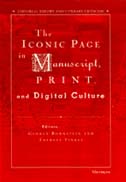 The Iconic Page in Manuscript, Print, and Digital Culture
George Bornstein and Theresa Tinkle, Editors
University of Michigan Press, 1998 Most readers think of a written work as producing its meaning through the words it contains. But what is the significance of the detailed and beautiful illuminations on a medieval manuscript? Of the deliberately chosen typefaces in a book of poems by Yeats? Of the design and layout of text in an electronic format? How does the material form of a work shape its understanding in a particular historical moment, in a particular culture?
The material features of texts as physical artifacts--their "bibliographic codes" --have over the last decade excited increasing interest in a variety of disciplines. The Iconic Page in Manuscript, Print, and Digital Culture gathers essays by an extraordinarily distinguished group of scholars to offer the most comprehensive examination of these issues yet, drawing on examples from literature, history, the fine arts, and philosophy.
Fittingly, the volume contains over two dozen illustrations that display the iconic features of the works analyzed--from Alfred the Great's Boethius through medieval manuscripts to the philosophy of C. S. Peirce and the dustjackets on works by F. Scott Fitzgerald and William Styron.
The Iconic Page in Manuscript, Print, and Digital Culture will be groundbreaking reading for scholars in a wide range of fields.
George Bornstein is C. A. Patrides Professor of English, University of Michigan. Theresa Tinkle is Associate Professor of English, University of Michigan.
 Iconic Spaces: The Dark Theology of Samuel Beckett's Drama
Sandra Wynands
University of Notre Dame Press, 2007
Iconic Spaces looks at Samuel Beckett's mature theatrical work as a displaced theology of the icon. Sandra Wynands rejects conventional existentialist or nihilist interpretations of Beckett's work, arguing instead that beneath the text, in the depths of language and being, Beckett creates an absolutely irreducible, transcendent space. She traces a nondual model of perception and experience through a selection of Beckett's art-critical and dramatic works, focusing in particular on four minimalist plays: Catastrophe, Not I, Quad, and Film.
Iconic Spaces makes an important contribution to scholars and students of literature, philosophy, theatre studies, and religion by giving them an exciting new way of reading and experiencing Beckett's work.
“This is an original, adventurous, and absorbing book. It deploys an acute understanding of contemporary philosophical writing in order to address the demands Beckett makes on his readers and spectators in nonreductive, affirmative fashion; and it also reinvigorates our understanding of Beckett’s relationship to religion and theology by exploring in some detail, and, arguably for the first time, the extent of Beckett’s engagement as a writer, not with positive religion, but with apophatic religious thought.” —Leslie Hill, University of Warwick
”In this remarkable and scrupulously argued book about Samuel Beckett, Sandra Wynands provides a compelling analysis of the postmodern experience of God’s absence. She does so partly by showing how atheism, rigorously deconstructed, can converge with the insights and strategies of negative theology. Sandra Wynands is daringly insightful about Beckett, while also situating his work within a set of historical and cultural parameters that are described with impressive learning and breadth of vision.” —Patrick Grant, University of Victoria
“Iconic Spaces is an impressive piece of work. In exploring the relationship between ‘negative theology’ and Samuel Beckett’s late work for the stage, Sandra Wynands makes an original and important contribution to Beckett studies and to modern drama and theatre studies more generally. Her discussion ranges widely across difficult and complex disciplinary, theoretical, philosophical, and critical materials with notable maturity and clarity, providing startlingly original insights on almost every page.” —Ric Knowles, University of Guelph
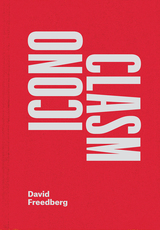 Iconoclasm
David Freedberg
University of Chicago Press, 2021 With new surges of activity from religious, political, and military extremists, the destruction of images has become increasingly relevant on a global scale. A founder of the study of early modern and contemporary iconoclasm, David Freedberg has addressed this topic for five decades. His work has brought this subject to a central place in art history, critical to the understanding not only of art but of all images in society. This volume collects the most significant of Freedberg’s texts on iconoclasm and censorship, bringing five key works back into print alongside new assessments of contemporary iconoclasm in places ranging from the Near and Middle East to the United States, as well as a fresh survey of the entire subject. The writings in this compact volume explore the dynamics and history of iconoclasm, from the furious battles over images in the Reformation to government repression in modern South Africa, the American culture wars of the early 1990s, and today’s cancel culture.
Freedberg combines fresh thinking with deep expertise to address the renewed significance of iconoclasm, its ideologies, and its impact. This volume also provides a supplement to Freedberg’s essay on idolatry and iconoclasm from his pathbreaking book, The Power of Images. Freedberg’s writings are of foundational importance to this discussion, and this volume will be a welcome resource for historians, museum professionals, international law specialists, preservationists, and students.
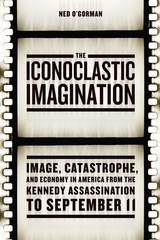 The Iconoclastic Imagination: Image, Catastrophe, and Economy in America from the Kennedy Assassination to September 11
Ned O'Gorman
University of Chicago Press, 2015 Bloody, fiery spectacles—the Challenger disaster, 9/11, JFK’s assassination—have given us moments of catastrophe that make it easy to answer the “where were you when” question and shape our ways of seeing what came before and after. Why are these spectacles so packed with meaning?
In The Iconoclastic Imagination, Ned O’Gorman approaches each of these moments as an image of icon-destruction that give us distinct ways to imagine social existence in American life. He argues that the Cold War gave rise to crises in political, aesthetic, and political-aesthetic representations. Locating all of these crises within a “neoliberal imaginary,” O’Gorman explains that since the Kennedy assassination, the most powerful way to see “America” has been in the destruction of representative American symbols or icons. This, in turn, has profound implications for a neoliberal economy, social philosophy, and public policy. Richly interwoven with philosophical, theological, and rhetorical traditions, the book offers a new foundation for a complex and innovative approach to studying Cold War America, political theory, and visual culture.
Iconology: Image, Text, Ideology
W. J. T. Mitchell
University of Chicago Press, 1986 "[Mitchell] undertakes to explore the nature of images by comparing them with words, or, more precisely, by looking at them from the viewpoint of verbal language. . . . The most lucid exposition of the subject I have ever read."—Rudolf Arnheim, Times Literary Supplement
Iconoscope: New and Selected Poems
Peter Oresick
University of Pittsburgh Press, 2015 Collected here are poems from Peter Oresick’s previous books, beginning with The Story of Glass (1977), and to them are added 36 new poems called Under the Carpathians. His work—known for working class and Catholic themes—probes labor and social history, post-World War II America, Eastern European identity, Eastern Rite Catholicism, and Russian icons and fine art and especially Pittsburgh-born pop art icon Andy Warhol.
 Icons
Robin Cormack
Harvard University Press, 2007 Byzantine and Russian Orthodox icons are perhaps the most enduring form of religious art ever developed—and one of the most mysterious. This book, featuring the painted panels made for churches and for prayer at home, provides an accessible guide to their story and power. Illustrated mostly with Cretan, Greek, and Russian examples from the British Museum, which houses Britain’s most important collection of icons, the book examines icons in the context of the history of Christianity, as well as within the perspective of art history.
Robin Cormack, a preeminent expert on the subject, explains how icons were made, framed, and displayed. He investigates their subject matter, showing how scenes can be identified, how the iconography developed over centuries, and what role portraiture plays in their imagery. Icons have not lost their power in much of the world, and Cormack considers their continuing use in our day—whether in a religious setting or as an inspiration to modern-day artists like Matisse.
A uniquely accessible and authoritative introduction to this distinctive art form, Icons defines its subject’s unusual place at the intersection of religion, Russian culture, and art history.
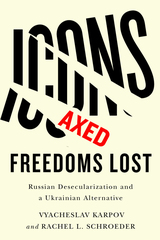 Icons Axed, Freedoms Lost: Russian Desecularization and a Ukrainian Alternative
Vyacheslav Karpov
Rutgers University Press, 2025 In Icons Axed, Freedoms Lost, Vyacheslav Karpov and Rachel L. Schroeder demonstrate how Russia went from persecuting believers to jailing critics of religion and why, in contrast, religious pluralism and tolerance have solidified in Ukraine. Offering a richly documented history of cultural and political struggles that surrounded desecularization—the resurgence of religion’s societal role—from the end of the USSR to the Russo-Ukrainian war, they show Russian critics of desecularization adhered to artistic provocations, from axing icons to “punk-prayers” in cathedrals, and how Orthodox activists, in turn, responded by vandalizing controversial exhibits and calling on the state to crush “the enemies of the Church.” Putin’s solidifying tyranny heard their calls and criminalized insults to religious feelings. Meanwhile, Ukraine adhered to its pluralistic legacies. Its churches refused to engage in Russian-style culture wars, sticking instead to forgiveness and forbearance. Icons Axed, Freedoms Lost offers original theoretical and methodological perspectives on desecularization applicable far beyond the cases of Russia and Ukraine.
|
|
